Conducting Observation/Inspection and Survey at Worksites
VerifiedAdded on 2021/04/17
|54
|14410
|98
AI Summary
This assignment involves conducting an observation, inspection, and survey at a worksite, specifically the PayaLebar Project constructing an 18-storey condominium. The student is required to identify hazards, determine who might be harmed and how, and assess the risk level. They must also take actions to manage the risks, including ensuring clear location details, making early appointments with site management, and using appropriate PPE. The assignment focuses on safety protocols and procedures for students visiting construction sites.
Contribute Materials
Your contribution can guide someone’s learning journey. Share your
documents today.

Running head: INFLUENCE OF SAFETY INSPECTION ON WORKPLACE
Influence of Safety Inspection on Work Place
Name of the Student
Name of the university
Author Note
Influence of Safety Inspection on Work Place
Name of the Student
Name of the university
Author Note
Secure Best Marks with AI Grader
Need help grading? Try our AI Grader for instant feedback on your assignments.
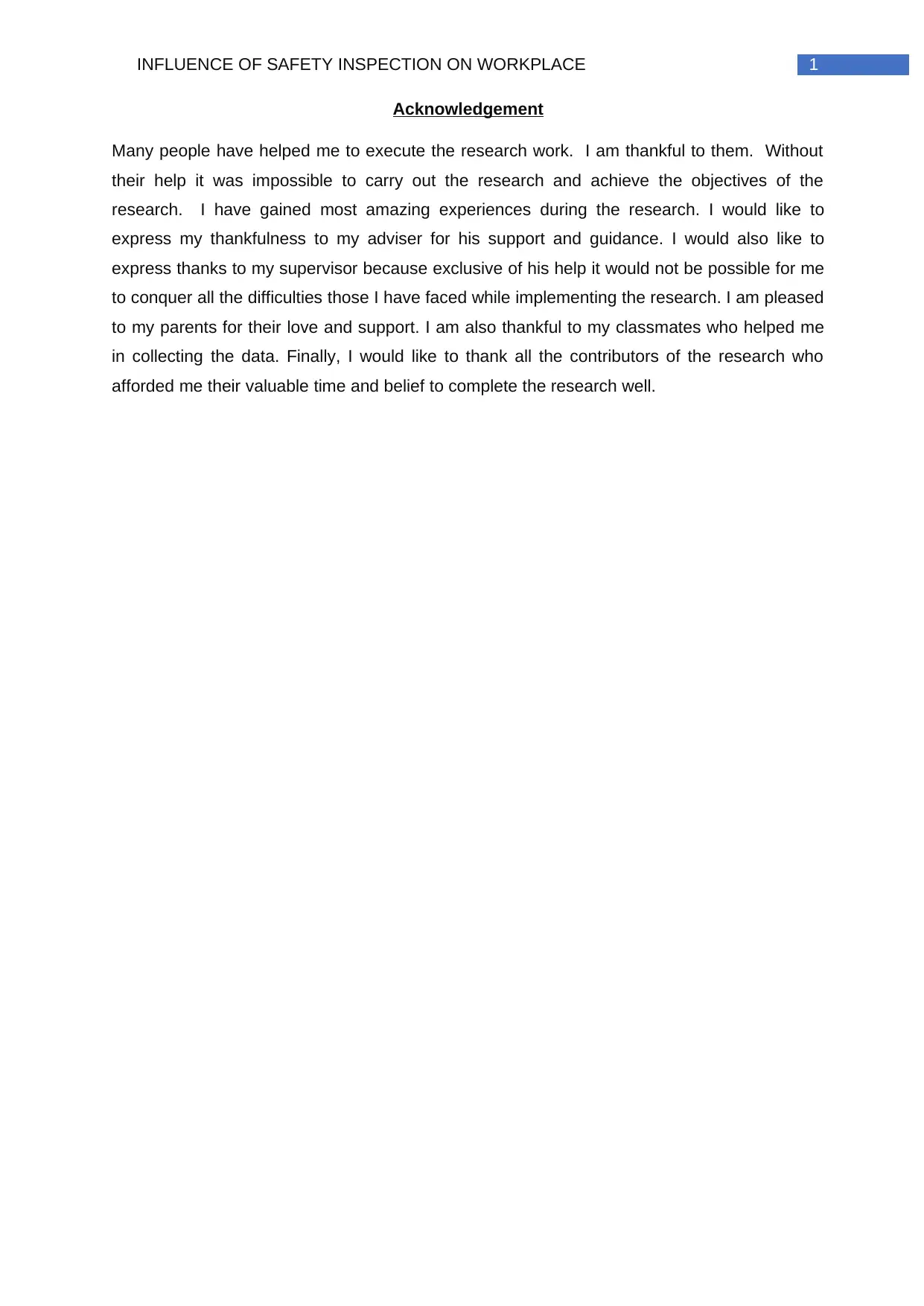
1INFLUENCE OF SAFETY INSPECTION ON WORKPLACE
Acknowledgement
Many people have helped me to execute the research work. I am thankful to them. Without
their help it was impossible to carry out the research and achieve the objectives of the
research. I have gained most amazing experiences during the research. I would like to
express my thankfulness to my adviser for his support and guidance. I would also like to
express thanks to my supervisor because exclusive of his help it would not be possible for me
to conquer all the difficulties those I have faced while implementing the research. I am pleased
to my parents for their love and support. I am also thankful to my classmates who helped me
in collecting the data. Finally, I would like to thank all the contributors of the research who
afforded me their valuable time and belief to complete the research well.
Acknowledgement
Many people have helped me to execute the research work. I am thankful to them. Without
their help it was impossible to carry out the research and achieve the objectives of the
research. I have gained most amazing experiences during the research. I would like to
express my thankfulness to my adviser for his support and guidance. I would also like to
express thanks to my supervisor because exclusive of his help it would not be possible for me
to conquer all the difficulties those I have faced while implementing the research. I am pleased
to my parents for their love and support. I am also thankful to my classmates who helped me
in collecting the data. Finally, I would like to thank all the contributors of the research who
afforded me their valuable time and belief to complete the research well.
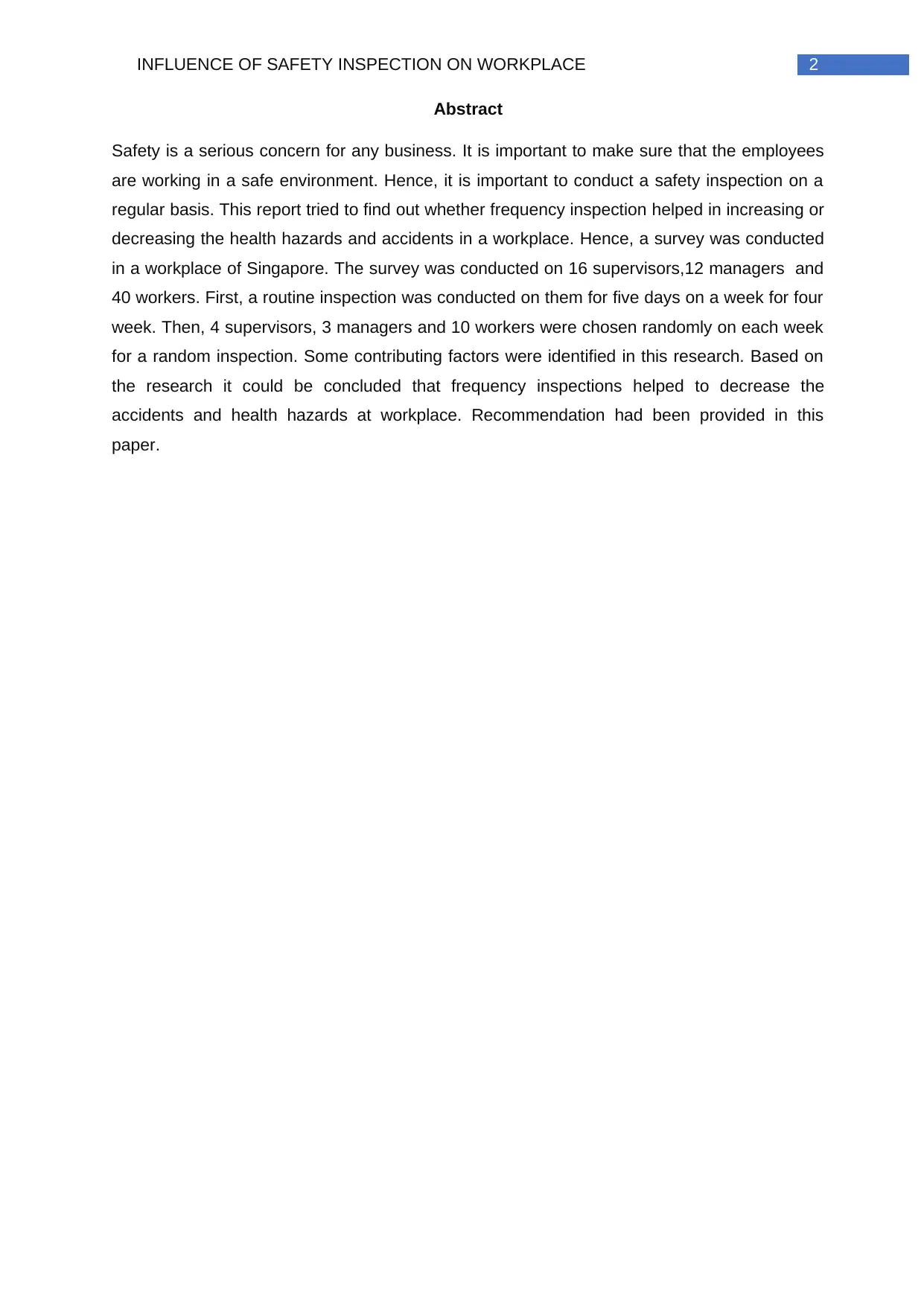
2INFLUENCE OF SAFETY INSPECTION ON WORKPLACE
Abstract
Safety is a serious concern for any business. It is important to make sure that the employees
are working in a safe environment. Hence, it is important to conduct a safety inspection on a
regular basis. This report tried to find out whether frequency inspection helped in increasing or
decreasing the health hazards and accidents in a workplace. Hence, a survey was conducted
in a workplace of Singapore. The survey was conducted on 16 supervisors,12 managers and
40 workers. First, a routine inspection was conducted on them for five days on a week for four
week. Then, 4 supervisors, 3 managers and 10 workers were chosen randomly on each week
for a random inspection. Some contributing factors were identified in this research. Based on
the research it could be concluded that frequency inspections helped to decrease the
accidents and health hazards at workplace. Recommendation had been provided in this
paper.
Abstract
Safety is a serious concern for any business. It is important to make sure that the employees
are working in a safe environment. Hence, it is important to conduct a safety inspection on a
regular basis. This report tried to find out whether frequency inspection helped in increasing or
decreasing the health hazards and accidents in a workplace. Hence, a survey was conducted
in a workplace of Singapore. The survey was conducted on 16 supervisors,12 managers and
40 workers. First, a routine inspection was conducted on them for five days on a week for four
week. Then, 4 supervisors, 3 managers and 10 workers were chosen randomly on each week
for a random inspection. Some contributing factors were identified in this research. Based on
the research it could be concluded that frequency inspections helped to decrease the
accidents and health hazards at workplace. Recommendation had been provided in this
paper.
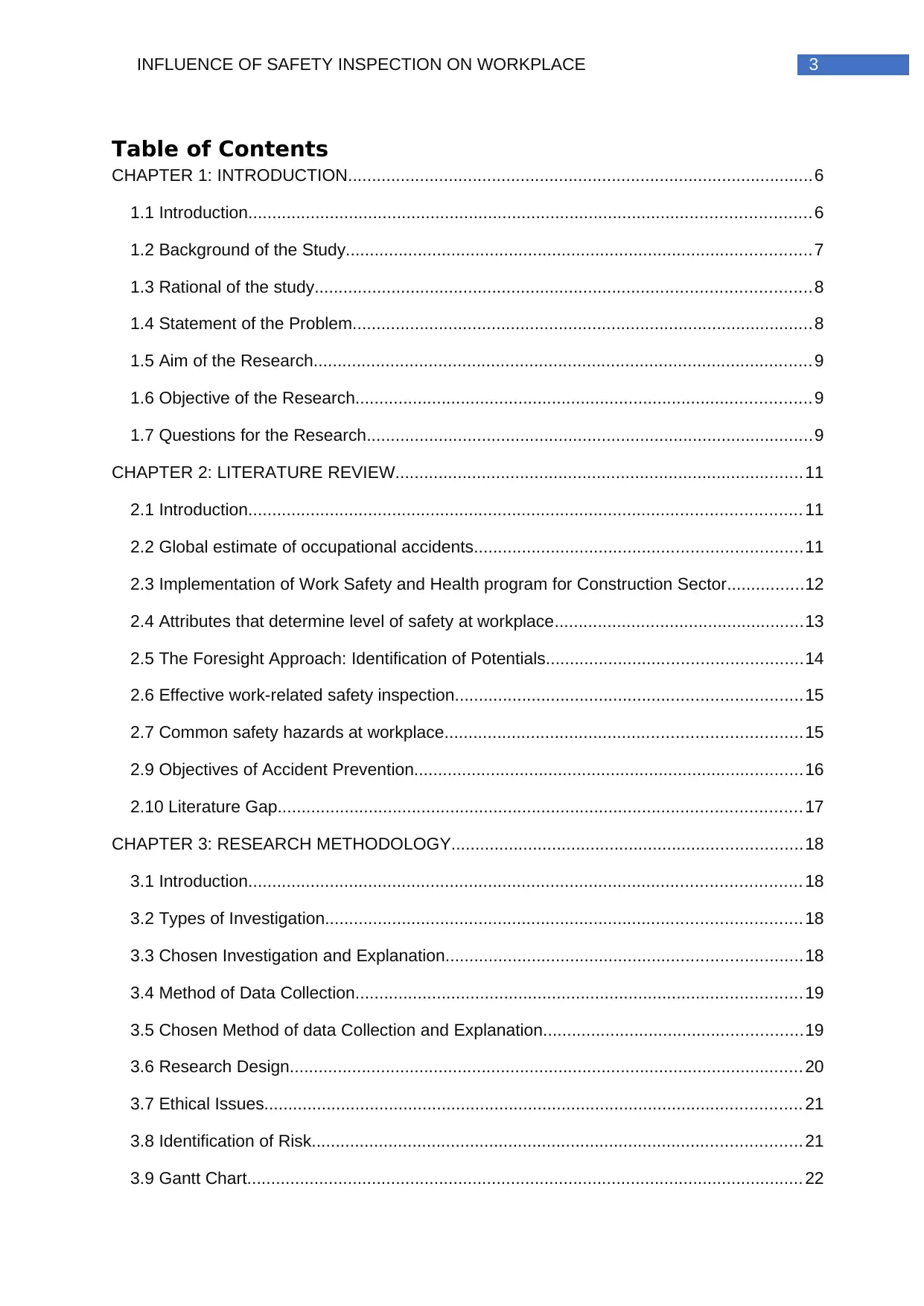
3INFLUENCE OF SAFETY INSPECTION ON WORKPLACE
Table of Contents
CHAPTER 1: INTRODUCTION.................................................................................................6
1.1 Introduction.....................................................................................................................6
1.2 Background of the Study.................................................................................................7
1.3 Rational of the study.......................................................................................................8
1.4 Statement of the Problem................................................................................................8
1.5 Aim of the Research........................................................................................................9
1.6 Objective of the Research...............................................................................................9
1.7 Questions for the Research.............................................................................................9
CHAPTER 2: LITERATURE REVIEW.....................................................................................11
2.1 Introduction................................................................................................................... 11
2.2 Global estimate of occupational accidents....................................................................11
2.3 Implementation of Work Safety and Health program for Construction Sector................12
2.4 Attributes that determine level of safety at workplace....................................................13
2.5 The Foresight Approach: Identification of Potentials.....................................................14
2.6 Effective work-related safety inspection........................................................................15
2.7 Common safety hazards at workplace..........................................................................15
2.9 Objectives of Accident Prevention.................................................................................16
2.10 Literature Gap............................................................................................................. 17
CHAPTER 3: RESEARCH METHODOLOGY.........................................................................18
3.1 Introduction................................................................................................................... 18
3.2 Types of Investigation...................................................................................................18
3.3 Chosen Investigation and Explanation..........................................................................18
3.4 Method of Data Collection.............................................................................................19
3.5 Chosen Method of data Collection and Explanation......................................................19
3.6 Research Design...........................................................................................................20
3.7 Ethical Issues................................................................................................................ 21
3.8 Identification of Risk......................................................................................................21
3.9 Gantt Chart.................................................................................................................... 22
Table of Contents
CHAPTER 1: INTRODUCTION.................................................................................................6
1.1 Introduction.....................................................................................................................6
1.2 Background of the Study.................................................................................................7
1.3 Rational of the study.......................................................................................................8
1.4 Statement of the Problem................................................................................................8
1.5 Aim of the Research........................................................................................................9
1.6 Objective of the Research...............................................................................................9
1.7 Questions for the Research.............................................................................................9
CHAPTER 2: LITERATURE REVIEW.....................................................................................11
2.1 Introduction................................................................................................................... 11
2.2 Global estimate of occupational accidents....................................................................11
2.3 Implementation of Work Safety and Health program for Construction Sector................12
2.4 Attributes that determine level of safety at workplace....................................................13
2.5 The Foresight Approach: Identification of Potentials.....................................................14
2.6 Effective work-related safety inspection........................................................................15
2.7 Common safety hazards at workplace..........................................................................15
2.9 Objectives of Accident Prevention.................................................................................16
2.10 Literature Gap............................................................................................................. 17
CHAPTER 3: RESEARCH METHODOLOGY.........................................................................18
3.1 Introduction................................................................................................................... 18
3.2 Types of Investigation...................................................................................................18
3.3 Chosen Investigation and Explanation..........................................................................18
3.4 Method of Data Collection.............................................................................................19
3.5 Chosen Method of data Collection and Explanation......................................................19
3.6 Research Design...........................................................................................................20
3.7 Ethical Issues................................................................................................................ 21
3.8 Identification of Risk......................................................................................................21
3.9 Gantt Chart.................................................................................................................... 22
Secure Best Marks with AI Grader
Need help grading? Try our AI Grader for instant feedback on your assignments.
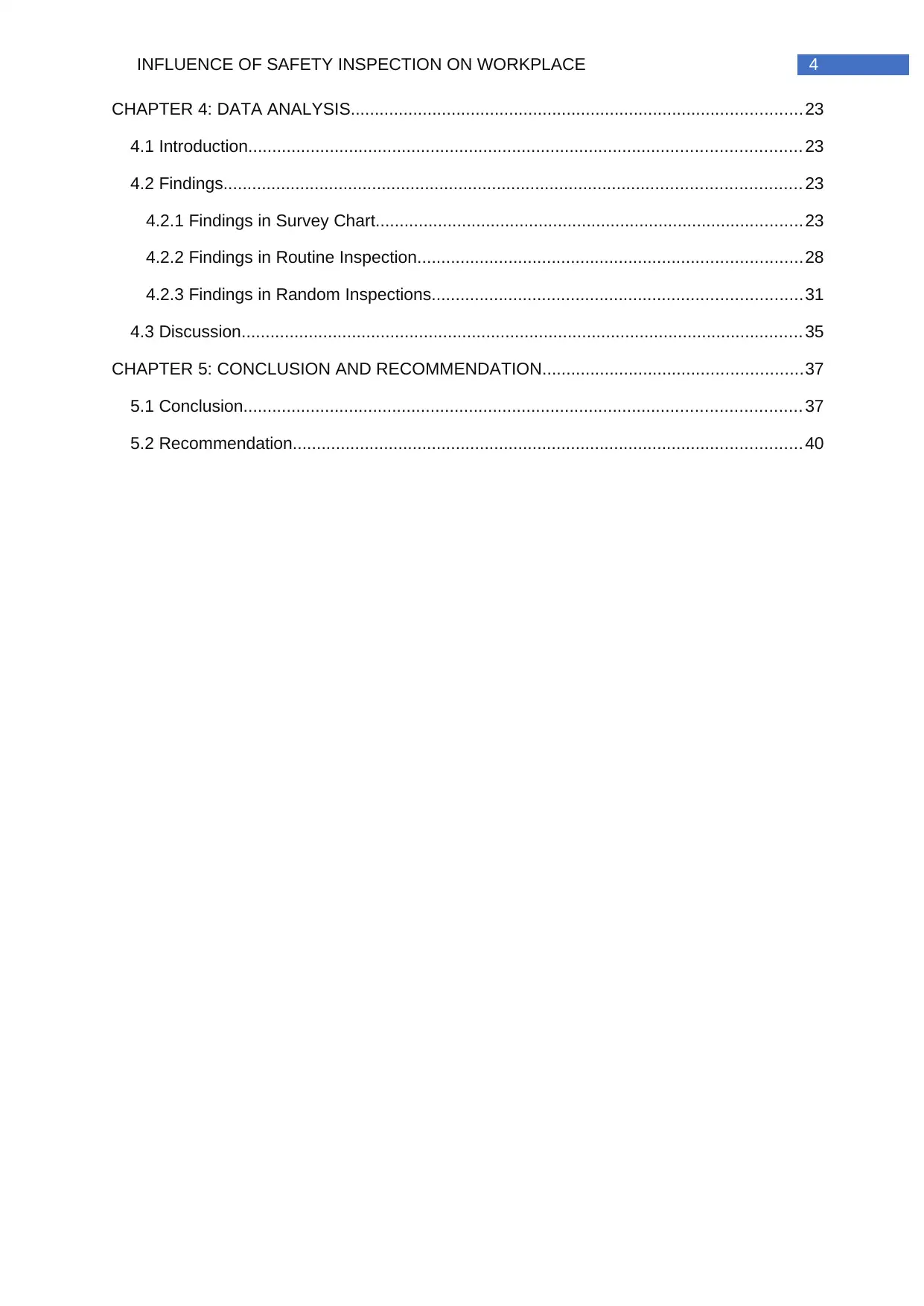
4INFLUENCE OF SAFETY INSPECTION ON WORKPLACE
CHAPTER 4: DATA ANALYSIS..............................................................................................23
4.1 Introduction................................................................................................................... 23
4.2 Findings........................................................................................................................ 23
4.2.1 Findings in Survey Chart.........................................................................................23
4.2.2 Findings in Routine Inspection................................................................................28
4.2.3 Findings in Random Inspections.............................................................................31
4.3 Discussion..................................................................................................................... 35
CHAPTER 5: CONCLUSION AND RECOMMENDATION......................................................37
5.1 Conclusion.................................................................................................................... 37
5.2 Recommendation..........................................................................................................40
CHAPTER 4: DATA ANALYSIS..............................................................................................23
4.1 Introduction................................................................................................................... 23
4.2 Findings........................................................................................................................ 23
4.2.1 Findings in Survey Chart.........................................................................................23
4.2.2 Findings in Routine Inspection................................................................................28
4.2.3 Findings in Random Inspections.............................................................................31
4.3 Discussion..................................................................................................................... 35
CHAPTER 5: CONCLUSION AND RECOMMENDATION......................................................37
5.1 Conclusion.................................................................................................................... 37
5.2 Recommendation..........................................................................................................40

5INFLUENCE OF SAFETY INSPECTION ON WORKPLACE
List of Figures
Figure 1: Relation between organization and Management Commitment...............................23
Figure 2: Frequency of Inspection...........................................................................................24
Figure 3: Effectiveness of SWP...............................................................................................24
Figure 4 :Effectiveness of BBS................................................................................................25
Figure 5 : Effectiveness of Training.........................................................................................26
Figure 6 : Time and Budget.....................................................................................................26
Figure 7 : Diagram of contributing factors...............................................................................27
Figure 8 : Fall prevention in routine inspection........................................................................28
Figure 9 : Fall materials in routine inspection..........................................................................29
Figure 10 : Lifting operations in routine inspection..................................................................30
Figure 11 : Roles of contributing factors in housekeeping......................................................30
Figure 12 : Use of Electrical Tools..........................................................................................31
Figure 13 : Fall prevention in random inspection.....................................................................32
Figure 14 : Fall of materials in random inspection...................................................................32
Figure 15 : Lifting operations in random inspection.................................................................33
Figure 16 : Use of electrical tools in random inspection..........................................................34
Figure 17 : Housekeeping in random inspection.....................................................................35
List of Figures
Figure 1: Relation between organization and Management Commitment...............................23
Figure 2: Frequency of Inspection...........................................................................................24
Figure 3: Effectiveness of SWP...............................................................................................24
Figure 4 :Effectiveness of BBS................................................................................................25
Figure 5 : Effectiveness of Training.........................................................................................26
Figure 6 : Time and Budget.....................................................................................................26
Figure 7 : Diagram of contributing factors...............................................................................27
Figure 8 : Fall prevention in routine inspection........................................................................28
Figure 9 : Fall materials in routine inspection..........................................................................29
Figure 10 : Lifting operations in routine inspection..................................................................30
Figure 11 : Roles of contributing factors in housekeeping......................................................30
Figure 12 : Use of Electrical Tools..........................................................................................31
Figure 13 : Fall prevention in random inspection.....................................................................32
Figure 14 : Fall of materials in random inspection...................................................................32
Figure 15 : Lifting operations in random inspection.................................................................33
Figure 16 : Use of electrical tools in random inspection..........................................................34
Figure 17 : Housekeeping in random inspection.....................................................................35

6INFLUENCE OF SAFETY INSPECTION ON WORKPLACE
CHAPTER 1: INTRODUCTION
1.1 Introduction
An inspection related to safety is a dignified and appropriately recognized procedure of
classifying risks at the place of work (Woodcock 2014). Different types of safety inspections
depend on the environment. Results against adequate values are evaluated. It is believed that
a particular environment has suitable limits of safety. An inspection decides whether the thing
or material is in good condition and quantity. Inspection is normally divided into three types
that are unloading inspection, in-process inspection and ultimate inspection. The responsibility
of inspection is to confirm and authenticate the variance data. There were lots of safety
scrutinise. Some of them were performed to test safety of vehicles, some looked over
business plants, and others were executed to categorize perils in the place of work. A
checklist was prepared for safety inspections. Consequently, It helped inspectors to consider
each area carefully or probable risk and to identify exact example that may cause safety
concerns (Zhang et al. 2013). The rationale of the security inspection program was to
distinguish and deal with safety-related risks and threats before the concerns caused injury,
the impact on environment, or the damage of property. Injuries, illness etc. could be prevented
through the inspections at the place of work. Inspections helped to recognize and verify
danger for appropriate actions through a significant examination of the workplace
The objective of an inspection is to supply the customer with information concerning the
conventionality of the inspected items with stipulation, which may be restricted in standards,
inspection schemes, regulations etc. Inspection may be used to compute the fulfilment of
commodities or system with safety, eminence and vigour for rationale requirements.
Safety and health committees could help to plan, conduct, supervise and report
inspections (Brauer 2016). Frequently inspection at workplace could improve the safety of
employees. Inspections were the crucial part of any health and safety program. Now a day,
largely of the regulatory inspections held with an opening conference (Reese 2015). The
compliance officer met with management during these conferences. Employees were selected
to explain the purpose and process of the inspection. The compliance officer and the
representatives of the organization carried out a walk around the employment site. Hence,
they tried to inspect the risks that could be responsible for the illness or injury of employees.
These hazards had to be corrected instantly. It was also to be noted that the observance
officer met with personnel of the organization in a closing conference (Friend and Kohn 2014).
This helped to discuss the results of the inspections. Therefore, the courses of action had to
be taken to fulfil with OSHA standards.
CHAPTER 1: INTRODUCTION
1.1 Introduction
An inspection related to safety is a dignified and appropriately recognized procedure of
classifying risks at the place of work (Woodcock 2014). Different types of safety inspections
depend on the environment. Results against adequate values are evaluated. It is believed that
a particular environment has suitable limits of safety. An inspection decides whether the thing
or material is in good condition and quantity. Inspection is normally divided into three types
that are unloading inspection, in-process inspection and ultimate inspection. The responsibility
of inspection is to confirm and authenticate the variance data. There were lots of safety
scrutinise. Some of them were performed to test safety of vehicles, some looked over
business plants, and others were executed to categorize perils in the place of work. A
checklist was prepared for safety inspections. Consequently, It helped inspectors to consider
each area carefully or probable risk and to identify exact example that may cause safety
concerns (Zhang et al. 2013). The rationale of the security inspection program was to
distinguish and deal with safety-related risks and threats before the concerns caused injury,
the impact on environment, or the damage of property. Injuries, illness etc. could be prevented
through the inspections at the place of work. Inspections helped to recognize and verify
danger for appropriate actions through a significant examination of the workplace
The objective of an inspection is to supply the customer with information concerning the
conventionality of the inspected items with stipulation, which may be restricted in standards,
inspection schemes, regulations etc. Inspection may be used to compute the fulfilment of
commodities or system with safety, eminence and vigour for rationale requirements.
Safety and health committees could help to plan, conduct, supervise and report
inspections (Brauer 2016). Frequently inspection at workplace could improve the safety of
employees. Inspections were the crucial part of any health and safety program. Now a day,
largely of the regulatory inspections held with an opening conference (Reese 2015). The
compliance officer met with management during these conferences. Employees were selected
to explain the purpose and process of the inspection. The compliance officer and the
representatives of the organization carried out a walk around the employment site. Hence,
they tried to inspect the risks that could be responsible for the illness or injury of employees.
These hazards had to be corrected instantly. It was also to be noted that the observance
officer met with personnel of the organization in a closing conference (Friend and Kohn 2014).
This helped to discuss the results of the inspections. Therefore, the courses of action had to
be taken to fulfil with OSHA standards.
Paraphrase This Document
Need a fresh take? Get an instant paraphrase of this document with our AI Paraphraser
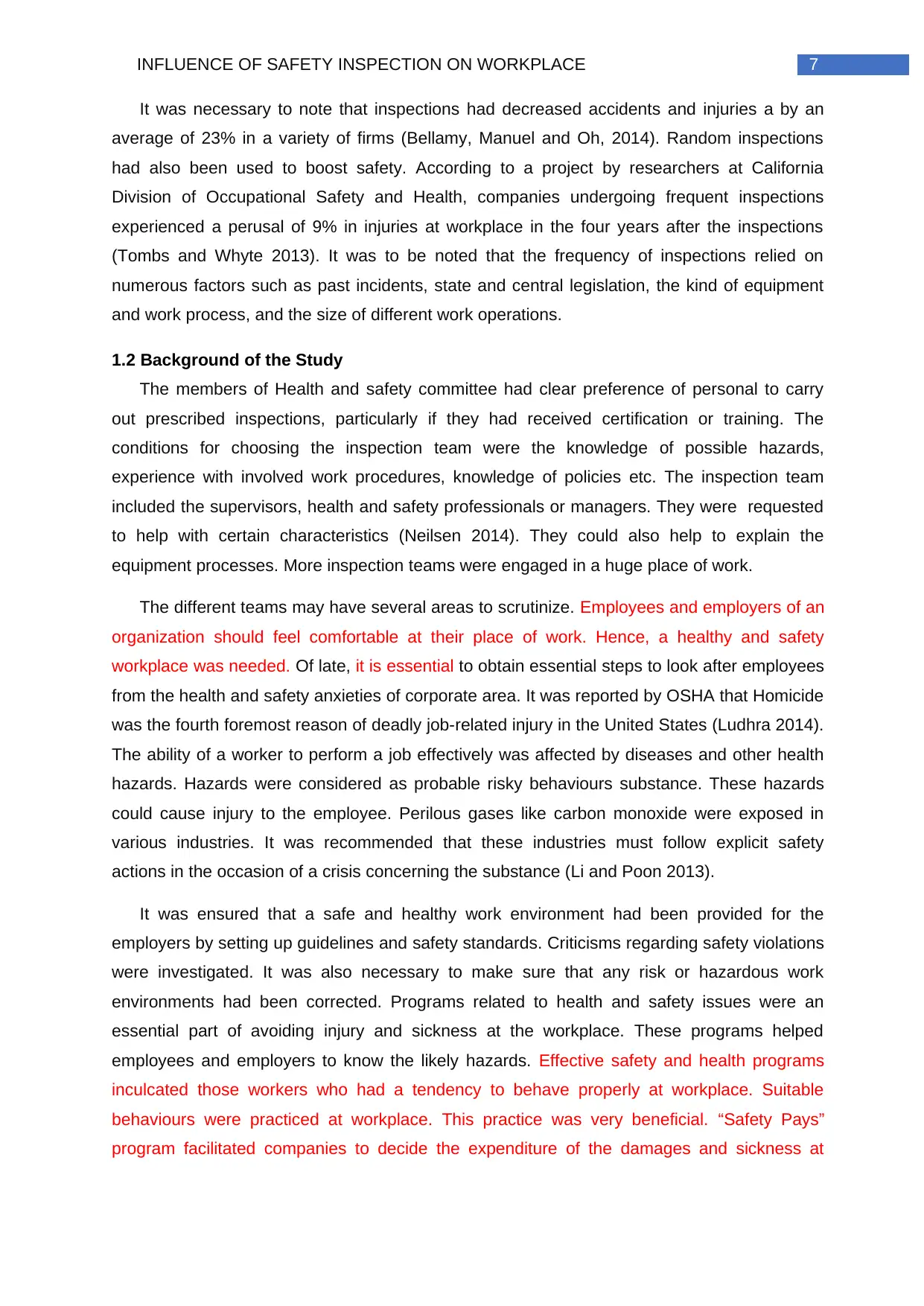
7INFLUENCE OF SAFETY INSPECTION ON WORKPLACE
It was necessary to note that inspections had decreased accidents and injuries a by an
average of 23% in a variety of firms (Bellamy, Manuel and Oh, 2014). Random inspections
had also been used to boost safety. According to a project by researchers at California
Division of Occupational Safety and Health, companies undergoing frequent inspections
experienced a perusal of 9% in injuries at workplace in the four years after the inspections
(Tombs and Whyte 2013). It was to be noted that the frequency of inspections relied on
numerous factors such as past incidents, state and central legislation, the kind of equipment
and work process, and the size of different work operations.
1.2 Background of the Study
The members of Health and safety committee had clear preference of personal to carry
out prescribed inspections, particularly if they had received certification or training. The
conditions for choosing the inspection team were the knowledge of possible hazards,
experience with involved work procedures, knowledge of policies etc. The inspection team
included the supervisors, health and safety professionals or managers. They were requested
to help with certain characteristics (Neilsen 2014). They could also help to explain the
equipment processes. More inspection teams were engaged in a huge place of work.
The different teams may have several areas to scrutinize. Employees and employers of an
organization should feel comfortable at their place of work. Hence, a healthy and safety
workplace was needed. Of late, it is essential to obtain essential steps to look after employees
from the health and safety anxieties of corporate area. It was reported by OSHA that Homicide
was the fourth foremost reason of deadly job-related injury in the United States (Ludhra 2014).
The ability of a worker to perform a job effectively was affected by diseases and other health
hazards. Hazards were considered as probable risky behaviours substance. These hazards
could cause injury to the employee. Perilous gases like carbon monoxide were exposed in
various industries. It was recommended that these industries must follow explicit safety
actions in the occasion of a crisis concerning the substance (Li and Poon 2013).
It was ensured that a safe and healthy work environment had been provided for the
employers by setting up guidelines and safety standards. Criticisms regarding safety violations
were investigated. It was also necessary to make sure that any risk or hazardous work
environments had been corrected. Programs related to health and safety issues were an
essential part of avoiding injury and sickness at the workplace. These programs helped
employees and employers to know the likely hazards. Effective safety and health programs
inculcated those workers who had a tendency to behave properly at workplace. Suitable
behaviours were practiced at workplace. This practice was very beneficial. “Safety Pays”
program facilitated companies to decide the expenditure of the damages and sickness at
It was necessary to note that inspections had decreased accidents and injuries a by an
average of 23% in a variety of firms (Bellamy, Manuel and Oh, 2014). Random inspections
had also been used to boost safety. According to a project by researchers at California
Division of Occupational Safety and Health, companies undergoing frequent inspections
experienced a perusal of 9% in injuries at workplace in the four years after the inspections
(Tombs and Whyte 2013). It was to be noted that the frequency of inspections relied on
numerous factors such as past incidents, state and central legislation, the kind of equipment
and work process, and the size of different work operations.
1.2 Background of the Study
The members of Health and safety committee had clear preference of personal to carry
out prescribed inspections, particularly if they had received certification or training. The
conditions for choosing the inspection team were the knowledge of possible hazards,
experience with involved work procedures, knowledge of policies etc. The inspection team
included the supervisors, health and safety professionals or managers. They were requested
to help with certain characteristics (Neilsen 2014). They could also help to explain the
equipment processes. More inspection teams were engaged in a huge place of work.
The different teams may have several areas to scrutinize. Employees and employers of an
organization should feel comfortable at their place of work. Hence, a healthy and safety
workplace was needed. Of late, it is essential to obtain essential steps to look after employees
from the health and safety anxieties of corporate area. It was reported by OSHA that Homicide
was the fourth foremost reason of deadly job-related injury in the United States (Ludhra 2014).
The ability of a worker to perform a job effectively was affected by diseases and other health
hazards. Hazards were considered as probable risky behaviours substance. These hazards
could cause injury to the employee. Perilous gases like carbon monoxide were exposed in
various industries. It was recommended that these industries must follow explicit safety
actions in the occasion of a crisis concerning the substance (Li and Poon 2013).
It was ensured that a safe and healthy work environment had been provided for the
employers by setting up guidelines and safety standards. Criticisms regarding safety violations
were investigated. It was also necessary to make sure that any risk or hazardous work
environments had been corrected. Programs related to health and safety issues were an
essential part of avoiding injury and sickness at the workplace. These programs helped
employees and employers to know the likely hazards. Effective safety and health programs
inculcated those workers who had a tendency to behave properly at workplace. Suitable
behaviours were practiced at workplace. This practice was very beneficial. “Safety Pays”
program facilitated companies to decide the expenditure of the damages and sickness at
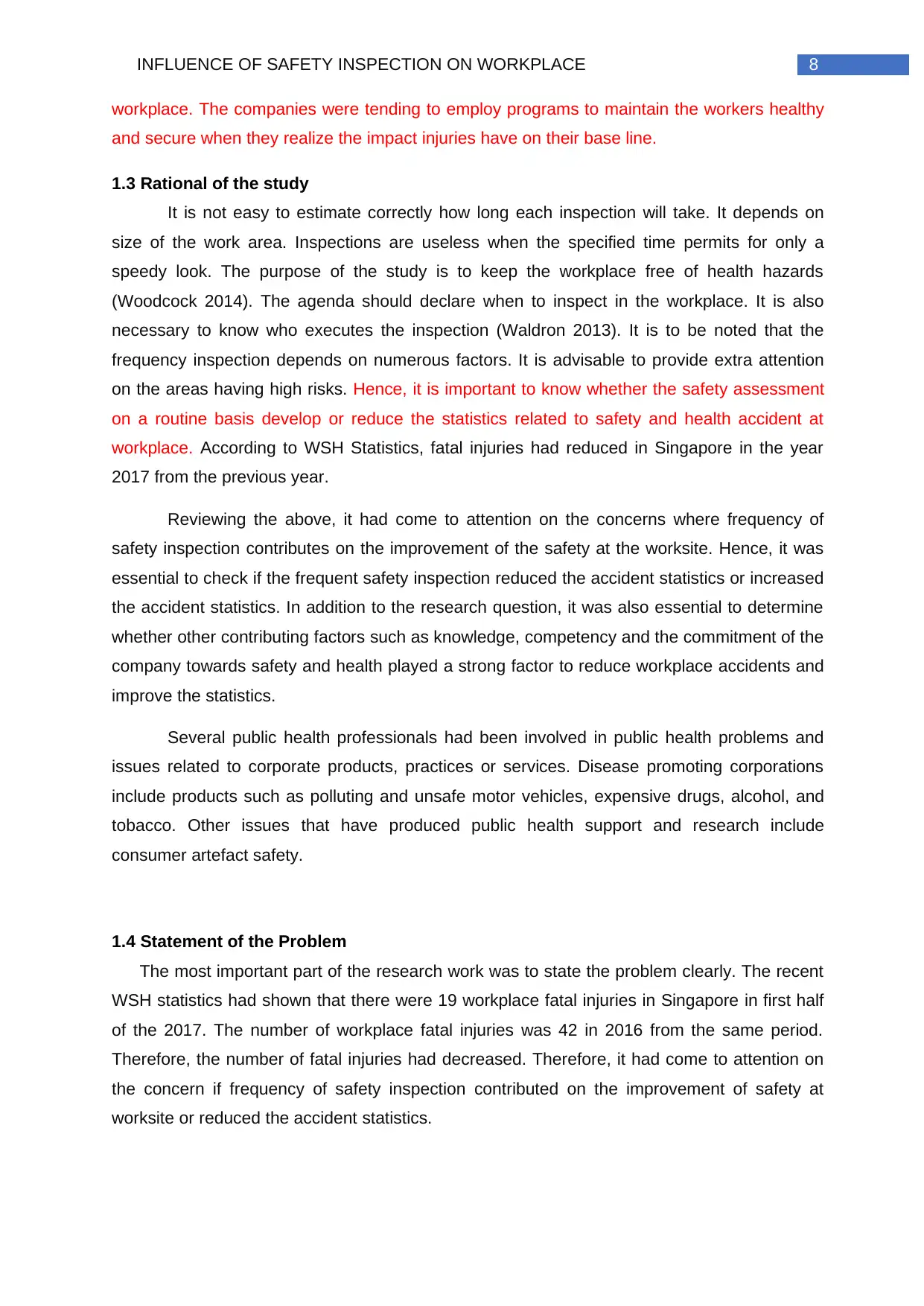
8INFLUENCE OF SAFETY INSPECTION ON WORKPLACE
workplace. The companies were tending to employ programs to maintain the workers healthy
and secure when they realize the impact injuries have on their base line.
1.3 Rational of the study
It is not easy to estimate correctly how long each inspection will take. It depends on
size of the work area. Inspections are useless when the specified time permits for only a
speedy look. The purpose of the study is to keep the workplace free of health hazards
(Woodcock 2014). The agenda should declare when to inspect in the workplace. It is also
necessary to know who executes the inspection (Waldron 2013). It is to be noted that the
frequency inspection depends on numerous factors. It is advisable to provide extra attention
on the areas having high risks. Hence, it is important to know whether the safety assessment
on a routine basis develop or reduce the statistics related to safety and health accident at
workplace. According to WSH Statistics, fatal injuries had reduced in Singapore in the year
2017 from the previous year.
Reviewing the above, it had come to attention on the concerns where frequency of
safety inspection contributes on the improvement of the safety at the worksite. Hence, it was
essential to check if the frequent safety inspection reduced the accident statistics or increased
the accident statistics. In addition to the research question, it was also essential to determine
whether other contributing factors such as knowledge, competency and the commitment of the
company towards safety and health played a strong factor to reduce workplace accidents and
improve the statistics.
Several public health professionals had been involved in public health problems and
issues related to corporate products, practices or services. Disease promoting corporations
include products such as polluting and unsafe motor vehicles, expensive drugs, alcohol, and
tobacco. Other issues that have produced public health support and research include
consumer artefact safety.
1.4 Statement of the Problem
The most important part of the research work was to state the problem clearly. The recent
WSH statistics had shown that there were 19 workplace fatal injuries in Singapore in first half
of the 2017. The number of workplace fatal injuries was 42 in 2016 from the same period.
Therefore, the number of fatal injuries had decreased. Therefore, it had come to attention on
the concern if frequency of safety inspection contributed on the improvement of safety at
worksite or reduced the accident statistics.
workplace. The companies were tending to employ programs to maintain the workers healthy
and secure when they realize the impact injuries have on their base line.
1.3 Rational of the study
It is not easy to estimate correctly how long each inspection will take. It depends on
size of the work area. Inspections are useless when the specified time permits for only a
speedy look. The purpose of the study is to keep the workplace free of health hazards
(Woodcock 2014). The agenda should declare when to inspect in the workplace. It is also
necessary to know who executes the inspection (Waldron 2013). It is to be noted that the
frequency inspection depends on numerous factors. It is advisable to provide extra attention
on the areas having high risks. Hence, it is important to know whether the safety assessment
on a routine basis develop or reduce the statistics related to safety and health accident at
workplace. According to WSH Statistics, fatal injuries had reduced in Singapore in the year
2017 from the previous year.
Reviewing the above, it had come to attention on the concerns where frequency of
safety inspection contributes on the improvement of the safety at the worksite. Hence, it was
essential to check if the frequent safety inspection reduced the accident statistics or increased
the accident statistics. In addition to the research question, it was also essential to determine
whether other contributing factors such as knowledge, competency and the commitment of the
company towards safety and health played a strong factor to reduce workplace accidents and
improve the statistics.
Several public health professionals had been involved in public health problems and
issues related to corporate products, practices or services. Disease promoting corporations
include products such as polluting and unsafe motor vehicles, expensive drugs, alcohol, and
tobacco. Other issues that have produced public health support and research include
consumer artefact safety.
1.4 Statement of the Problem
The most important part of the research work was to state the problem clearly. The recent
WSH statistics had shown that there were 19 workplace fatal injuries in Singapore in first half
of the 2017. The number of workplace fatal injuries was 42 in 2016 from the same period.
Therefore, the number of fatal injuries had decreased. Therefore, it had come to attention on
the concern if frequency of safety inspection contributed on the improvement of safety at
worksite or reduced the accident statistics.
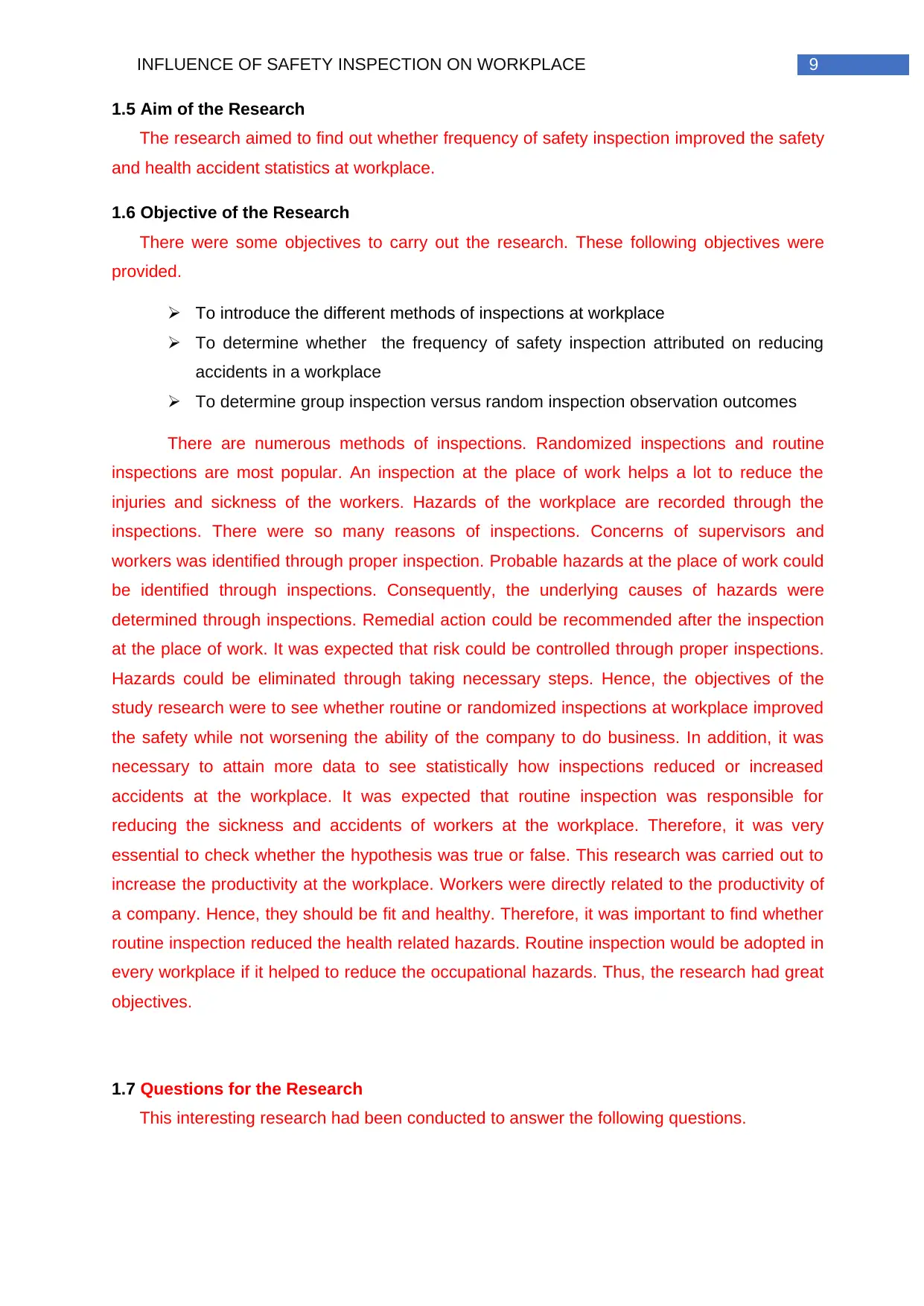
9INFLUENCE OF SAFETY INSPECTION ON WORKPLACE
1.5 Aim of the Research
The research aimed to find out whether frequency of safety inspection improved the safety
and health accident statistics at workplace.
1.6 Objective of the Research
There were some objectives to carry out the research. These following objectives were
provided.
To introduce the different methods of inspections at workplace
To determine whether the frequency of safety inspection attributed on reducing
accidents in a workplace
To determine group inspection versus random inspection observation outcomes
There are numerous methods of inspections. Randomized inspections and routine
inspections are most popular. An inspection at the place of work helps a lot to reduce the
injuries and sickness of the workers. Hazards of the workplace are recorded through the
inspections. There were so many reasons of inspections. Concerns of supervisors and
workers was identified through proper inspection. Probable hazards at the place of work could
be identified through inspections. Consequently, the underlying causes of hazards were
determined through inspections. Remedial action could be recommended after the inspection
at the place of work. It was expected that risk could be controlled through proper inspections.
Hazards could be eliminated through taking necessary steps. Hence, the objectives of the
study research were to see whether routine or randomized inspections at workplace improved
the safety while not worsening the ability of the company to do business. In addition, it was
necessary to attain more data to see statistically how inspections reduced or increased
accidents at the workplace. It was expected that routine inspection was responsible for
reducing the sickness and accidents of workers at the workplace. Therefore, it was very
essential to check whether the hypothesis was true or false. This research was carried out to
increase the productivity at the workplace. Workers were directly related to the productivity of
a company. Hence, they should be fit and healthy. Therefore, it was important to find whether
routine inspection reduced the health related hazards. Routine inspection would be adopted in
every workplace if it helped to reduce the occupational hazards. Thus, the research had great
objectives.
1.7 Questions for the Research
This interesting research had been conducted to answer the following questions.
1.5 Aim of the Research
The research aimed to find out whether frequency of safety inspection improved the safety
and health accident statistics at workplace.
1.6 Objective of the Research
There were some objectives to carry out the research. These following objectives were
provided.
To introduce the different methods of inspections at workplace
To determine whether the frequency of safety inspection attributed on reducing
accidents in a workplace
To determine group inspection versus random inspection observation outcomes
There are numerous methods of inspections. Randomized inspections and routine
inspections are most popular. An inspection at the place of work helps a lot to reduce the
injuries and sickness of the workers. Hazards of the workplace are recorded through the
inspections. There were so many reasons of inspections. Concerns of supervisors and
workers was identified through proper inspection. Probable hazards at the place of work could
be identified through inspections. Consequently, the underlying causes of hazards were
determined through inspections. Remedial action could be recommended after the inspection
at the place of work. It was expected that risk could be controlled through proper inspections.
Hazards could be eliminated through taking necessary steps. Hence, the objectives of the
study research were to see whether routine or randomized inspections at workplace improved
the safety while not worsening the ability of the company to do business. In addition, it was
necessary to attain more data to see statistically how inspections reduced or increased
accidents at the workplace. It was expected that routine inspection was responsible for
reducing the sickness and accidents of workers at the workplace. Therefore, it was very
essential to check whether the hypothesis was true or false. This research was carried out to
increase the productivity at the workplace. Workers were directly related to the productivity of
a company. Hence, they should be fit and healthy. Therefore, it was important to find whether
routine inspection reduced the health related hazards. Routine inspection would be adopted in
every workplace if it helped to reduce the occupational hazards. Thus, the research had great
objectives.
1.7 Questions for the Research
This interesting research had been conducted to answer the following questions.
Secure Best Marks with AI Grader
Need help grading? Try our AI Grader for instant feedback on your assignments.
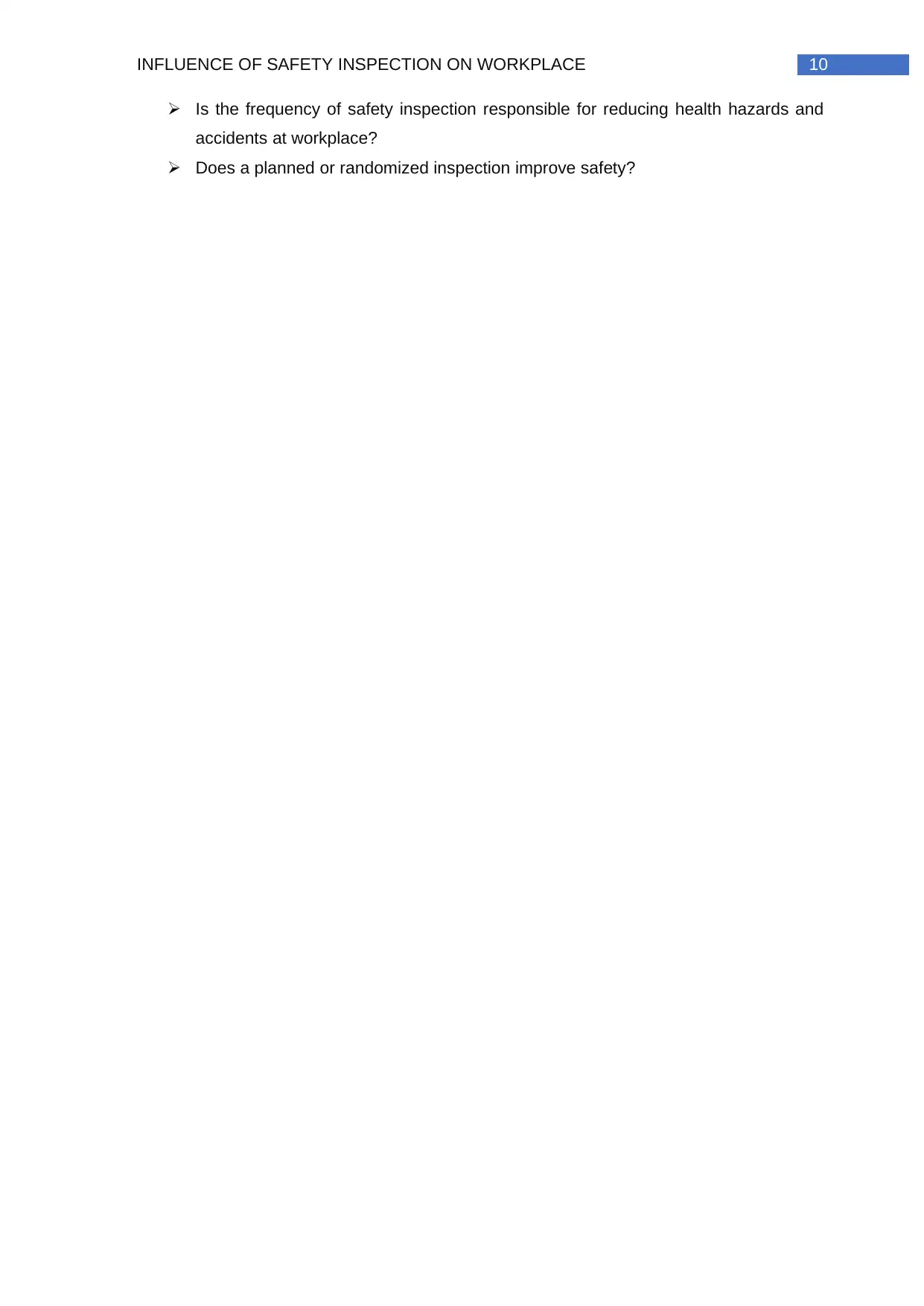
10INFLUENCE OF SAFETY INSPECTION ON WORKPLACE
Is the frequency of safety inspection responsible for reducing health hazards and
accidents at workplace?
Does a planned or randomized inspection improve safety?
Is the frequency of safety inspection responsible for reducing health hazards and
accidents at workplace?
Does a planned or randomized inspection improve safety?
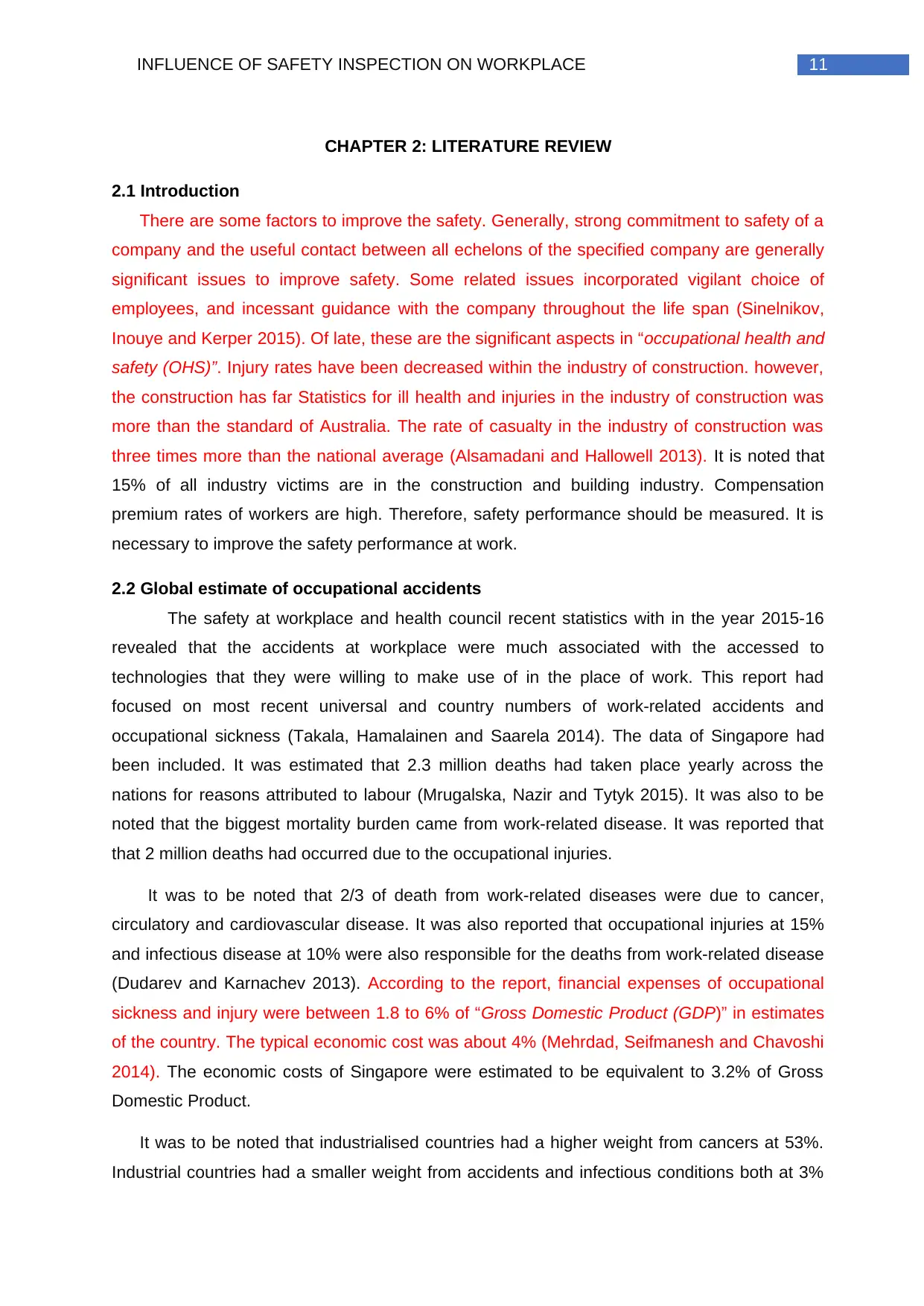
11INFLUENCE OF SAFETY INSPECTION ON WORKPLACE
CHAPTER 2: LITERATURE REVIEW
2.1 Introduction
There are some factors to improve the safety. Generally, strong commitment to safety of a
company and the useful contact between all echelons of the specified company are generally
significant issues to improve safety. Some related issues incorporated vigilant choice of
employees, and incessant guidance with the company throughout the life span (Sinelnikov,
Inouye and Kerper 2015). Of late, these are the significant aspects in “occupational health and
safety (OHS)”. Injury rates have been decreased within the industry of construction. however,
the construction has far Statistics for ill health and injuries in the industry of construction was
more than the standard of Australia. The rate of casualty in the industry of construction was
three times more than the national average (Alsamadani and Hallowell 2013). It is noted that
15% of all industry victims are in the construction and building industry. Compensation
premium rates of workers are high. Therefore, safety performance should be measured. It is
necessary to improve the safety performance at work.
2.2 Global estimate of occupational accidents
The safety at workplace and health council recent statistics with in the year 2015-16
revealed that the accidents at workplace were much associated with the accessed to
technologies that they were willing to make use of in the place of work. This report had
focused on most recent universal and country numbers of work-related accidents and
occupational sickness (Takala, Hamalainen and Saarela 2014). The data of Singapore had
been included. It was estimated that 2.3 million deaths had taken place yearly across the
nations for reasons attributed to labour (Mrugalska, Nazir and Tytyk 2015). It was also to be
noted that the biggest mortality burden came from work-related disease. It was reported that
that 2 million deaths had occurred due to the occupational injuries.
It was to be noted that 2/3 of death from work-related diseases were due to cancer,
circulatory and cardiovascular disease. It was also reported that occupational injuries at 15%
and infectious disease at 10% were also responsible for the deaths from work-related disease
(Dudarev and Karnachev 2013). According to the report, financial expenses of occupational
sickness and injury were between 1.8 to 6% of “Gross Domestic Product (GDP)” in estimates
of the country. The typical economic cost was about 4% (Mehrdad, Seifmanesh and Chavoshi
2014). The economic costs of Singapore were estimated to be equivalent to 3.2% of Gross
Domestic Product.
It was to be noted that industrialised countries had a higher weight from cancers at 53%.
Industrial countries had a smaller weight from accidents and infectious conditions both at 3%
CHAPTER 2: LITERATURE REVIEW
2.1 Introduction
There are some factors to improve the safety. Generally, strong commitment to safety of a
company and the useful contact between all echelons of the specified company are generally
significant issues to improve safety. Some related issues incorporated vigilant choice of
employees, and incessant guidance with the company throughout the life span (Sinelnikov,
Inouye and Kerper 2015). Of late, these are the significant aspects in “occupational health and
safety (OHS)”. Injury rates have been decreased within the industry of construction. however,
the construction has far Statistics for ill health and injuries in the industry of construction was
more than the standard of Australia. The rate of casualty in the industry of construction was
three times more than the national average (Alsamadani and Hallowell 2013). It is noted that
15% of all industry victims are in the construction and building industry. Compensation
premium rates of workers are high. Therefore, safety performance should be measured. It is
necessary to improve the safety performance at work.
2.2 Global estimate of occupational accidents
The safety at workplace and health council recent statistics with in the year 2015-16
revealed that the accidents at workplace were much associated with the accessed to
technologies that they were willing to make use of in the place of work. This report had
focused on most recent universal and country numbers of work-related accidents and
occupational sickness (Takala, Hamalainen and Saarela 2014). The data of Singapore had
been included. It was estimated that 2.3 million deaths had taken place yearly across the
nations for reasons attributed to labour (Mrugalska, Nazir and Tytyk 2015). It was also to be
noted that the biggest mortality burden came from work-related disease. It was reported that
that 2 million deaths had occurred due to the occupational injuries.
It was to be noted that 2/3 of death from work-related diseases were due to cancer,
circulatory and cardiovascular disease. It was also reported that occupational injuries at 15%
and infectious disease at 10% were also responsible for the deaths from work-related disease
(Dudarev and Karnachev 2013). According to the report, financial expenses of occupational
sickness and injury were between 1.8 to 6% of “Gross Domestic Product (GDP)” in estimates
of the country. The typical economic cost was about 4% (Mehrdad, Seifmanesh and Chavoshi
2014). The economic costs of Singapore were estimated to be equivalent to 3.2% of Gross
Domestic Product.
It was to be noted that industrialised countries had a higher weight from cancers at 53%.
Industrial countries had a smaller weight from accidents and infectious conditions both at 3%
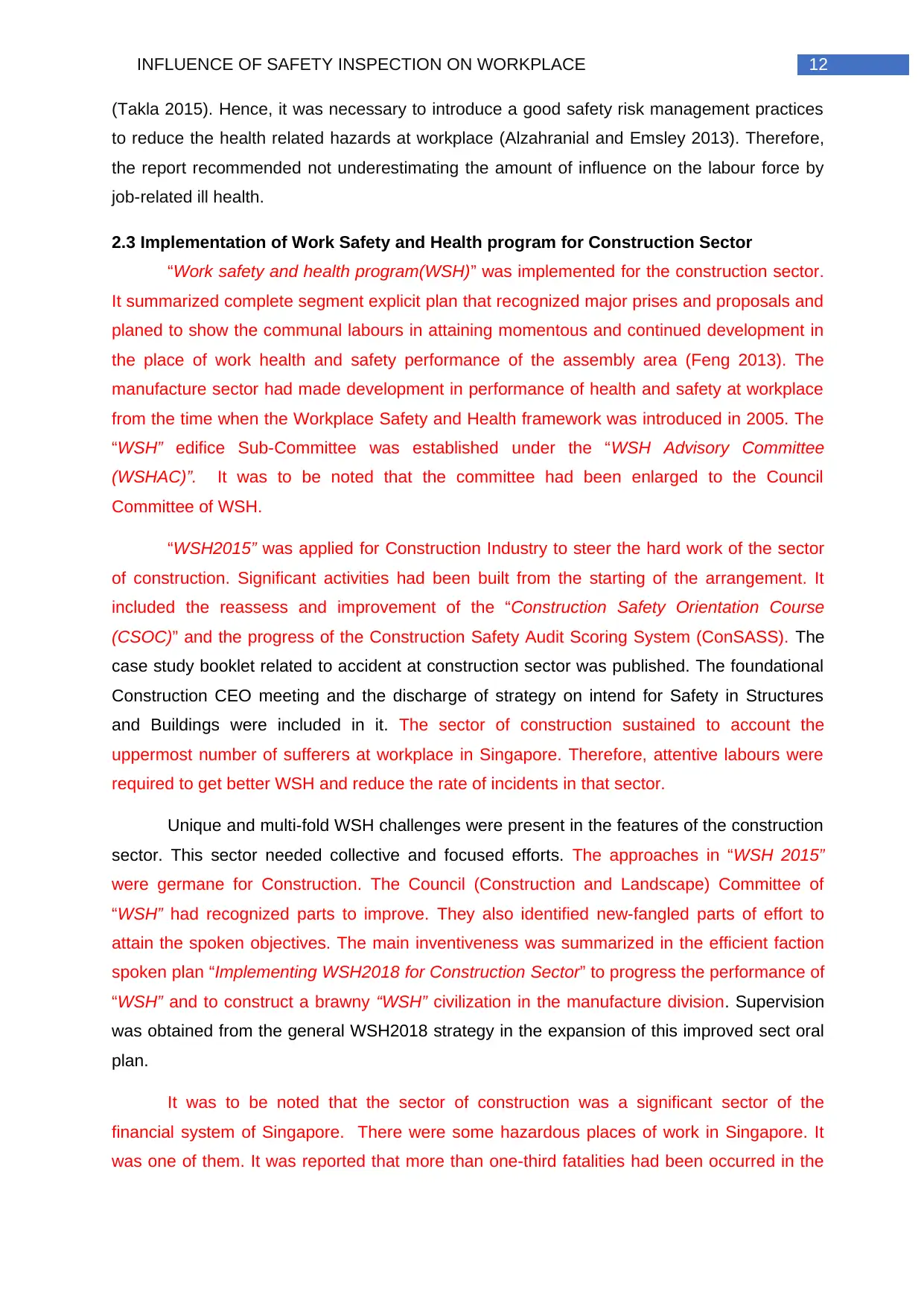
12INFLUENCE OF SAFETY INSPECTION ON WORKPLACE
(Takla 2015). Hence, it was necessary to introduce a good safety risk management practices
to reduce the health related hazards at workplace (Alzahranial and Emsley 2013). Therefore,
the report recommended not underestimating the amount of influence on the labour force by
job-related ill health.
2.3 Implementation of Work Safety and Health program for Construction Sector
“Work safety and health program(WSH)” was implemented for the construction sector.
It summarized complete segment explicit plan that recognized major prises and proposals and
planed to show the communal labours in attaining momentous and continued development in
the place of work health and safety performance of the assembly area (Feng 2013). The
manufacture sector had made development in performance of health and safety at workplace
from the time when the Workplace Safety and Health framework was introduced in 2005. The
“WSH” edifice Sub-Committee was established under the “WSH Advisory Committee
(WSHAC)”. It was to be noted that the committee had been enlarged to the Council
Committee of WSH.
“WSH2015” was applied for Construction Industry to steer the hard work of the sector
of construction. Significant activities had been built from the starting of the arrangement. It
included the reassess and improvement of the “Construction Safety Orientation Course
(CSOC)” and the progress of the Construction Safety Audit Scoring System (ConSASS). The
case study booklet related to accident at construction sector was published. The foundational
Construction CEO meeting and the discharge of strategy on intend for Safety in Structures
and Buildings were included in it. The sector of construction sustained to account the
uppermost number of sufferers at workplace in Singapore. Therefore, attentive labours were
required to get better WSH and reduce the rate of incidents in that sector.
Unique and multi-fold WSH challenges were present in the features of the construction
sector. This sector needed collective and focused efforts. The approaches in “WSH 2015”
were germane for Construction. The Council (Construction and Landscape) Committee of
“WSH” had recognized parts to improve. They also identified new-fangled parts of effort to
attain the spoken objectives. The main inventiveness was summarized in the efficient faction
spoken plan “Implementing WSH2018 for Construction Sector” to progress the performance of
“WSH” and to construct a brawny “WSH” civilization in the manufacture division. Supervision
was obtained from the general WSH2018 strategy in the expansion of this improved sect oral
plan.
It was to be noted that the sector of construction was a significant sector of the
financial system of Singapore. There were some hazardous places of work in Singapore. It
was one of them. It was reported that more than one-third fatalities had been occurred in the
(Takla 2015). Hence, it was necessary to introduce a good safety risk management practices
to reduce the health related hazards at workplace (Alzahranial and Emsley 2013). Therefore,
the report recommended not underestimating the amount of influence on the labour force by
job-related ill health.
2.3 Implementation of Work Safety and Health program for Construction Sector
“Work safety and health program(WSH)” was implemented for the construction sector.
It summarized complete segment explicit plan that recognized major prises and proposals and
planed to show the communal labours in attaining momentous and continued development in
the place of work health and safety performance of the assembly area (Feng 2013). The
manufacture sector had made development in performance of health and safety at workplace
from the time when the Workplace Safety and Health framework was introduced in 2005. The
“WSH” edifice Sub-Committee was established under the “WSH Advisory Committee
(WSHAC)”. It was to be noted that the committee had been enlarged to the Council
Committee of WSH.
“WSH2015” was applied for Construction Industry to steer the hard work of the sector
of construction. Significant activities had been built from the starting of the arrangement. It
included the reassess and improvement of the “Construction Safety Orientation Course
(CSOC)” and the progress of the Construction Safety Audit Scoring System (ConSASS). The
case study booklet related to accident at construction sector was published. The foundational
Construction CEO meeting and the discharge of strategy on intend for Safety in Structures
and Buildings were included in it. The sector of construction sustained to account the
uppermost number of sufferers at workplace in Singapore. Therefore, attentive labours were
required to get better WSH and reduce the rate of incidents in that sector.
Unique and multi-fold WSH challenges were present in the features of the construction
sector. This sector needed collective and focused efforts. The approaches in “WSH 2015”
were germane for Construction. The Council (Construction and Landscape) Committee of
“WSH” had recognized parts to improve. They also identified new-fangled parts of effort to
attain the spoken objectives. The main inventiveness was summarized in the efficient faction
spoken plan “Implementing WSH2018 for Construction Sector” to progress the performance of
“WSH” and to construct a brawny “WSH” civilization in the manufacture division. Supervision
was obtained from the general WSH2018 strategy in the expansion of this improved sect oral
plan.
It was to be noted that the sector of construction was a significant sector of the
financial system of Singapore. There were some hazardous places of work in Singapore. It
was one of them. It was reported that more than one-third fatalities had been occurred in the
Paraphrase This Document
Need a fresh take? Get an instant paraphrase of this document with our AI Paraphraser
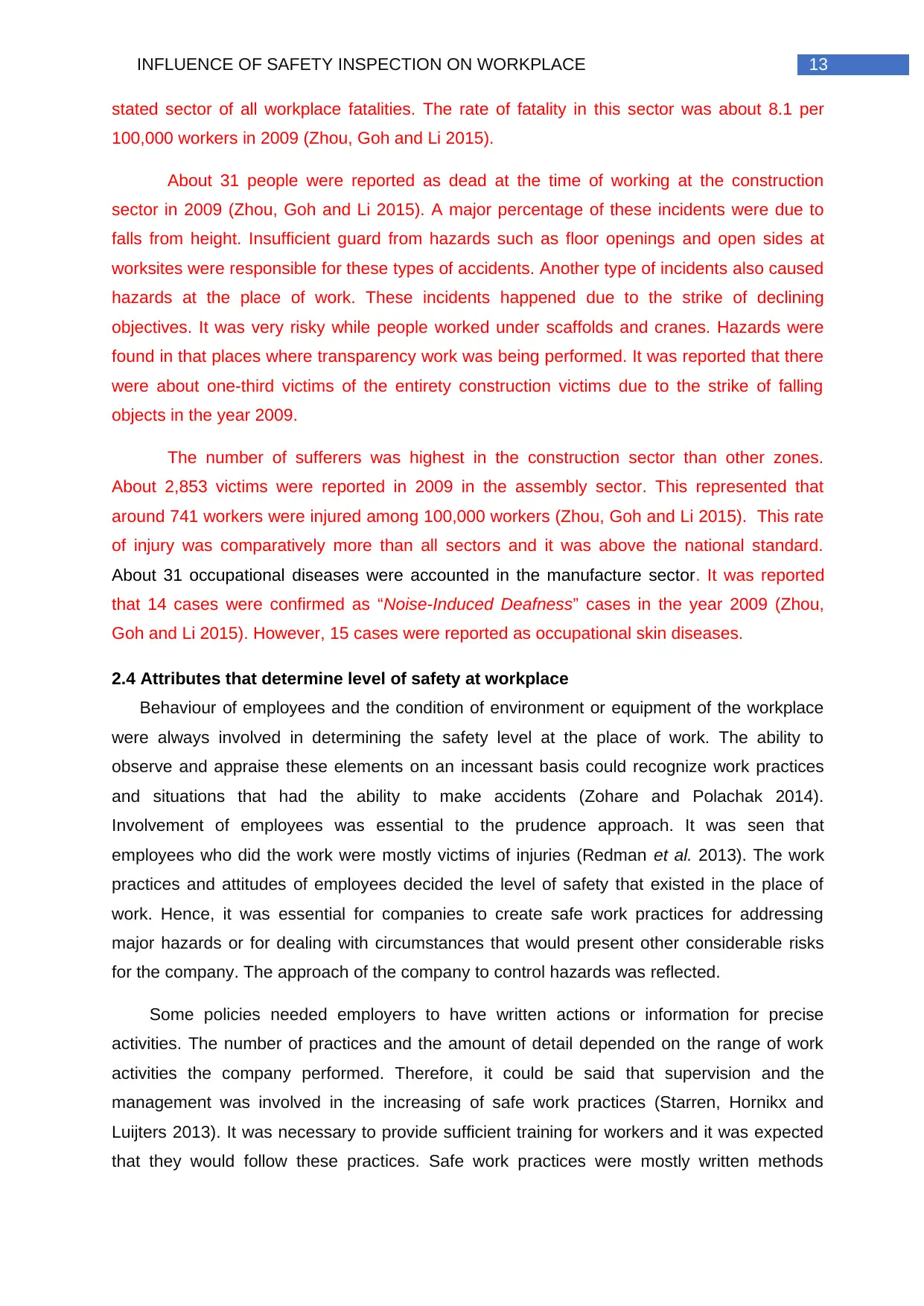
13INFLUENCE OF SAFETY INSPECTION ON WORKPLACE
stated sector of all workplace fatalities. The rate of fatality in this sector was about 8.1 per
100,000 workers in 2009 (Zhou, Goh and Li 2015).
About 31 people were reported as dead at the time of working at the construction
sector in 2009 (Zhou, Goh and Li 2015). A major percentage of these incidents were due to
falls from height. Insufficient guard from hazards such as floor openings and open sides at
worksites were responsible for these types of accidents. Another type of incidents also caused
hazards at the place of work. These incidents happened due to the strike of declining
objectives. It was very risky while people worked under scaffolds and cranes. Hazards were
found in that places where transparency work was being performed. It was reported that there
were about one-third victims of the entirety construction victims due to the strike of falling
objects in the year 2009.
The number of sufferers was highest in the construction sector than other zones.
About 2,853 victims were reported in 2009 in the assembly sector. This represented that
around 741 workers were injured among 100,000 workers (Zhou, Goh and Li 2015). This rate
of injury was comparatively more than all sectors and it was above the national standard.
About 31 occupational diseases were accounted in the manufacture sector. It was reported
that 14 cases were confirmed as “Noise-Induced Deafness” cases in the year 2009 (Zhou,
Goh and Li 2015). However, 15 cases were reported as occupational skin diseases.
2.4 Attributes that determine level of safety at workplace
Behaviour of employees and the condition of environment or equipment of the workplace
were always involved in determining the safety level at the place of work. The ability to
observe and appraise these elements on an incessant basis could recognize work practices
and situations that had the ability to make accidents (Zohare and Polachak 2014).
Involvement of employees was essential to the prudence approach. It was seen that
employees who did the work were mostly victims of injuries (Redman et al. 2013). The work
practices and attitudes of employees decided the level of safety that existed in the place of
work. Hence, it was essential for companies to create safe work practices for addressing
major hazards or for dealing with circumstances that would present other considerable risks
for the company. The approach of the company to control hazards was reflected.
Some policies needed employers to have written actions or information for precise
activities. The number of practices and the amount of detail depended on the range of work
activities the company performed. Therefore, it could be said that supervision and the
management was involved in the increasing of safe work practices (Starren, Hornikx and
Luijters 2013). It was necessary to provide sufficient training for workers and it was expected
that they would follow these practices. Safe work practices were mostly written methods
stated sector of all workplace fatalities. The rate of fatality in this sector was about 8.1 per
100,000 workers in 2009 (Zhou, Goh and Li 2015).
About 31 people were reported as dead at the time of working at the construction
sector in 2009 (Zhou, Goh and Li 2015). A major percentage of these incidents were due to
falls from height. Insufficient guard from hazards such as floor openings and open sides at
worksites were responsible for these types of accidents. Another type of incidents also caused
hazards at the place of work. These incidents happened due to the strike of declining
objectives. It was very risky while people worked under scaffolds and cranes. Hazards were
found in that places where transparency work was being performed. It was reported that there
were about one-third victims of the entirety construction victims due to the strike of falling
objects in the year 2009.
The number of sufferers was highest in the construction sector than other zones.
About 2,853 victims were reported in 2009 in the assembly sector. This represented that
around 741 workers were injured among 100,000 workers (Zhou, Goh and Li 2015). This rate
of injury was comparatively more than all sectors and it was above the national standard.
About 31 occupational diseases were accounted in the manufacture sector. It was reported
that 14 cases were confirmed as “Noise-Induced Deafness” cases in the year 2009 (Zhou,
Goh and Li 2015). However, 15 cases were reported as occupational skin diseases.
2.4 Attributes that determine level of safety at workplace
Behaviour of employees and the condition of environment or equipment of the workplace
were always involved in determining the safety level at the place of work. The ability to
observe and appraise these elements on an incessant basis could recognize work practices
and situations that had the ability to make accidents (Zohare and Polachak 2014).
Involvement of employees was essential to the prudence approach. It was seen that
employees who did the work were mostly victims of injuries (Redman et al. 2013). The work
practices and attitudes of employees decided the level of safety that existed in the place of
work. Hence, it was essential for companies to create safe work practices for addressing
major hazards or for dealing with circumstances that would present other considerable risks
for the company. The approach of the company to control hazards was reflected.
Some policies needed employers to have written actions or information for precise
activities. The number of practices and the amount of detail depended on the range of work
activities the company performed. Therefore, it could be said that supervision and the
management was involved in the increasing of safe work practices (Starren, Hornikx and
Luijters 2013). It was necessary to provide sufficient training for workers and it was expected
that they would follow these practices. Safe work practices were mostly written methods
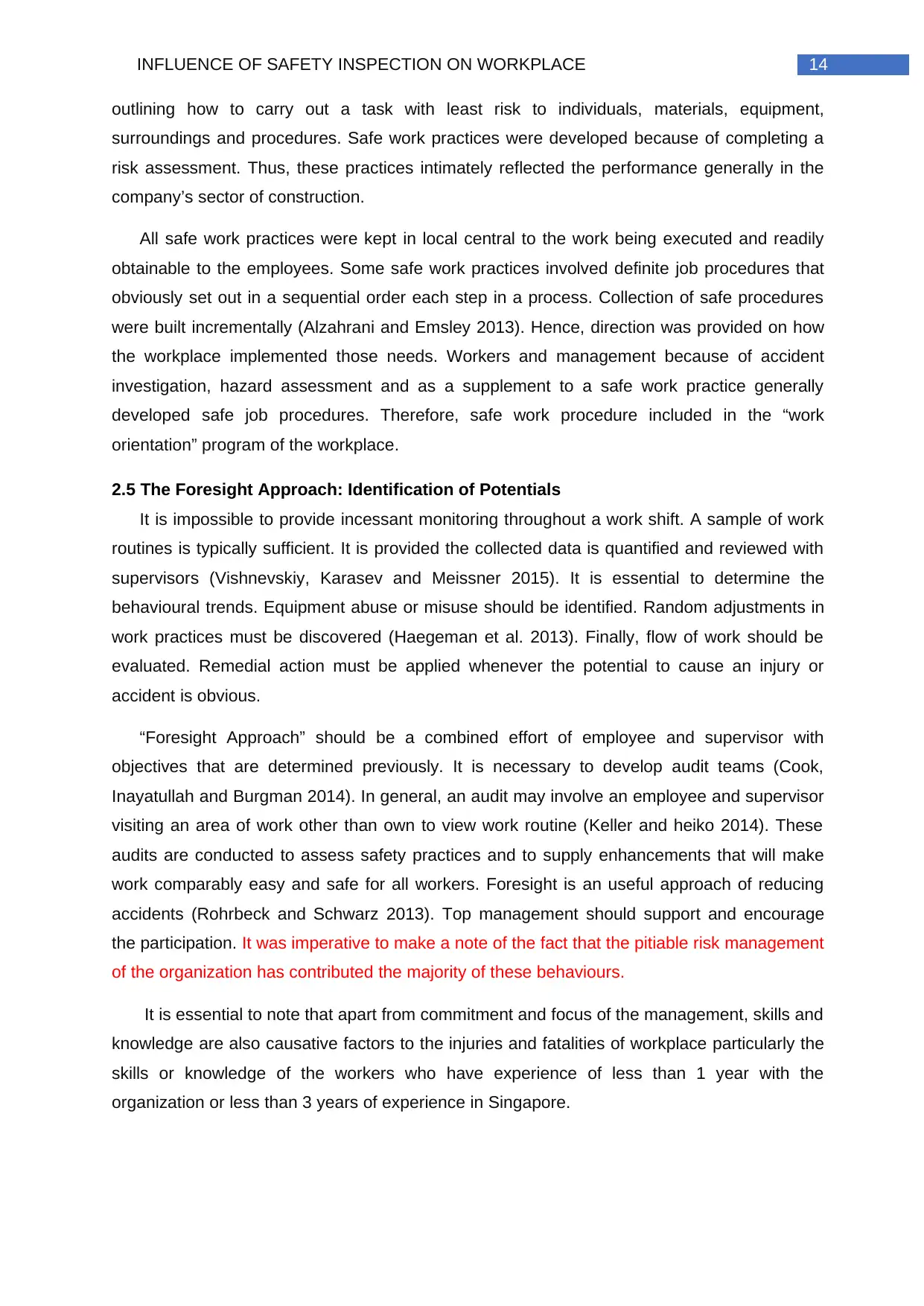
14INFLUENCE OF SAFETY INSPECTION ON WORKPLACE
outlining how to carry out a task with least risk to individuals, materials, equipment,
surroundings and procedures. Safe work practices were developed because of completing a
risk assessment. Thus, these practices intimately reflected the performance generally in the
company’s sector of construction.
All safe work practices were kept in local central to the work being executed and readily
obtainable to the employees. Some safe work practices involved definite job procedures that
obviously set out in a sequential order each step in a process. Collection of safe procedures
were built incrementally (Alzahrani and Emsley 2013). Hence, direction was provided on how
the workplace implemented those needs. Workers and management because of accident
investigation, hazard assessment and as a supplement to a safe work practice generally
developed safe job procedures. Therefore, safe work procedure included in the “work
orientation” program of the workplace.
2.5 The Foresight Approach: Identification of Potentials
It is impossible to provide incessant monitoring throughout a work shift. A sample of work
routines is typically sufficient. It is provided the collected data is quantified and reviewed with
supervisors (Vishnevskiy, Karasev and Meissner 2015). It is essential to determine the
behavioural trends. Equipment abuse or misuse should be identified. Random adjustments in
work practices must be discovered (Haegeman et al. 2013). Finally, flow of work should be
evaluated. Remedial action must be applied whenever the potential to cause an injury or
accident is obvious.
“Foresight Approach” should be a combined effort of employee and supervisor with
objectives that are determined previously. It is necessary to develop audit teams (Cook,
Inayatullah and Burgman 2014). In general, an audit may involve an employee and supervisor
visiting an area of work other than own to view work routine (Keller and heiko 2014). These
audits are conducted to assess safety practices and to supply enhancements that will make
work comparably easy and safe for all workers. Foresight is an useful approach of reducing
accidents (Rohrbeck and Schwarz 2013). Top management should support and encourage
the participation. It was imperative to make a note of the fact that the pitiable risk management
of the organization has contributed the majority of these behaviours.
It is essential to note that apart from commitment and focus of the management, skills and
knowledge are also causative factors to the injuries and fatalities of workplace particularly the
skills or knowledge of the workers who have experience of less than 1 year with the
organization or less than 3 years of experience in Singapore.
outlining how to carry out a task with least risk to individuals, materials, equipment,
surroundings and procedures. Safe work practices were developed because of completing a
risk assessment. Thus, these practices intimately reflected the performance generally in the
company’s sector of construction.
All safe work practices were kept in local central to the work being executed and readily
obtainable to the employees. Some safe work practices involved definite job procedures that
obviously set out in a sequential order each step in a process. Collection of safe procedures
were built incrementally (Alzahrani and Emsley 2013). Hence, direction was provided on how
the workplace implemented those needs. Workers and management because of accident
investigation, hazard assessment and as a supplement to a safe work practice generally
developed safe job procedures. Therefore, safe work procedure included in the “work
orientation” program of the workplace.
2.5 The Foresight Approach: Identification of Potentials
It is impossible to provide incessant monitoring throughout a work shift. A sample of work
routines is typically sufficient. It is provided the collected data is quantified and reviewed with
supervisors (Vishnevskiy, Karasev and Meissner 2015). It is essential to determine the
behavioural trends. Equipment abuse or misuse should be identified. Random adjustments in
work practices must be discovered (Haegeman et al. 2013). Finally, flow of work should be
evaluated. Remedial action must be applied whenever the potential to cause an injury or
accident is obvious.
“Foresight Approach” should be a combined effort of employee and supervisor with
objectives that are determined previously. It is necessary to develop audit teams (Cook,
Inayatullah and Burgman 2014). In general, an audit may involve an employee and supervisor
visiting an area of work other than own to view work routine (Keller and heiko 2014). These
audits are conducted to assess safety practices and to supply enhancements that will make
work comparably easy and safe for all workers. Foresight is an useful approach of reducing
accidents (Rohrbeck and Schwarz 2013). Top management should support and encourage
the participation. It was imperative to make a note of the fact that the pitiable risk management
of the organization has contributed the majority of these behaviours.
It is essential to note that apart from commitment and focus of the management, skills and
knowledge are also causative factors to the injuries and fatalities of workplace particularly the
skills or knowledge of the workers who have experience of less than 1 year with the
organization or less than 3 years of experience in Singapore.
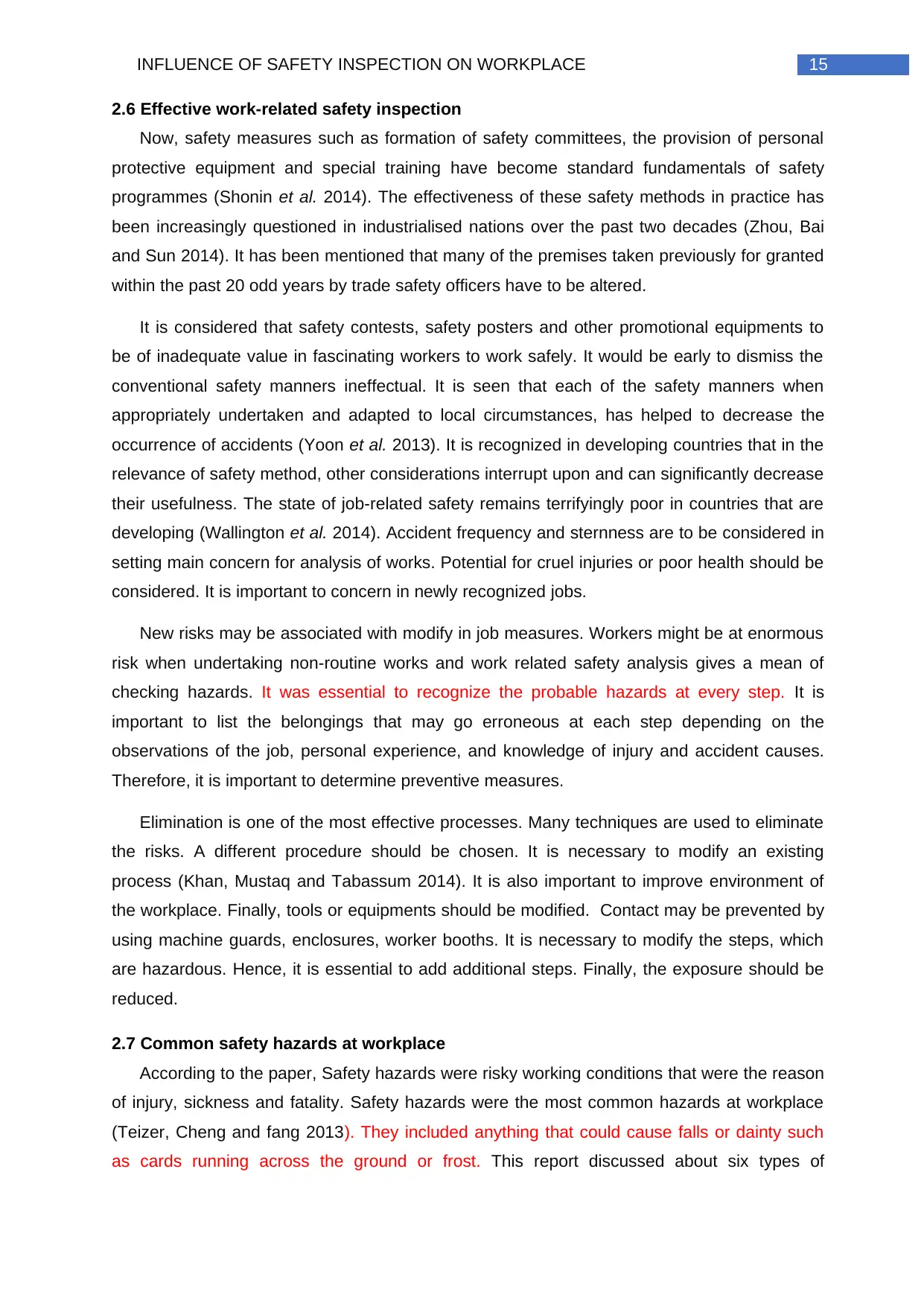
15INFLUENCE OF SAFETY INSPECTION ON WORKPLACE
2.6 Effective work-related safety inspection
Now, safety measures such as formation of safety committees, the provision of personal
protective equipment and special training have become standard fundamentals of safety
programmes (Shonin et al. 2014). The effectiveness of these safety methods in practice has
been increasingly questioned in industrialised nations over the past two decades (Zhou, Bai
and Sun 2014). It has been mentioned that many of the premises taken previously for granted
within the past 20 odd years by trade safety officers have to be altered.
It is considered that safety contests, safety posters and other promotional equipments to
be of inadequate value in fascinating workers to work safely. It would be early to dismiss the
conventional safety manners ineffectual. It is seen that each of the safety manners when
appropriately undertaken and adapted to local circumstances, has helped to decrease the
occurrence of accidents (Yoon et al. 2013). It is recognized in developing countries that in the
relevance of safety method, other considerations interrupt upon and can significantly decrease
their usefulness. The state of job-related safety remains terrifyingly poor in countries that are
developing (Wallington et al. 2014). Accident frequency and sternness are to be considered in
setting main concern for analysis of works. Potential for cruel injuries or poor health should be
considered. It is important to concern in newly recognized jobs.
New risks may be associated with modify in job measures. Workers might be at enormous
risk when undertaking non-routine works and work related safety analysis gives a mean of
checking hazards. It was essential to recognize the probable hazards at every step. It is
important to list the belongings that may go erroneous at each step depending on the
observations of the job, personal experience, and knowledge of injury and accident causes.
Therefore, it is important to determine preventive measures.
Elimination is one of the most effective processes. Many techniques are used to eliminate
the risks. A different procedure should be chosen. It is necessary to modify an existing
process (Khan, Mustaq and Tabassum 2014). It is also important to improve environment of
the workplace. Finally, tools or equipments should be modified. Contact may be prevented by
using machine guards, enclosures, worker booths. It is necessary to modify the steps, which
are hazardous. Hence, it is essential to add additional steps. Finally, the exposure should be
reduced.
2.7 Common safety hazards at workplace
According to the paper, Safety hazards were risky working conditions that were the reason
of injury, sickness and fatality. Safety hazards were the most common hazards at workplace
(Teizer, Cheng and fang 2013). They included anything that could cause falls or dainty such
as cards running across the ground or frost. This report discussed about six types of
2.6 Effective work-related safety inspection
Now, safety measures such as formation of safety committees, the provision of personal
protective equipment and special training have become standard fundamentals of safety
programmes (Shonin et al. 2014). The effectiveness of these safety methods in practice has
been increasingly questioned in industrialised nations over the past two decades (Zhou, Bai
and Sun 2014). It has been mentioned that many of the premises taken previously for granted
within the past 20 odd years by trade safety officers have to be altered.
It is considered that safety contests, safety posters and other promotional equipments to
be of inadequate value in fascinating workers to work safely. It would be early to dismiss the
conventional safety manners ineffectual. It is seen that each of the safety manners when
appropriately undertaken and adapted to local circumstances, has helped to decrease the
occurrence of accidents (Yoon et al. 2013). It is recognized in developing countries that in the
relevance of safety method, other considerations interrupt upon and can significantly decrease
their usefulness. The state of job-related safety remains terrifyingly poor in countries that are
developing (Wallington et al. 2014). Accident frequency and sternness are to be considered in
setting main concern for analysis of works. Potential for cruel injuries or poor health should be
considered. It is important to concern in newly recognized jobs.
New risks may be associated with modify in job measures. Workers might be at enormous
risk when undertaking non-routine works and work related safety analysis gives a mean of
checking hazards. It was essential to recognize the probable hazards at every step. It is
important to list the belongings that may go erroneous at each step depending on the
observations of the job, personal experience, and knowledge of injury and accident causes.
Therefore, it is important to determine preventive measures.
Elimination is one of the most effective processes. Many techniques are used to eliminate
the risks. A different procedure should be chosen. It is necessary to modify an existing
process (Khan, Mustaq and Tabassum 2014). It is also important to improve environment of
the workplace. Finally, tools or equipments should be modified. Contact may be prevented by
using machine guards, enclosures, worker booths. It is necessary to modify the steps, which
are hazardous. Hence, it is essential to add additional steps. Finally, the exposure should be
reduced.
2.7 Common safety hazards at workplace
According to the paper, Safety hazards were risky working conditions that were the reason
of injury, sickness and fatality. Safety hazards were the most common hazards at workplace
(Teizer, Cheng and fang 2013). They included anything that could cause falls or dainty such
as cards running across the ground or frost. This report discussed about six types of
Secure Best Marks with AI Grader
Need help grading? Try our AI Grader for instant feedback on your assignments.
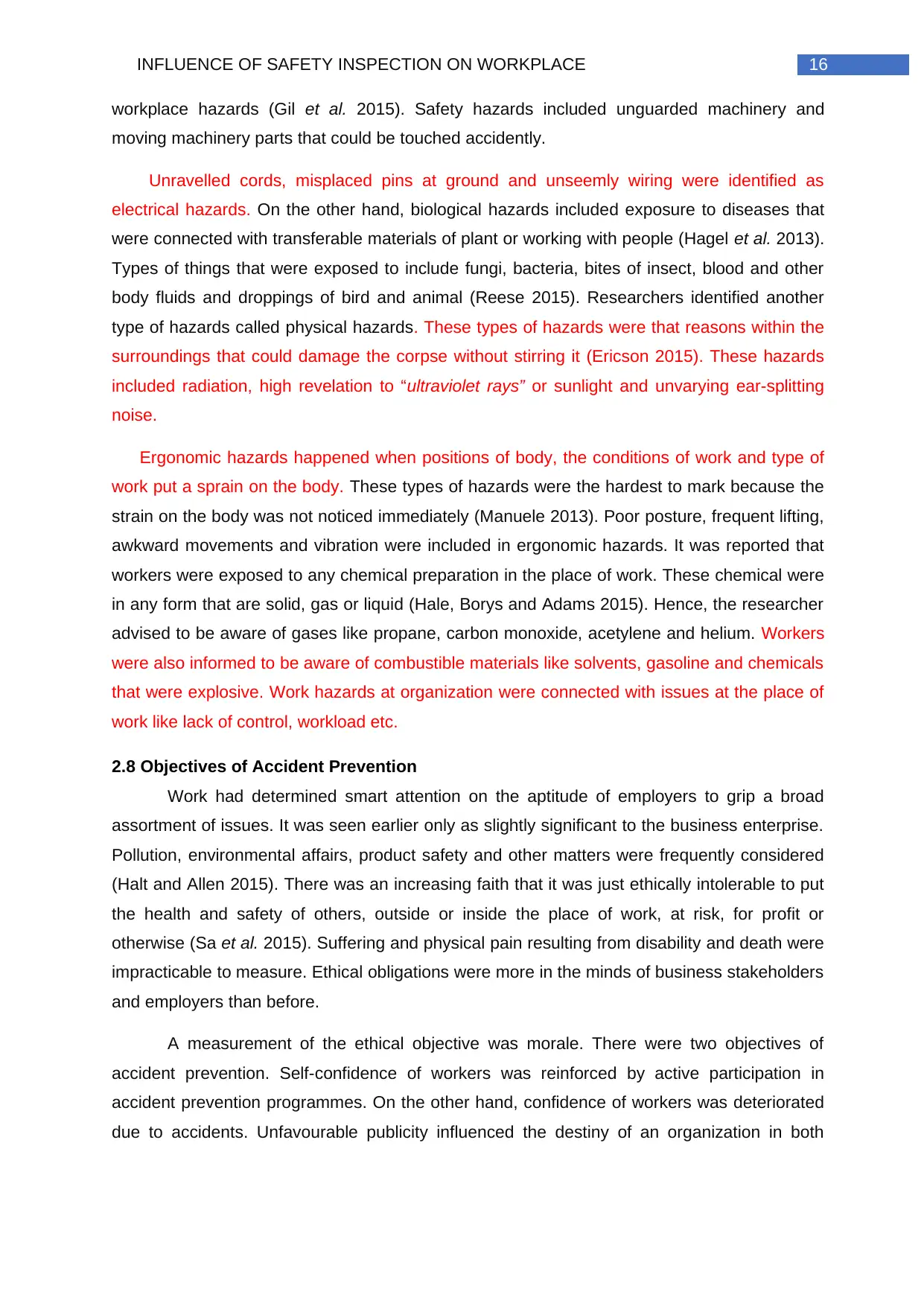
16INFLUENCE OF SAFETY INSPECTION ON WORKPLACE
workplace hazards (Gil et al. 2015). Safety hazards included unguarded machinery and
moving machinery parts that could be touched accidently.
Unravelled cords, misplaced pins at ground and unseemly wiring were identified as
electrical hazards. On the other hand, biological hazards included exposure to diseases that
were connected with transferable materials of plant or working with people (Hagel et al. 2013).
Types of things that were exposed to include fungi, bacteria, bites of insect, blood and other
body fluids and droppings of bird and animal (Reese 2015). Researchers identified another
type of hazards called physical hazards. These types of hazards were that reasons within the
surroundings that could damage the corpse without stirring it (Ericson 2015). These hazards
included radiation, high revelation to “ultraviolet rays” or sunlight and unvarying ear-splitting
noise.
Ergonomic hazards happened when positions of body, the conditions of work and type of
work put a sprain on the body. These types of hazards were the hardest to mark because the
strain on the body was not noticed immediately (Manuele 2013). Poor posture, frequent lifting,
awkward movements and vibration were included in ergonomic hazards. It was reported that
workers were exposed to any chemical preparation in the place of work. These chemical were
in any form that are solid, gas or liquid (Hale, Borys and Adams 2015). Hence, the researcher
advised to be aware of gases like propane, carbon monoxide, acetylene and helium. Workers
were also informed to be aware of combustible materials like solvents, gasoline and chemicals
that were explosive. Work hazards at organization were connected with issues at the place of
work like lack of control, workload etc.
2.8 Objectives of Accident Prevention
Work had determined smart attention on the aptitude of employers to grip a broad
assortment of issues. It was seen earlier only as slightly significant to the business enterprise.
Pollution, environmental affairs, product safety and other matters were frequently considered
(Halt and Allen 2015). There was an increasing faith that it was just ethically intolerable to put
the health and safety of others, outside or inside the place of work, at risk, for profit or
otherwise (Sa et al. 2015). Suffering and physical pain resulting from disability and death were
impracticable to measure. Ethical obligations were more in the minds of business stakeholders
and employers than before.
A measurement of the ethical objective was morale. There were two objectives of
accident prevention. Self-confidence of workers was reinforced by active participation in
accident prevention programmes. On the other hand, confidence of workers was deteriorated
due to accidents. Unfavourable publicity influenced the destiny of an organization in both
workplace hazards (Gil et al. 2015). Safety hazards included unguarded machinery and
moving machinery parts that could be touched accidently.
Unravelled cords, misplaced pins at ground and unseemly wiring were identified as
electrical hazards. On the other hand, biological hazards included exposure to diseases that
were connected with transferable materials of plant or working with people (Hagel et al. 2013).
Types of things that were exposed to include fungi, bacteria, bites of insect, blood and other
body fluids and droppings of bird and animal (Reese 2015). Researchers identified another
type of hazards called physical hazards. These types of hazards were that reasons within the
surroundings that could damage the corpse without stirring it (Ericson 2015). These hazards
included radiation, high revelation to “ultraviolet rays” or sunlight and unvarying ear-splitting
noise.
Ergonomic hazards happened when positions of body, the conditions of work and type of
work put a sprain on the body. These types of hazards were the hardest to mark because the
strain on the body was not noticed immediately (Manuele 2013). Poor posture, frequent lifting,
awkward movements and vibration were included in ergonomic hazards. It was reported that
workers were exposed to any chemical preparation in the place of work. These chemical were
in any form that are solid, gas or liquid (Hale, Borys and Adams 2015). Hence, the researcher
advised to be aware of gases like propane, carbon monoxide, acetylene and helium. Workers
were also informed to be aware of combustible materials like solvents, gasoline and chemicals
that were explosive. Work hazards at organization were connected with issues at the place of
work like lack of control, workload etc.
2.8 Objectives of Accident Prevention
Work had determined smart attention on the aptitude of employers to grip a broad
assortment of issues. It was seen earlier only as slightly significant to the business enterprise.
Pollution, environmental affairs, product safety and other matters were frequently considered
(Halt and Allen 2015). There was an increasing faith that it was just ethically intolerable to put
the health and safety of others, outside or inside the place of work, at risk, for profit or
otherwise (Sa et al. 2015). Suffering and physical pain resulting from disability and death were
impracticable to measure. Ethical obligations were more in the minds of business stakeholders
and employers than before.
A measurement of the ethical objective was morale. There were two objectives of
accident prevention. Self-confidence of workers was reinforced by active participation in
accident prevention programmes. On the other hand, confidence of workers was deteriorated
due to accidents. Unfavourable publicity influenced the destiny of an organization in both
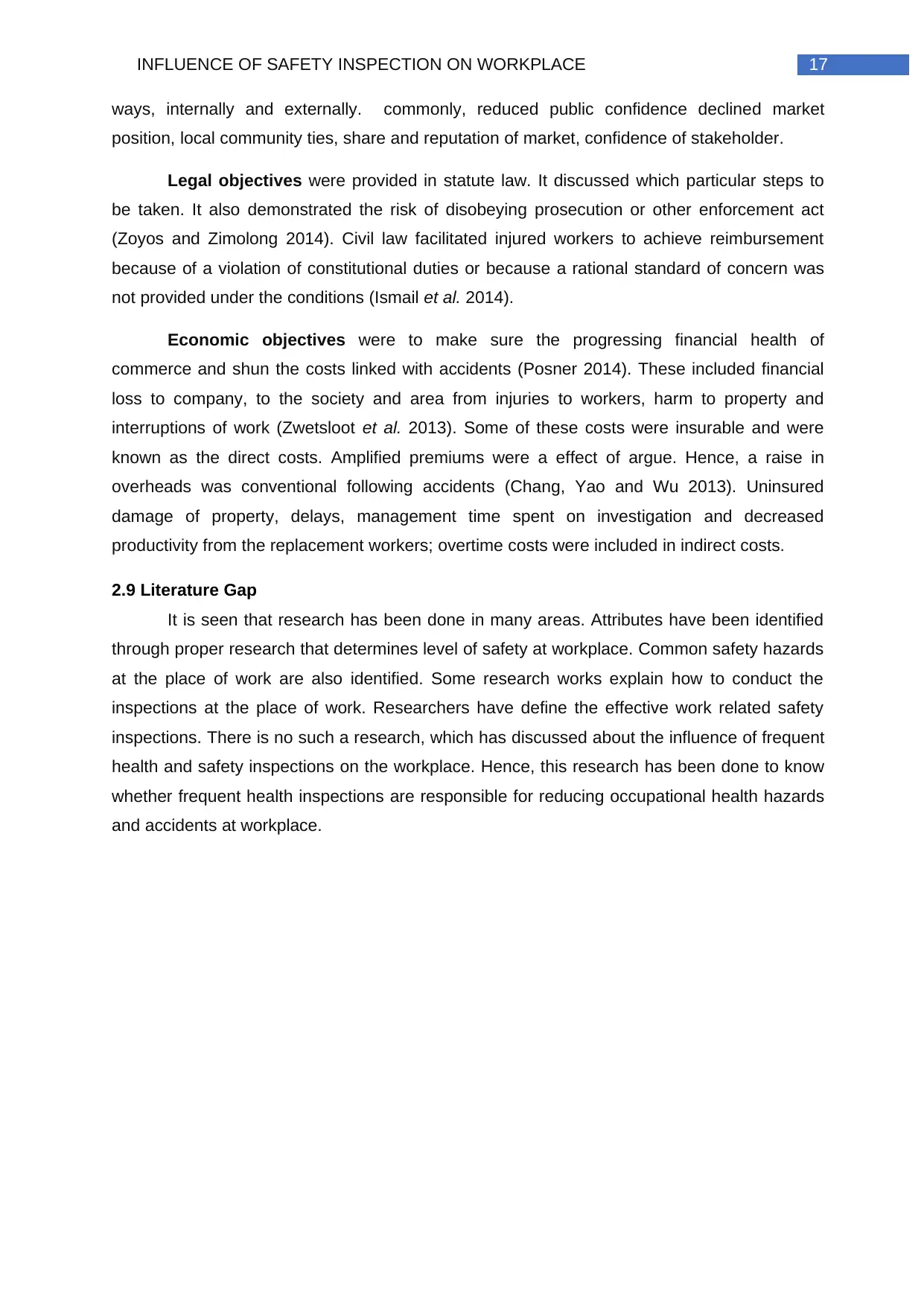
17INFLUENCE OF SAFETY INSPECTION ON WORKPLACE
ways, internally and externally. commonly, reduced public confidence declined market
position, local community ties, share and reputation of market, confidence of stakeholder.
Legal objectives were provided in statute law. It discussed which particular steps to
be taken. It also demonstrated the risk of disobeying prosecution or other enforcement act
(Zoyos and Zimolong 2014). Civil law facilitated injured workers to achieve reimbursement
because of a violation of constitutional duties or because a rational standard of concern was
not provided under the conditions (Ismail et al. 2014).
Economic objectives were to make sure the progressing financial health of
commerce and shun the costs linked with accidents (Posner 2014). These included financial
loss to company, to the society and area from injuries to workers, harm to property and
interruptions of work (Zwetsloot et al. 2013). Some of these costs were insurable and were
known as the direct costs. Amplified premiums were a effect of argue. Hence, a raise in
overheads was conventional following accidents (Chang, Yao and Wu 2013). Uninsured
damage of property, delays, management time spent on investigation and decreased
productivity from the replacement workers; overtime costs were included in indirect costs.
2.9 Literature Gap
It is seen that research has been done in many areas. Attributes have been identified
through proper research that determines level of safety at workplace. Common safety hazards
at the place of work are also identified. Some research works explain how to conduct the
inspections at the place of work. Researchers have define the effective work related safety
inspections. There is no such a research, which has discussed about the influence of frequent
health and safety inspections on the workplace. Hence, this research has been done to know
whether frequent health inspections are responsible for reducing occupational health hazards
and accidents at workplace.
ways, internally and externally. commonly, reduced public confidence declined market
position, local community ties, share and reputation of market, confidence of stakeholder.
Legal objectives were provided in statute law. It discussed which particular steps to
be taken. It also demonstrated the risk of disobeying prosecution or other enforcement act
(Zoyos and Zimolong 2014). Civil law facilitated injured workers to achieve reimbursement
because of a violation of constitutional duties or because a rational standard of concern was
not provided under the conditions (Ismail et al. 2014).
Economic objectives were to make sure the progressing financial health of
commerce and shun the costs linked with accidents (Posner 2014). These included financial
loss to company, to the society and area from injuries to workers, harm to property and
interruptions of work (Zwetsloot et al. 2013). Some of these costs were insurable and were
known as the direct costs. Amplified premiums were a effect of argue. Hence, a raise in
overheads was conventional following accidents (Chang, Yao and Wu 2013). Uninsured
damage of property, delays, management time spent on investigation and decreased
productivity from the replacement workers; overtime costs were included in indirect costs.
2.9 Literature Gap
It is seen that research has been done in many areas. Attributes have been identified
through proper research that determines level of safety at workplace. Common safety hazards
at the place of work are also identified. Some research works explain how to conduct the
inspections at the place of work. Researchers have define the effective work related safety
inspections. There is no such a research, which has discussed about the influence of frequent
health and safety inspections on the workplace. Hence, this research has been done to know
whether frequent health inspections are responsible for reducing occupational health hazards
and accidents at workplace.
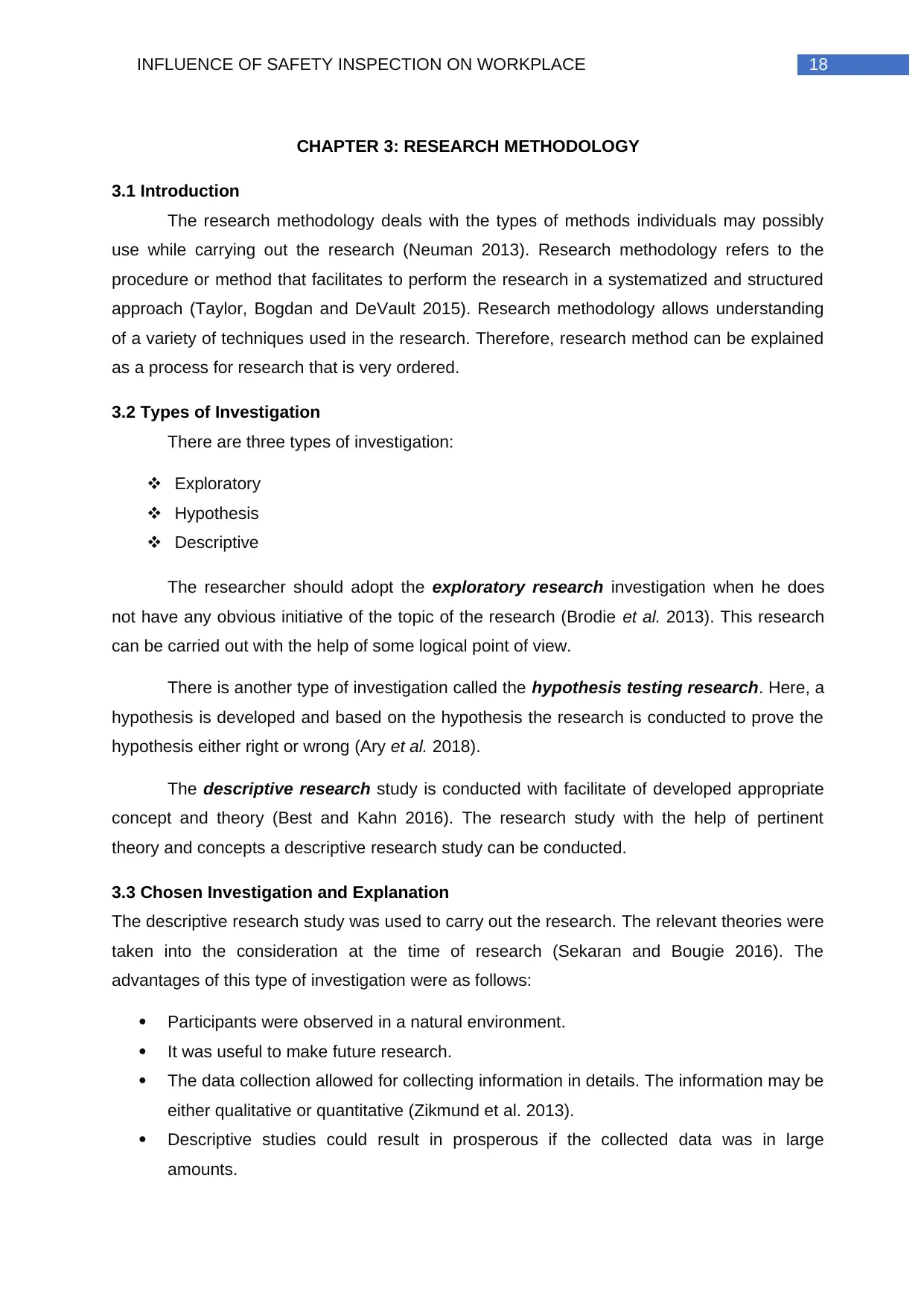
18INFLUENCE OF SAFETY INSPECTION ON WORKPLACE
CHAPTER 3: RESEARCH METHODOLOGY
3.1 Introduction
The research methodology deals with the types of methods individuals may possibly
use while carrying out the research (Neuman 2013). Research methodology refers to the
procedure or method that facilitates to perform the research in a systematized and structured
approach (Taylor, Bogdan and DeVault 2015). Research methodology allows understanding
of a variety of techniques used in the research. Therefore, research method can be explained
as a process for research that is very ordered.
3.2 Types of Investigation
There are three types of investigation:
Exploratory
Hypothesis
Descriptive
The researcher should adopt the exploratory research investigation when he does
not have any obvious initiative of the topic of the research (Brodie et al. 2013). This research
can be carried out with the help of some logical point of view.
There is another type of investigation called the hypothesis testing research. Here, a
hypothesis is developed and based on the hypothesis the research is conducted to prove the
hypothesis either right or wrong (Ary et al. 2018).
The descriptive research study is conducted with facilitate of developed appropriate
concept and theory (Best and Kahn 2016). The research study with the help of pertinent
theory and concepts a descriptive research study can be conducted.
3.3 Chosen Investigation and Explanation
The descriptive research study was used to carry out the research. The relevant theories were
taken into the consideration at the time of research (Sekaran and Bougie 2016). The
advantages of this type of investigation were as follows:
Participants were observed in a natural environment.
It was useful to make future research.
The data collection allowed for collecting information in details. The information may be
either qualitative or quantitative (Zikmund et al. 2013).
Descriptive studies could result in prosperous if the collected data was in large
amounts.
CHAPTER 3: RESEARCH METHODOLOGY
3.1 Introduction
The research methodology deals with the types of methods individuals may possibly
use while carrying out the research (Neuman 2013). Research methodology refers to the
procedure or method that facilitates to perform the research in a systematized and structured
approach (Taylor, Bogdan and DeVault 2015). Research methodology allows understanding
of a variety of techniques used in the research. Therefore, research method can be explained
as a process for research that is very ordered.
3.2 Types of Investigation
There are three types of investigation:
Exploratory
Hypothesis
Descriptive
The researcher should adopt the exploratory research investigation when he does
not have any obvious initiative of the topic of the research (Brodie et al. 2013). This research
can be carried out with the help of some logical point of view.
There is another type of investigation called the hypothesis testing research. Here, a
hypothesis is developed and based on the hypothesis the research is conducted to prove the
hypothesis either right or wrong (Ary et al. 2018).
The descriptive research study is conducted with facilitate of developed appropriate
concept and theory (Best and Kahn 2016). The research study with the help of pertinent
theory and concepts a descriptive research study can be conducted.
3.3 Chosen Investigation and Explanation
The descriptive research study was used to carry out the research. The relevant theories were
taken into the consideration at the time of research (Sekaran and Bougie 2016). The
advantages of this type of investigation were as follows:
Participants were observed in a natural environment.
It was useful to make future research.
The data collection allowed for collecting information in details. The information may be
either qualitative or quantitative (Zikmund et al. 2013).
Descriptive studies could result in prosperous if the collected data was in large
amounts.
Paraphrase This Document
Need a fresh take? Get an instant paraphrase of this document with our AI Paraphraser
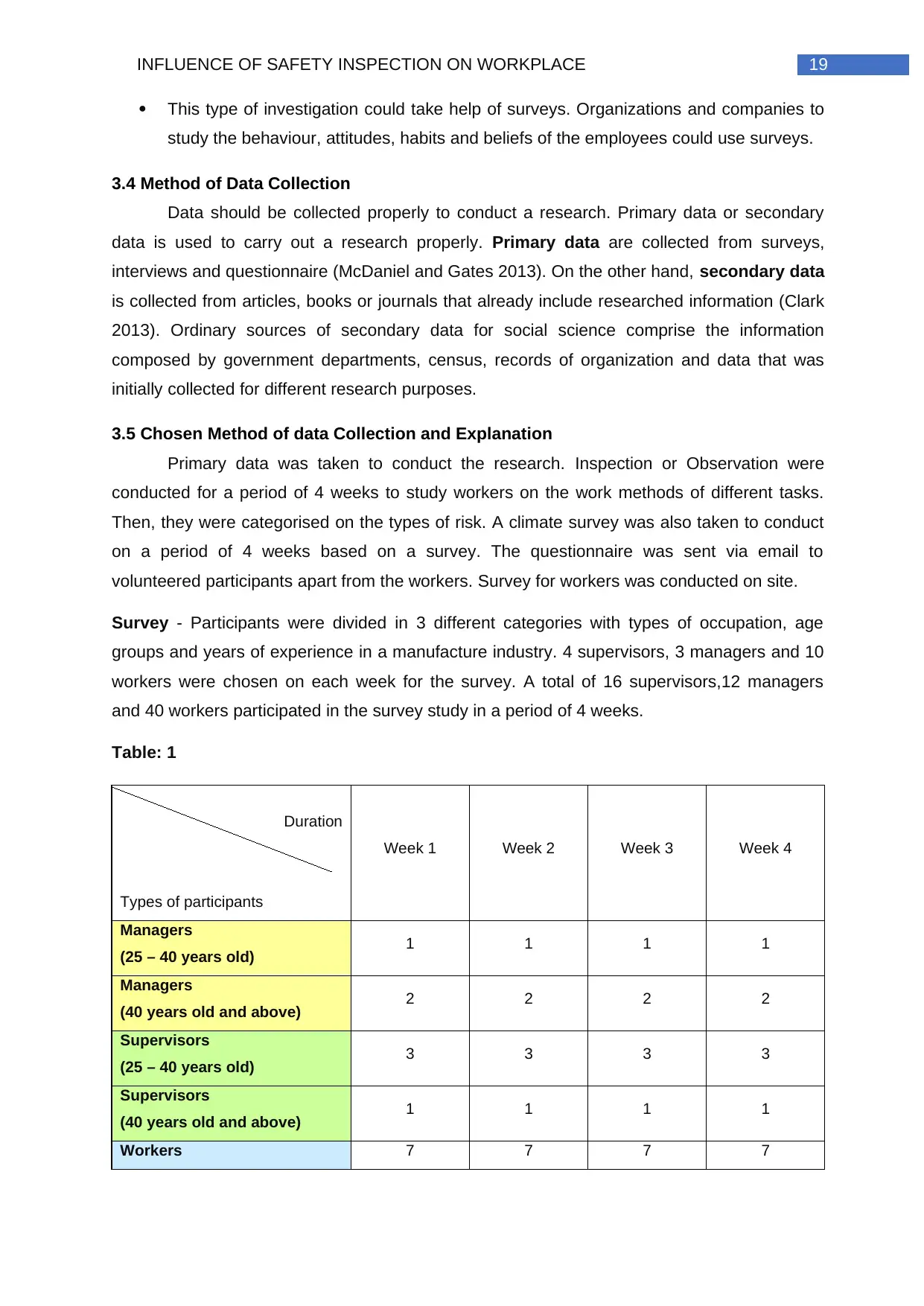
19INFLUENCE OF SAFETY INSPECTION ON WORKPLACE
This type of investigation could take help of surveys. Organizations and companies to
study the behaviour, attitudes, habits and beliefs of the employees could use surveys.
3.4 Method of Data Collection
Data should be collected properly to conduct a research. Primary data or secondary
data is used to carry out a research properly. Primary data are collected from surveys,
interviews and questionnaire (McDaniel and Gates 2013). On the other hand, secondary data
is collected from articles, books or journals that already include researched information (Clark
2013). Ordinary sources of secondary data for social science comprise the information
composed by government departments, census, records of organization and data that was
initially collected for different research purposes.
3.5 Chosen Method of data Collection and Explanation
Primary data was taken to conduct the research. Inspection or Observation were
conducted for a period of 4 weeks to study workers on the work methods of different tasks.
Then, they were categorised on the types of risk. A climate survey was also taken to conduct
on a period of 4 weeks based on a survey. The questionnaire was sent via email to
volunteered participants apart from the workers. Survey for workers was conducted on site.
Survey - Participants were divided in 3 different categories with types of occupation, age
groups and years of experience in a manufacture industry. 4 supervisors, 3 managers and 10
workers were chosen on each week for the survey. A total of 16 supervisors,12 managers
and 40 workers participated in the survey study in a period of 4 weeks.
Table: 1
Duration
Types of participants
Week 1 Week 2 Week 3 Week 4
Managers
(25 – 40 years old) 1 1 1 1
Managers
(40 years old and above) 2 2 2 2
Supervisors
(25 – 40 years old) 3 3 3 3
Supervisors
(40 years old and above) 1 1 1 1
Workers 7 7 7 7
This type of investigation could take help of surveys. Organizations and companies to
study the behaviour, attitudes, habits and beliefs of the employees could use surveys.
3.4 Method of Data Collection
Data should be collected properly to conduct a research. Primary data or secondary
data is used to carry out a research properly. Primary data are collected from surveys,
interviews and questionnaire (McDaniel and Gates 2013). On the other hand, secondary data
is collected from articles, books or journals that already include researched information (Clark
2013). Ordinary sources of secondary data for social science comprise the information
composed by government departments, census, records of organization and data that was
initially collected for different research purposes.
3.5 Chosen Method of data Collection and Explanation
Primary data was taken to conduct the research. Inspection or Observation were
conducted for a period of 4 weeks to study workers on the work methods of different tasks.
Then, they were categorised on the types of risk. A climate survey was also taken to conduct
on a period of 4 weeks based on a survey. The questionnaire was sent via email to
volunteered participants apart from the workers. Survey for workers was conducted on site.
Survey - Participants were divided in 3 different categories with types of occupation, age
groups and years of experience in a manufacture industry. 4 supervisors, 3 managers and 10
workers were chosen on each week for the survey. A total of 16 supervisors,12 managers
and 40 workers participated in the survey study in a period of 4 weeks.
Table: 1
Duration
Types of participants
Week 1 Week 2 Week 3 Week 4
Managers
(25 – 40 years old) 1 1 1 1
Managers
(40 years old and above) 2 2 2 2
Supervisors
(25 – 40 years old) 3 3 3 3
Supervisors
(40 years old and above) 1 1 1 1
Workers 7 7 7 7
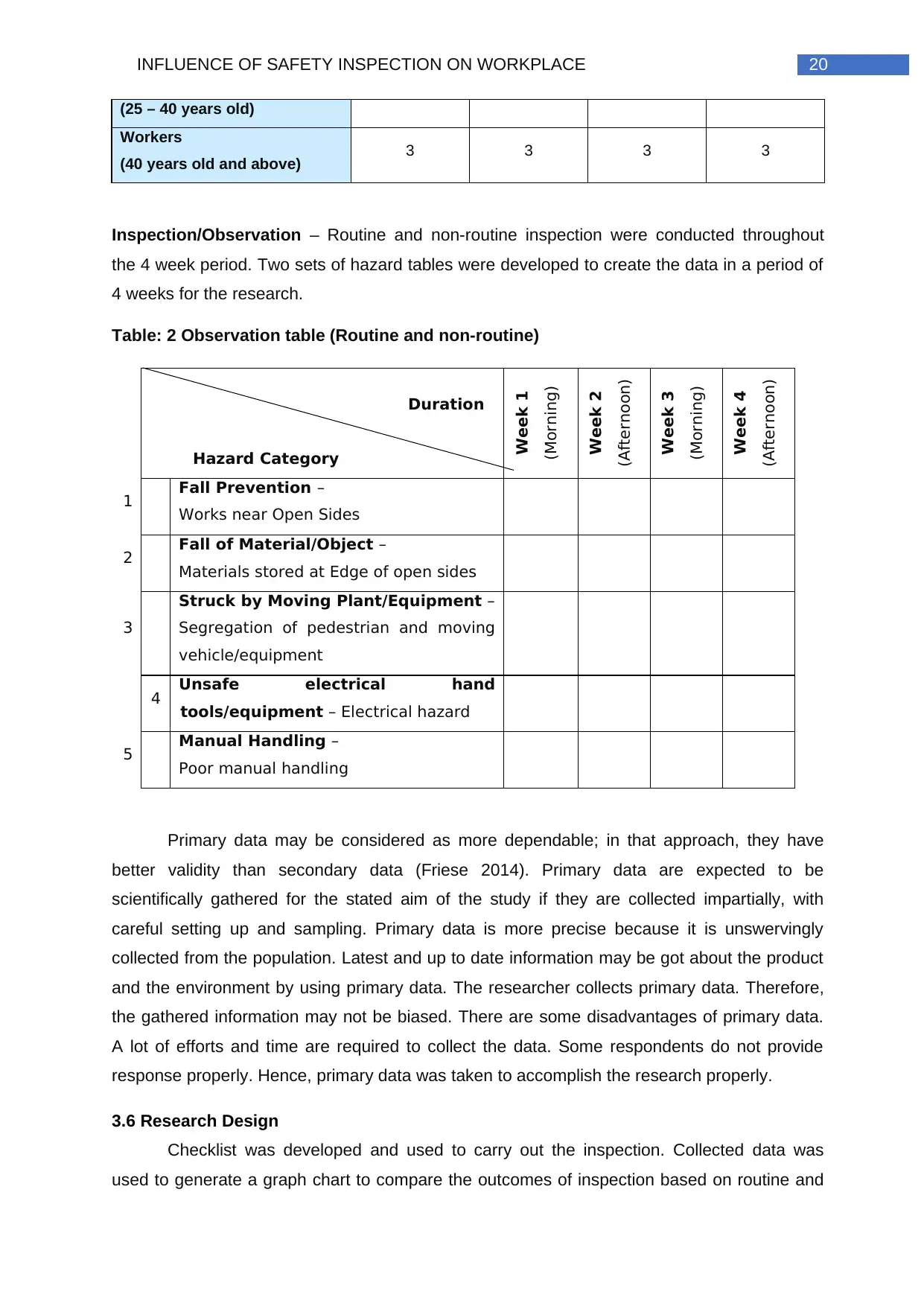
20INFLUENCE OF SAFETY INSPECTION ON WORKPLACE
(25 – 40 years old)
Workers
(40 years old and above) 3 3 3 3
Inspection/Observation – Routine and non-routine inspection were conducted throughout
the 4 week period. Two sets of hazard tables were developed to create the data in a period of
4 weeks for the research.
Table: 2 Observation table (Routine and non-routine)
Duration
Hazard Category
Week 1
(Morning)
Week 2
(Afternoon)
Week 3
(Morning)
Week 4
(Afternoon)
1 Fall Prevention –
Works near Open Sides
2 Fall of Material/Object –
Materials stored at Edge of open sides
3
Struck by Moving Plant/Equipment –
Segregation of pedestrian and moving
vehicle/equipment
4 Unsafe electrical hand
tools/equipment – Electrical hazard
5 Manual Handling –
Poor manual handling
Primary data may be considered as more dependable; in that approach, they have
better validity than secondary data (Friese 2014). Primary data are expected to be
scientifically gathered for the stated aim of the study if they are collected impartially, with
careful setting up and sampling. Primary data is more precise because it is unswervingly
collected from the population. Latest and up to date information may be got about the product
and the environment by using primary data. The researcher collects primary data. Therefore,
the gathered information may not be biased. There are some disadvantages of primary data.
A lot of efforts and time are required to collect the data. Some respondents do not provide
response properly. Hence, primary data was taken to accomplish the research properly.
3.6 Research Design
Checklist was developed and used to carry out the inspection. Collected data was
used to generate a graph chart to compare the outcomes of inspection based on routine and
(25 – 40 years old)
Workers
(40 years old and above) 3 3 3 3
Inspection/Observation – Routine and non-routine inspection were conducted throughout
the 4 week period. Two sets of hazard tables were developed to create the data in a period of
4 weeks for the research.
Table: 2 Observation table (Routine and non-routine)
Duration
Hazard Category
Week 1
(Morning)
Week 2
(Afternoon)
Week 3
(Morning)
Week 4
(Afternoon)
1 Fall Prevention –
Works near Open Sides
2 Fall of Material/Object –
Materials stored at Edge of open sides
3
Struck by Moving Plant/Equipment –
Segregation of pedestrian and moving
vehicle/equipment
4 Unsafe electrical hand
tools/equipment – Electrical hazard
5 Manual Handling –
Poor manual handling
Primary data may be considered as more dependable; in that approach, they have
better validity than secondary data (Friese 2014). Primary data are expected to be
scientifically gathered for the stated aim of the study if they are collected impartially, with
careful setting up and sampling. Primary data is more precise because it is unswervingly
collected from the population. Latest and up to date information may be got about the product
and the environment by using primary data. The researcher collects primary data. Therefore,
the gathered information may not be biased. There are some disadvantages of primary data.
A lot of efforts and time are required to collect the data. Some respondents do not provide
response properly. Hence, primary data was taken to accomplish the research properly.
3.6 Research Design
Checklist was developed and used to carry out the inspection. Collected data was
used to generate a graph chart to compare the outcomes of inspection based on routine and

21INFLUENCE OF SAFETY INSPECTION ON WORKPLACE
non-routine safety inspection. The survey and observation data were analysed to get the
statistics of the worksite practices and outcomes of the construction worksite. This made the
understanding of the accident rates in the company.
3.7 Ethical Issues
There were so many ethical issues in this survey program. These were related with the
gathering of the individual information that could be an interest to the association commercial
rivals. Thus, it was important to prevent these ethical issues. Hence, the following data
needed to be collected which were to be secured for only essential purposes and needed to
be destroyed when it was no longer needed (Artal and Rubenfeld 2017). The survey certified
the company that the outputs did not breech the confidence of the ethical terms and
conditions. This was done on the basis on research ethics.
The participants of the investigation had full knowledge of what was involved.
Therefore, survey plan was made in such a way that there was no harm to the participants
involved during data collection (Harris and Atkinson 2015). The reimbursement of knowledge
that was to be generated was sufficient to be more important than any problem to the
subjects. It was important to see whether the designed questions did not harm or discomfort to
any participants.
Encouraging advices were provided to individuals where unsafe circumstances and
acts were identified during the research (Mutch 2013). They were cultured on a safer work
method. Based on the research, the existing MNC was moving towards Behaviour-Based
Safety approach. Hence, the trend had shown a constructive improvement in the safety
culture.
3.8 Identification of Risk
The following risks of participants and the researcher were identified.
Travel to proposed location
Security concerns
Lack of proper knowledge on the assembly site
Observing near exclusion Zones
Restricted and confined areas
Risk assessment form had been created to identify risks and hazards for the research
(Arena, Guazzi and Briggs, 2013). Control measures had been taken to reduce these risks.
non-routine safety inspection. The survey and observation data were analysed to get the
statistics of the worksite practices and outcomes of the construction worksite. This made the
understanding of the accident rates in the company.
3.7 Ethical Issues
There were so many ethical issues in this survey program. These were related with the
gathering of the individual information that could be an interest to the association commercial
rivals. Thus, it was important to prevent these ethical issues. Hence, the following data
needed to be collected which were to be secured for only essential purposes and needed to
be destroyed when it was no longer needed (Artal and Rubenfeld 2017). The survey certified
the company that the outputs did not breech the confidence of the ethical terms and
conditions. This was done on the basis on research ethics.
The participants of the investigation had full knowledge of what was involved.
Therefore, survey plan was made in such a way that there was no harm to the participants
involved during data collection (Harris and Atkinson 2015). The reimbursement of knowledge
that was to be generated was sufficient to be more important than any problem to the
subjects. It was important to see whether the designed questions did not harm or discomfort to
any participants.
Encouraging advices were provided to individuals where unsafe circumstances and
acts were identified during the research (Mutch 2013). They were cultured on a safer work
method. Based on the research, the existing MNC was moving towards Behaviour-Based
Safety approach. Hence, the trend had shown a constructive improvement in the safety
culture.
3.8 Identification of Risk
The following risks of participants and the researcher were identified.
Travel to proposed location
Security concerns
Lack of proper knowledge on the assembly site
Observing near exclusion Zones
Restricted and confined areas
Risk assessment form had been created to identify risks and hazards for the research
(Arena, Guazzi and Briggs, 2013). Control measures had been taken to reduce these risks.
Secure Best Marks with AI Grader
Need help grading? Try our AI Grader for instant feedback on your assignments.
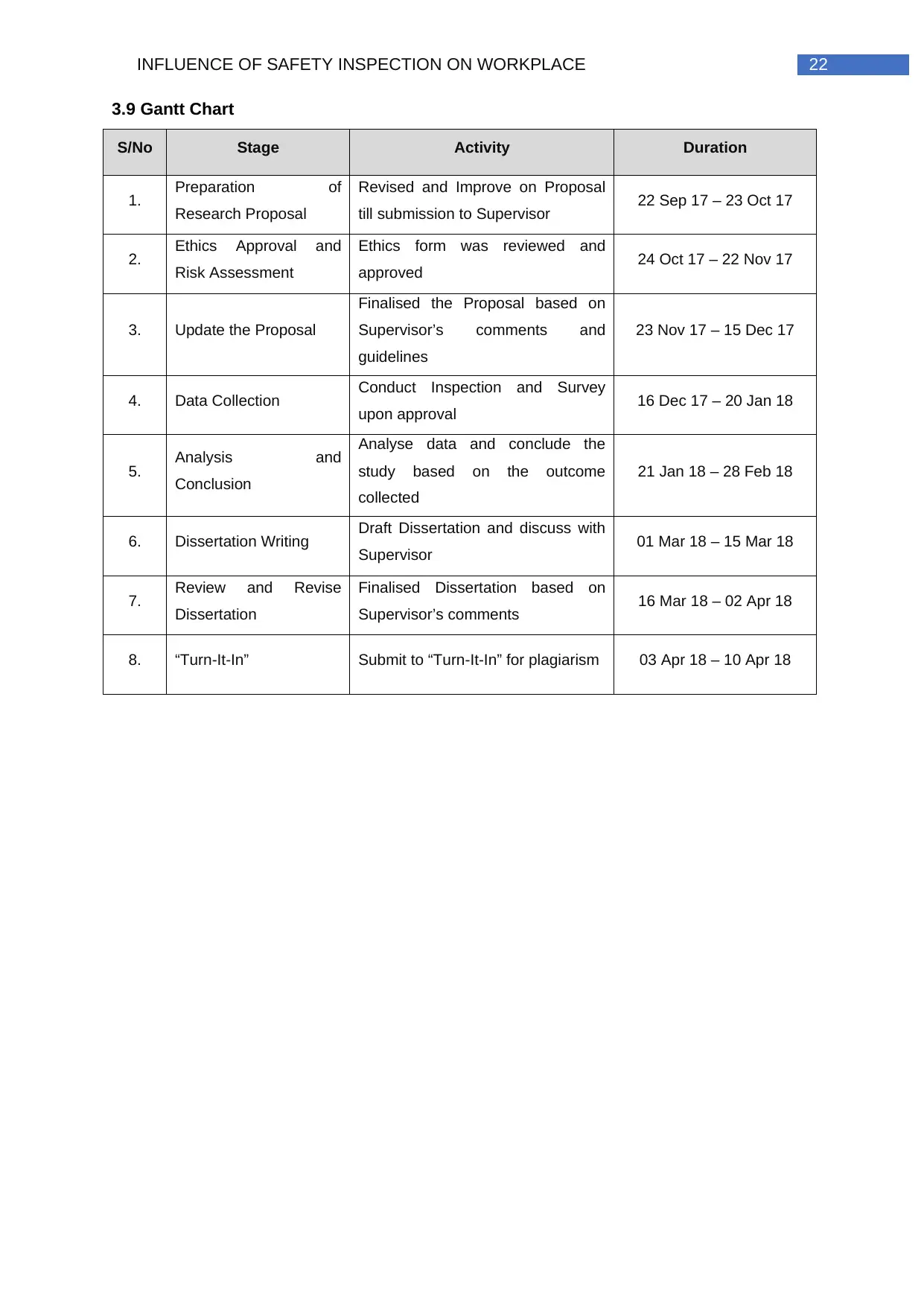
22INFLUENCE OF SAFETY INSPECTION ON WORKPLACE
3.9 Gantt Chart
S/No Stage Activity Duration
1. Preparation of
Research Proposal
Revised and Improve on Proposal
till submission to Supervisor 22 Sep 17 – 23 Oct 17
2. Ethics Approval and
Risk Assessment
Ethics form was reviewed and
approved 24 Oct 17 – 22 Nov 17
3. Update the Proposal
Finalised the Proposal based on
Supervisor’s comments and
guidelines
23 Nov 17 – 15 Dec 17
4. Data Collection Conduct Inspection and Survey
upon approval 16 Dec 17 – 20 Jan 18
5. Analysis and
Conclusion
Analyse data and conclude the
study based on the outcome
collected
21 Jan 18 – 28 Feb 18
6. Dissertation Writing Draft Dissertation and discuss with
Supervisor 01 Mar 18 – 15 Mar 18
7. Review and Revise
Dissertation
Finalised Dissertation based on
Supervisor’s comments 16 Mar 18 – 02 Apr 18
8. “Turn-It-In” Submit to “Turn-It-In” for plagiarism 03 Apr 18 – 10 Apr 18
3.9 Gantt Chart
S/No Stage Activity Duration
1. Preparation of
Research Proposal
Revised and Improve on Proposal
till submission to Supervisor 22 Sep 17 – 23 Oct 17
2. Ethics Approval and
Risk Assessment
Ethics form was reviewed and
approved 24 Oct 17 – 22 Nov 17
3. Update the Proposal
Finalised the Proposal based on
Supervisor’s comments and
guidelines
23 Nov 17 – 15 Dec 17
4. Data Collection Conduct Inspection and Survey
upon approval 16 Dec 17 – 20 Jan 18
5. Analysis and
Conclusion
Analyse data and conclude the
study based on the outcome
collected
21 Jan 18 – 28 Feb 18
6. Dissertation Writing Draft Dissertation and discuss with
Supervisor 01 Mar 18 – 15 Mar 18
7. Review and Revise
Dissertation
Finalised Dissertation based on
Supervisor’s comments 16 Mar 18 – 02 Apr 18
8. “Turn-It-In” Submit to “Turn-It-In” for plagiarism 03 Apr 18 – 10 Apr 18
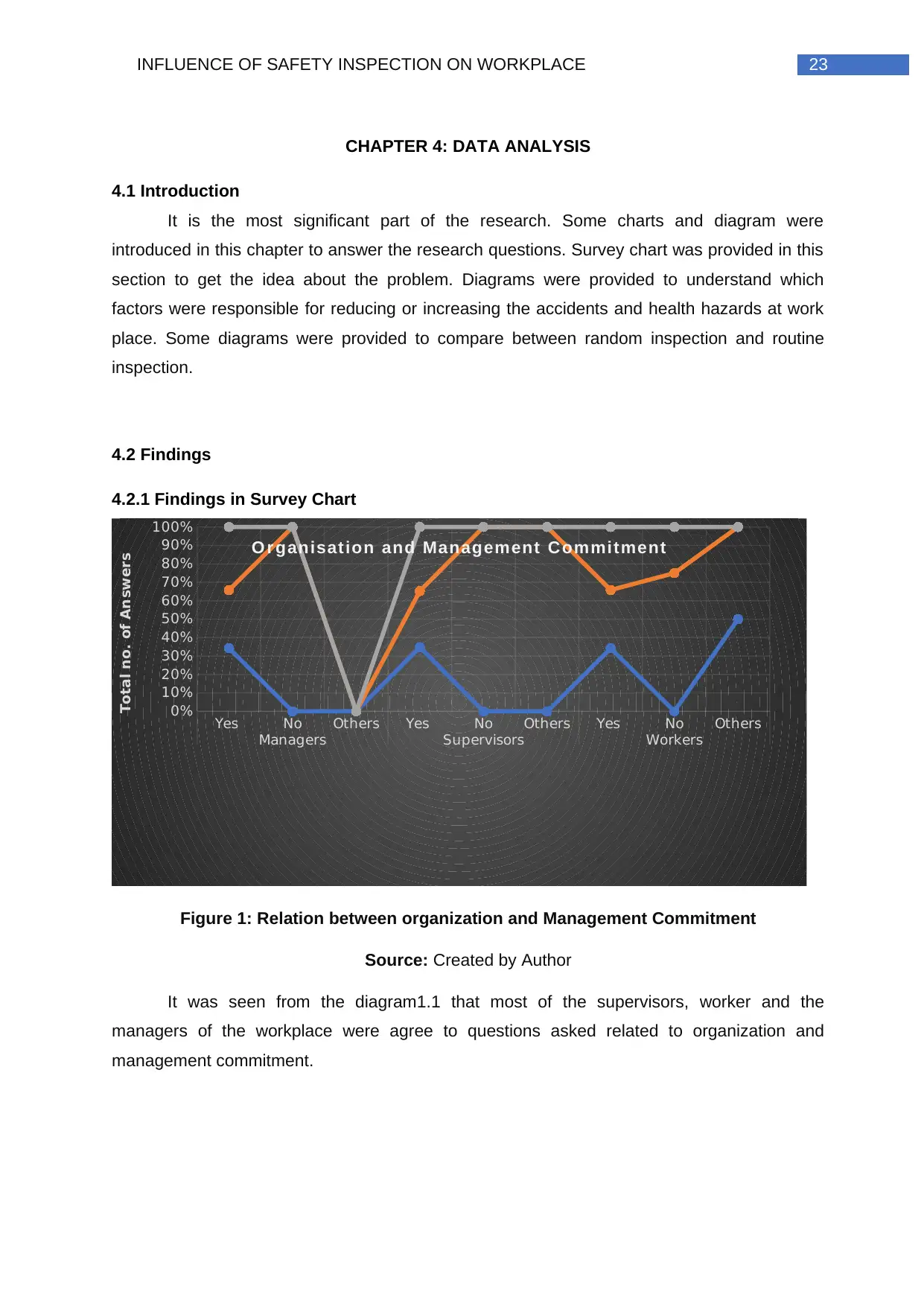
23INFLUENCE OF SAFETY INSPECTION ON WORKPLACE
CHAPTER 4: DATA ANALYSIS
4.1 Introduction
It is the most significant part of the research. Some charts and diagram were
introduced in this chapter to answer the research questions. Survey chart was provided in this
section to get the idea about the problem. Diagrams were provided to understand which
factors were responsible for reducing or increasing the accidents and health hazards at work
place. Some diagrams were provided to compare between random inspection and routine
inspection.
4.2 Findings
4.2.1 Findings in Survey Chart
Yes No Others Yes No Others Yes No Others
Managers Supervisors Workers
0%
10%
20%
30%
40%
50%
60%
70%
80%
90%
100%
O r ganisation and Management C ommitment
Total no. of Answers
Figure 1: Relation between organization and Management Commitment
Source: Created by Author
It was seen from the diagram1.1 that most of the supervisors, worker and the
managers of the workplace were agree to questions asked related to organization and
management commitment.
CHAPTER 4: DATA ANALYSIS
4.1 Introduction
It is the most significant part of the research. Some charts and diagram were
introduced in this chapter to answer the research questions. Survey chart was provided in this
section to get the idea about the problem. Diagrams were provided to understand which
factors were responsible for reducing or increasing the accidents and health hazards at work
place. Some diagrams were provided to compare between random inspection and routine
inspection.
4.2 Findings
4.2.1 Findings in Survey Chart
Yes No Others Yes No Others Yes No Others
Managers Supervisors Workers
0%
10%
20%
30%
40%
50%
60%
70%
80%
90%
100%
O r ganisation and Management C ommitment
Total no. of Answers
Figure 1: Relation between organization and Management Commitment
Source: Created by Author
It was seen from the diagram1.1 that most of the supervisors, worker and the
managers of the workplace were agree to questions asked related to organization and
management commitment.
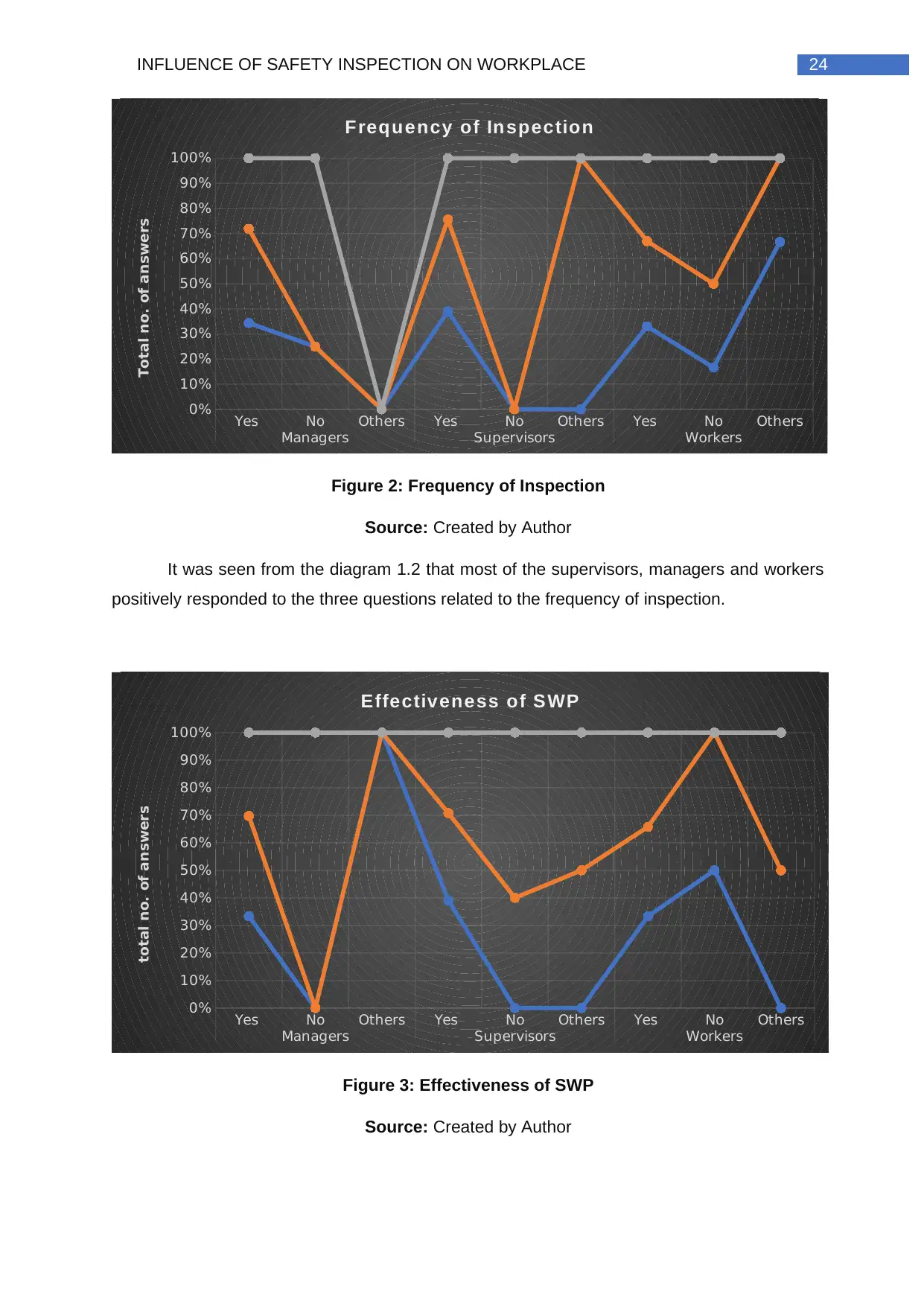
24INFLUENCE OF SAFETY INSPECTION ON WORKPLACE
Yes No Others Yes No Others Yes No Others
Managers Supervisors Workers
0%
10%
20%
30%
40%
50%
60%
70%
80%
90%
100%
Frequency of In spection
Total no. of answers
Figure 2: Frequency of Inspection
Source: Created by Author
It was seen from the diagram 1.2 that most of the supervisors, managers and workers
positively responded to the three questions related to the frequency of inspection.
Yes No Others Yes No Others Yes No Others
Managers Supervisors Workers
0%
10%
20%
30%
40%
50%
60%
70%
80%
90%
100%
Effectiveness of S WP
total no. of answers
Figure 3: Effectiveness of SWP
Source: Created by Author
Yes No Others Yes No Others Yes No Others
Managers Supervisors Workers
0%
10%
20%
30%
40%
50%
60%
70%
80%
90%
100%
Frequency of In spection
Total no. of answers
Figure 2: Frequency of Inspection
Source: Created by Author
It was seen from the diagram 1.2 that most of the supervisors, managers and workers
positively responded to the three questions related to the frequency of inspection.
Yes No Others Yes No Others Yes No Others
Managers Supervisors Workers
0%
10%
20%
30%
40%
50%
60%
70%
80%
90%
100%
Effectiveness of S WP
total no. of answers
Figure 3: Effectiveness of SWP
Source: Created by Author
Paraphrase This Document
Need a fresh take? Get an instant paraphrase of this document with our AI Paraphraser
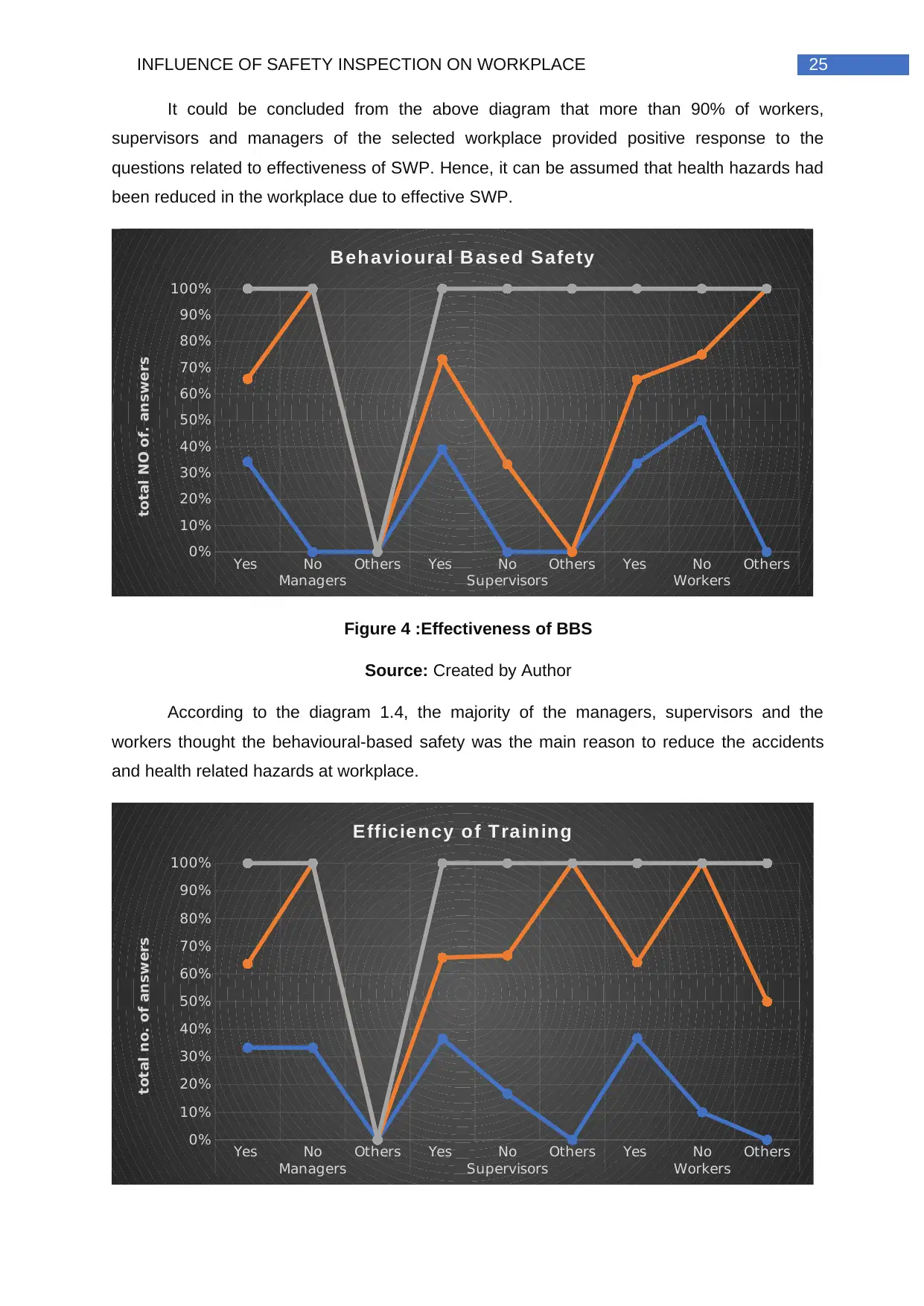
25INFLUENCE OF SAFETY INSPECTION ON WORKPLACE
It could be concluded from the above diagram that more than 90% of workers,
supervisors and managers of the selected workplace provided positive response to the
questions related to effectiveness of SWP. Hence, it can be assumed that health hazards had
been reduced in the workplace due to effective SWP.
Yes No Others Yes No Others Yes No Others
Managers Supervisors Workers
0%
10%
20%
30%
40%
50%
60%
70%
80%
90%
100%
B ehavioural B ased Safety
total NO of. answers
Figure 4 :Effectiveness of BBS
Source: Created by Author
According to the diagram 1.4, the majority of the managers, supervisors and the
workers thought the behavioural-based safety was the main reason to reduce the accidents
and health related hazards at workplace.
Yes No Others Yes No Others Yes No Others
Managers Supervisors Workers
0%
10%
20%
30%
40%
50%
60%
70%
80%
90%
100%
Efficiency of Training
total no. of answers
It could be concluded from the above diagram that more than 90% of workers,
supervisors and managers of the selected workplace provided positive response to the
questions related to effectiveness of SWP. Hence, it can be assumed that health hazards had
been reduced in the workplace due to effective SWP.
Yes No Others Yes No Others Yes No Others
Managers Supervisors Workers
0%
10%
20%
30%
40%
50%
60%
70%
80%
90%
100%
B ehavioural B ased Safety
total NO of. answers
Figure 4 :Effectiveness of BBS
Source: Created by Author
According to the diagram 1.4, the majority of the managers, supervisors and the
workers thought the behavioural-based safety was the main reason to reduce the accidents
and health related hazards at workplace.
Yes No Others Yes No Others Yes No Others
Managers Supervisors Workers
0%
10%
20%
30%
40%
50%
60%
70%
80%
90%
100%
Efficiency of Training
total no. of answers

26INFLUENCE OF SAFETY INSPECTION ON WORKPLACE
Figure 5 : Effectiveness of Training
Source: Created by Author
It was clear from the above diagram that most of the managers, workers and
supervisors said that the effective training was helpful to reduce the accidents and health
hazards at the place of work.
Yes No Others Yes No Others Yes No Others
Managers Supervisors Workers
0%
10%
20%
30%
40%
50%
60%
70%
80%
90%
100%
12
0 0
14
1
1
37
3
0
5
6
1
10
4 2 31
6
3
10
2
0
12
2
0
28 6 6
11 1 0 9 4 3 32 5 3
Time and Budget
Axis Title
Figure 6 : Time and Budget
Source: Created by Author
It was believed from the diagram 1.6 that time and budget was responsible for
plummeting accidents and health hazards. Managers, workers and supervisors were asked
several questions. Nearly everyone answered positively.
Figure 5 : Effectiveness of Training
Source: Created by Author
It was clear from the above diagram that most of the managers, workers and
supervisors said that the effective training was helpful to reduce the accidents and health
hazards at the place of work.
Yes No Others Yes No Others Yes No Others
Managers Supervisors Workers
0%
10%
20%
30%
40%
50%
60%
70%
80%
90%
100%
12
0 0
14
1
1
37
3
0
5
6
1
10
4 2 31
6
3
10
2
0
12
2
0
28 6 6
11 1 0 9 4 3 32 5 3
Time and Budget
Axis Title
Figure 6 : Time and Budget
Source: Created by Author
It was believed from the diagram 1.6 that time and budget was responsible for
plummeting accidents and health hazards. Managers, workers and supervisors were asked
several questions. Nearly everyone answered positively.
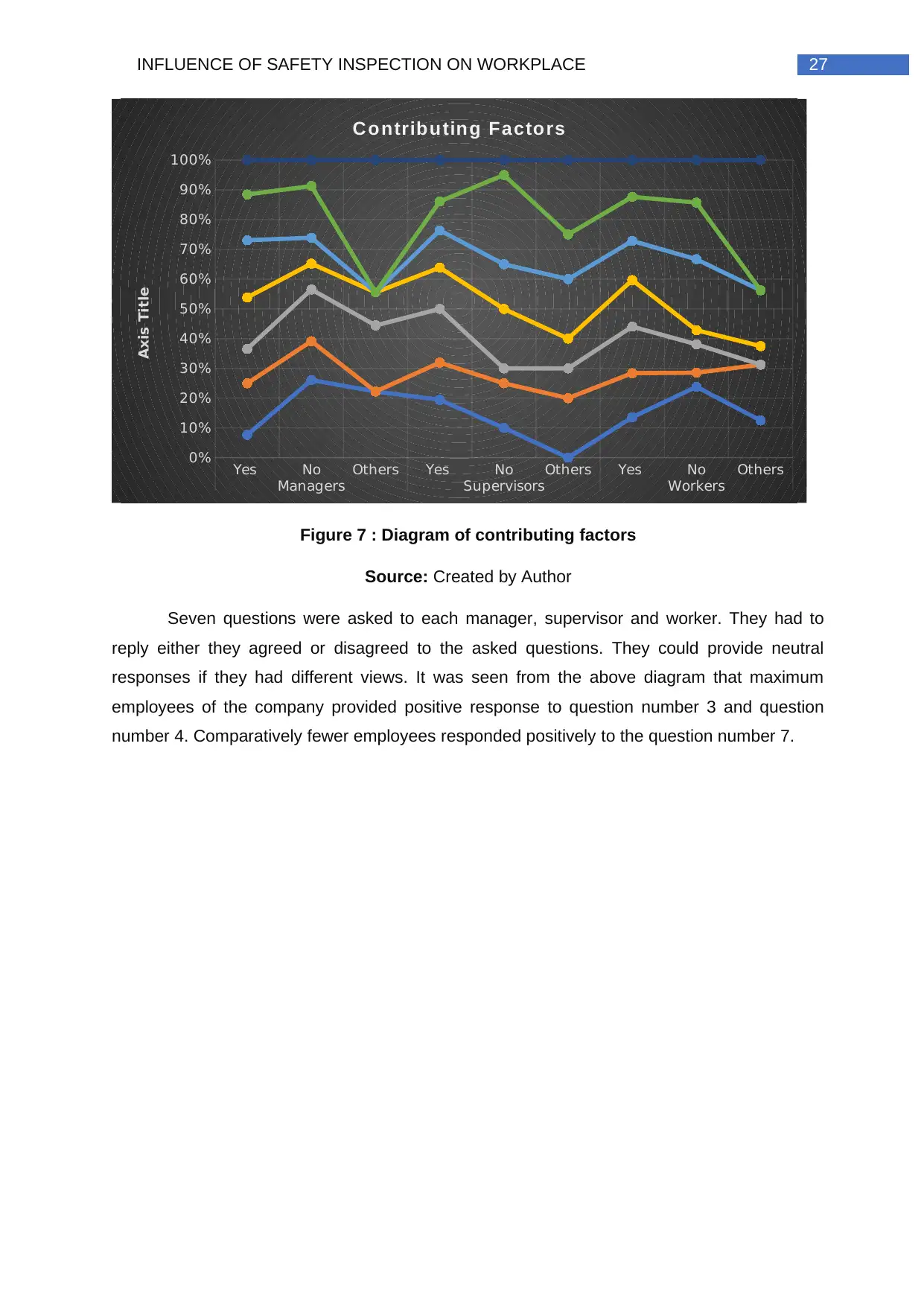
27INFLUENCE OF SAFETY INSPECTION ON WORKPLACE
Yes No Others Yes No Others Yes No Others
Managers Supervisors Workers
0%
10%
20%
30%
40%
50%
60%
70%
80%
90%
100%
C ontributing Factors
Axis Title
Figure 7 : Diagram of contributing factors
Source: Created by Author
Seven questions were asked to each manager, supervisor and worker. They had to
reply either they agreed or disagreed to the asked questions. They could provide neutral
responses if they had different views. It was seen from the above diagram that maximum
employees of the company provided positive response to question number 3 and question
number 4. Comparatively fewer employees responded positively to the question number 7.
Yes No Others Yes No Others Yes No Others
Managers Supervisors Workers
0%
10%
20%
30%
40%
50%
60%
70%
80%
90%
100%
C ontributing Factors
Axis Title
Figure 7 : Diagram of contributing factors
Source: Created by Author
Seven questions were asked to each manager, supervisor and worker. They had to
reply either they agreed or disagreed to the asked questions. They could provide neutral
responses if they had different views. It was seen from the above diagram that maximum
employees of the company provided positive response to question number 3 and question
number 4. Comparatively fewer employees responded positively to the question number 7.
Secure Best Marks with AI Grader
Need help grading? Try our AI Grader for instant feedback on your assignments.

28INFLUENCE OF SAFETY INSPECTION ON WORKPLACE
4.2.2 Findings in Routine Inspection
Yes No Yes No Yes No Yes No
Week 1 Week 2 Week 3 Week 4
0
1
2
3
4
5
6
7
8
Fall Prevention
5 day / week inspection
Figure 8 : Fall prevention in routine inspection
Source: Created by Author
The above diagram showed the measures of fall avoidance during a routine inspection.
The inspection was done for five days in a week. It was conducted for 4 weeks. It was seen
that supervision was ineffective to prevent falling in first week. Gradually, supervision became
effective to prevent the falling. Risk management and commitment was more or less effective
throughout the 4 weeks. Management support was moderate earlier to the first week to
prevent falling. Management support took great role to avoid the falling after first week.
Behavioural based safety was important to prevent accidents in the workplace.
4.2.2 Findings in Routine Inspection
Yes No Yes No Yes No Yes No
Week 1 Week 2 Week 3 Week 4
0
1
2
3
4
5
6
7
8
Fall Prevention
5 day / week inspection
Figure 8 : Fall prevention in routine inspection
Source: Created by Author
The above diagram showed the measures of fall avoidance during a routine inspection.
The inspection was done for five days in a week. It was conducted for 4 weeks. It was seen
that supervision was ineffective to prevent falling in first week. Gradually, supervision became
effective to prevent the falling. Risk management and commitment was more or less effective
throughout the 4 weeks. Management support was moderate earlier to the first week to
prevent falling. Management support took great role to avoid the falling after first week.
Behavioural based safety was important to prevent accidents in the workplace.
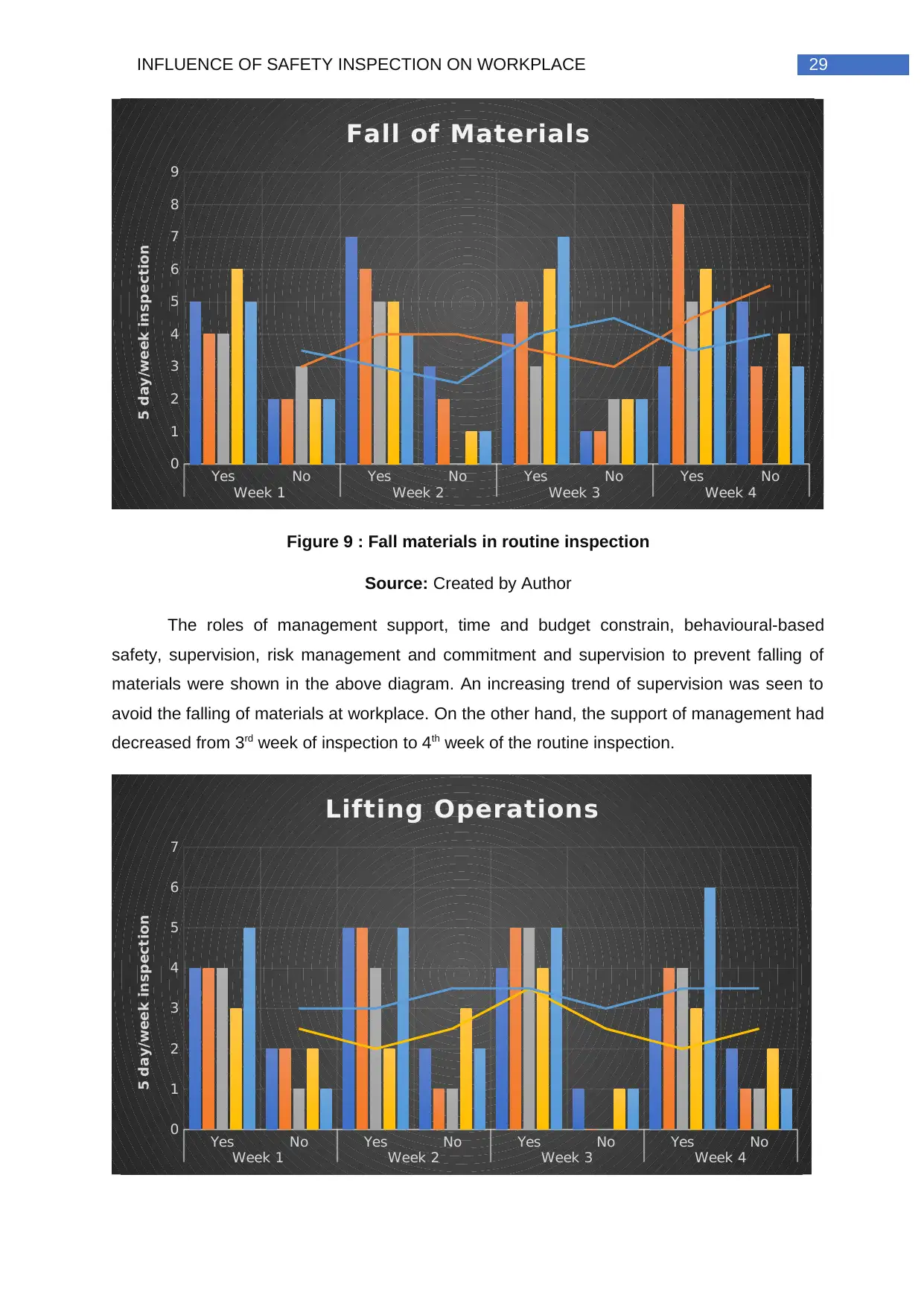
29INFLUENCE OF SAFETY INSPECTION ON WORKPLACE
Yes No Yes No Yes No Yes No
Week 1 Week 2 Week 3 Week 4
0
1
2
3
4
5
6
7
8
9
Fall of Materials
5 day/week inspection
Figure 9 : Fall materials in routine inspection
Source: Created by Author
The roles of management support, time and budget constrain, behavioural-based
safety, supervision, risk management and commitment and supervision to prevent falling of
materials were shown in the above diagram. An increasing trend of supervision was seen to
avoid the falling of materials at workplace. On the other hand, the support of management had
decreased from 3rd week of inspection to 4th week of the routine inspection.
Yes No Yes No Yes No Yes No
Week 1 Week 2 Week 3 Week 4
0
1
2
3
4
5
6
7
Lifting Operations
5 day/week inspection
Yes No Yes No Yes No Yes No
Week 1 Week 2 Week 3 Week 4
0
1
2
3
4
5
6
7
8
9
Fall of Materials
5 day/week inspection
Figure 9 : Fall materials in routine inspection
Source: Created by Author
The roles of management support, time and budget constrain, behavioural-based
safety, supervision, risk management and commitment and supervision to prevent falling of
materials were shown in the above diagram. An increasing trend of supervision was seen to
avoid the falling of materials at workplace. On the other hand, the support of management had
decreased from 3rd week of inspection to 4th week of the routine inspection.
Yes No Yes No Yes No Yes No
Week 1 Week 2 Week 3 Week 4
0
1
2
3
4
5
6
7
Lifting Operations
5 day/week inspection
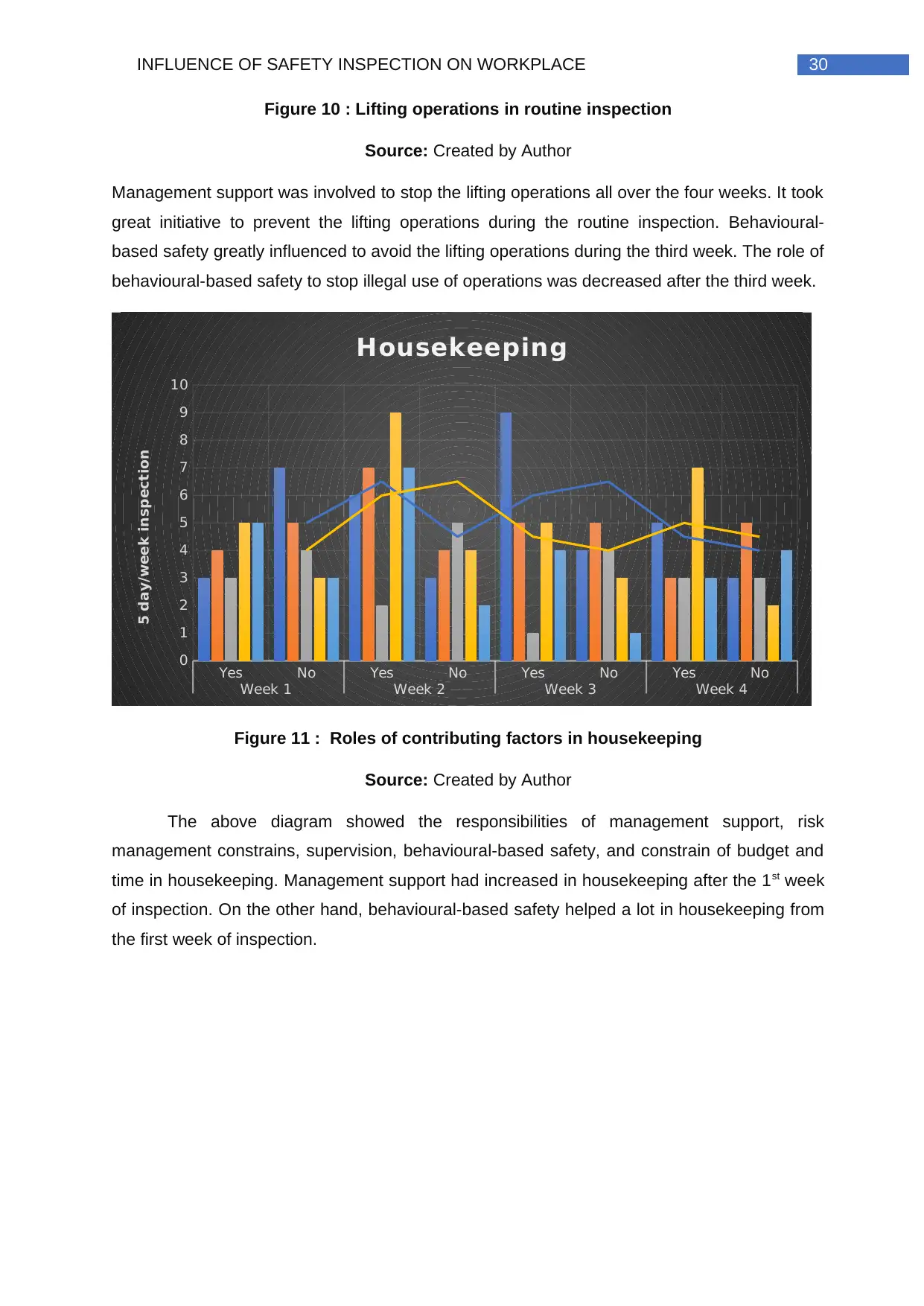
30INFLUENCE OF SAFETY INSPECTION ON WORKPLACE
Figure 10 : Lifting operations in routine inspection
Source: Created by Author
Management support was involved to stop the lifting operations all over the four weeks. It took
great initiative to prevent the lifting operations during the routine inspection. Behavioural-
based safety greatly influenced to avoid the lifting operations during the third week. The role of
behavioural-based safety to stop illegal use of operations was decreased after the third week.
Yes No Yes No Yes No Yes No
Week 1 Week 2 Week 3 Week 4
0
1
2
3
4
5
6
7
8
9
10
Housekeeping
5 day/week inspection
Figure 11 : Roles of contributing factors in housekeeping
Source: Created by Author
The above diagram showed the responsibilities of management support, risk
management constrains, supervision, behavioural-based safety, and constrain of budget and
time in housekeeping. Management support had increased in housekeeping after the 1st week
of inspection. On the other hand, behavioural-based safety helped a lot in housekeeping from
the first week of inspection.
Figure 10 : Lifting operations in routine inspection
Source: Created by Author
Management support was involved to stop the lifting operations all over the four weeks. It took
great initiative to prevent the lifting operations during the routine inspection. Behavioural-
based safety greatly influenced to avoid the lifting operations during the third week. The role of
behavioural-based safety to stop illegal use of operations was decreased after the third week.
Yes No Yes No Yes No Yes No
Week 1 Week 2 Week 3 Week 4
0
1
2
3
4
5
6
7
8
9
10
Housekeeping
5 day/week inspection
Figure 11 : Roles of contributing factors in housekeeping
Source: Created by Author
The above diagram showed the responsibilities of management support, risk
management constrains, supervision, behavioural-based safety, and constrain of budget and
time in housekeeping. Management support had increased in housekeeping after the 1st week
of inspection. On the other hand, behavioural-based safety helped a lot in housekeeping from
the first week of inspection.
Paraphrase This Document
Need a fresh take? Get an instant paraphrase of this document with our AI Paraphraser
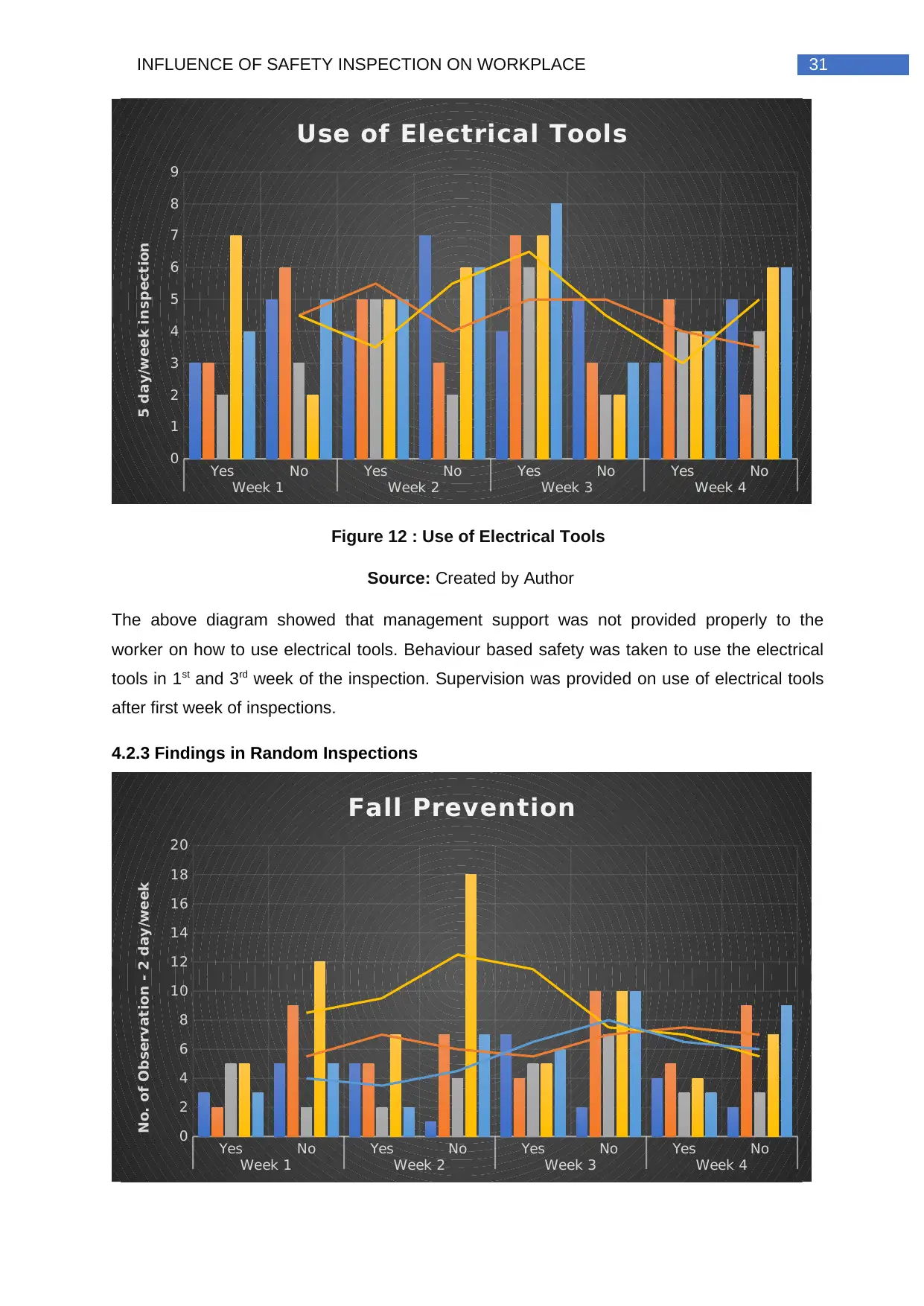
31INFLUENCE OF SAFETY INSPECTION ON WORKPLACE
Yes No Yes No Yes No Yes No
Week 1 Week 2 Week 3 Week 4
0
1
2
3
4
5
6
7
8
9
Use of Electrical Tools
5 day/week inspection
Figure 12 : Use of Electrical Tools
Source: Created by Author
The above diagram showed that management support was not provided properly to the
worker on how to use electrical tools. Behaviour based safety was taken to use the electrical
tools in 1st and 3rd week of the inspection. Supervision was provided on use of electrical tools
after first week of inspections.
4.2.3 Findings in Random Inspections
Yes No Yes No Yes No Yes No
Week 1 Week 2 Week 3 Week 4
0
2
4
6
8
10
12
14
16
18
20
Fall Prevention
No. of Observation - 2 day/week
Yes No Yes No Yes No Yes No
Week 1 Week 2 Week 3 Week 4
0
1
2
3
4
5
6
7
8
9
Use of Electrical Tools
5 day/week inspection
Figure 12 : Use of Electrical Tools
Source: Created by Author
The above diagram showed that management support was not provided properly to the
worker on how to use electrical tools. Behaviour based safety was taken to use the electrical
tools in 1st and 3rd week of the inspection. Supervision was provided on use of electrical tools
after first week of inspections.
4.2.3 Findings in Random Inspections
Yes No Yes No Yes No Yes No
Week 1 Week 2 Week 3 Week 4
0
2
4
6
8
10
12
14
16
18
20
Fall Prevention
No. of Observation - 2 day/week
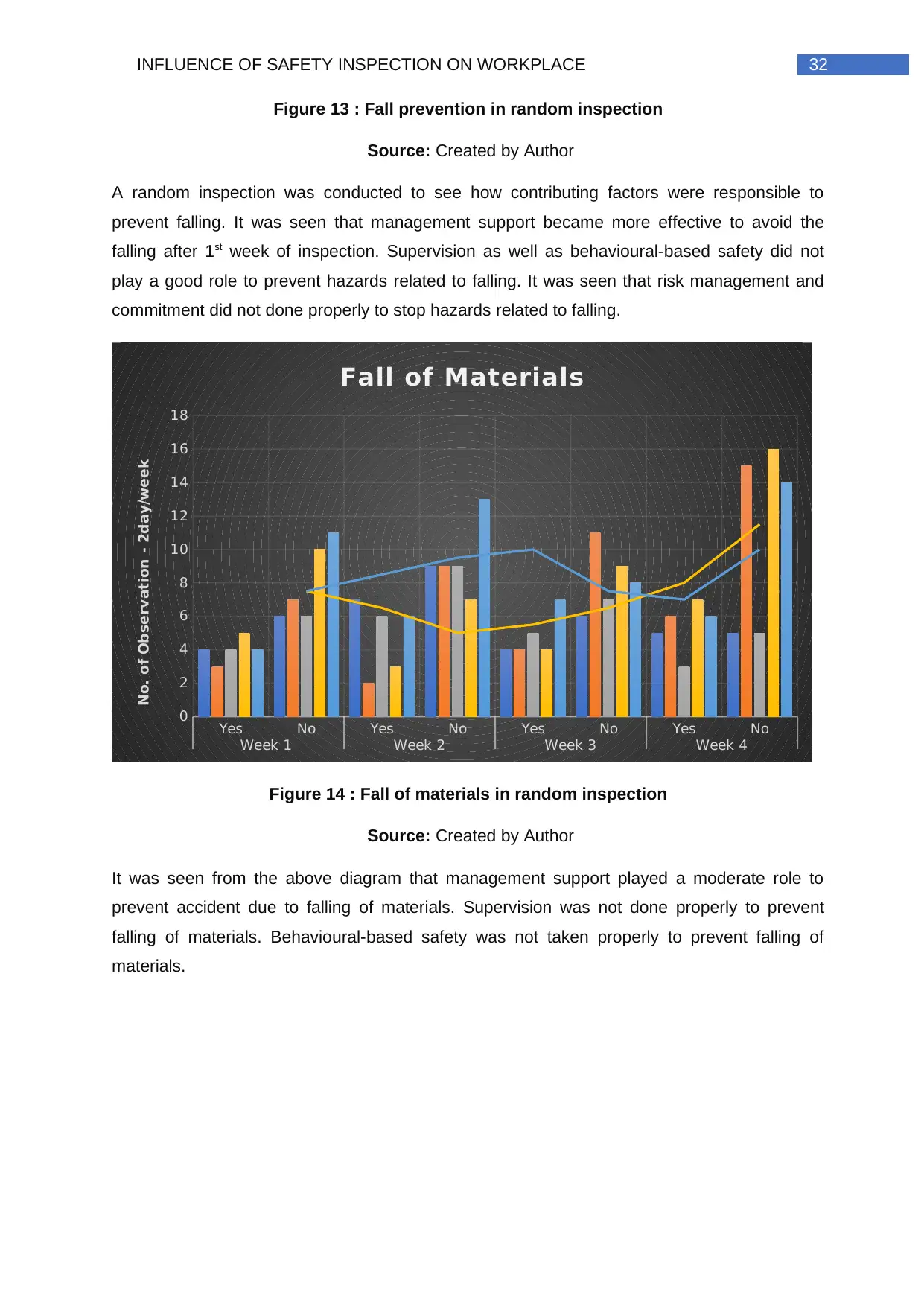
32INFLUENCE OF SAFETY INSPECTION ON WORKPLACE
Figure 13 : Fall prevention in random inspection
Source: Created by Author
A random inspection was conducted to see how contributing factors were responsible to
prevent falling. It was seen that management support became more effective to avoid the
falling after 1st week of inspection. Supervision as well as behavioural-based safety did not
play a good role to prevent hazards related to falling. It was seen that risk management and
commitment did not done properly to stop hazards related to falling.
Yes No Yes No Yes No Yes No
Week 1 Week 2 Week 3 Week 4
0
2
4
6
8
10
12
14
16
18
Fall of Materials
No. of Observation - 2day/week
Figure 14 : Fall of materials in random inspection
Source: Created by Author
It was seen from the above diagram that management support played a moderate role to
prevent accident due to falling of materials. Supervision was not done properly to prevent
falling of materials. Behavioural-based safety was not taken properly to prevent falling of
materials.
Figure 13 : Fall prevention in random inspection
Source: Created by Author
A random inspection was conducted to see how contributing factors were responsible to
prevent falling. It was seen that management support became more effective to avoid the
falling after 1st week of inspection. Supervision as well as behavioural-based safety did not
play a good role to prevent hazards related to falling. It was seen that risk management and
commitment did not done properly to stop hazards related to falling.
Yes No Yes No Yes No Yes No
Week 1 Week 2 Week 3 Week 4
0
2
4
6
8
10
12
14
16
18
Fall of Materials
No. of Observation - 2day/week
Figure 14 : Fall of materials in random inspection
Source: Created by Author
It was seen from the above diagram that management support played a moderate role to
prevent accident due to falling of materials. Supervision was not done properly to prevent
falling of materials. Behavioural-based safety was not taken properly to prevent falling of
materials.
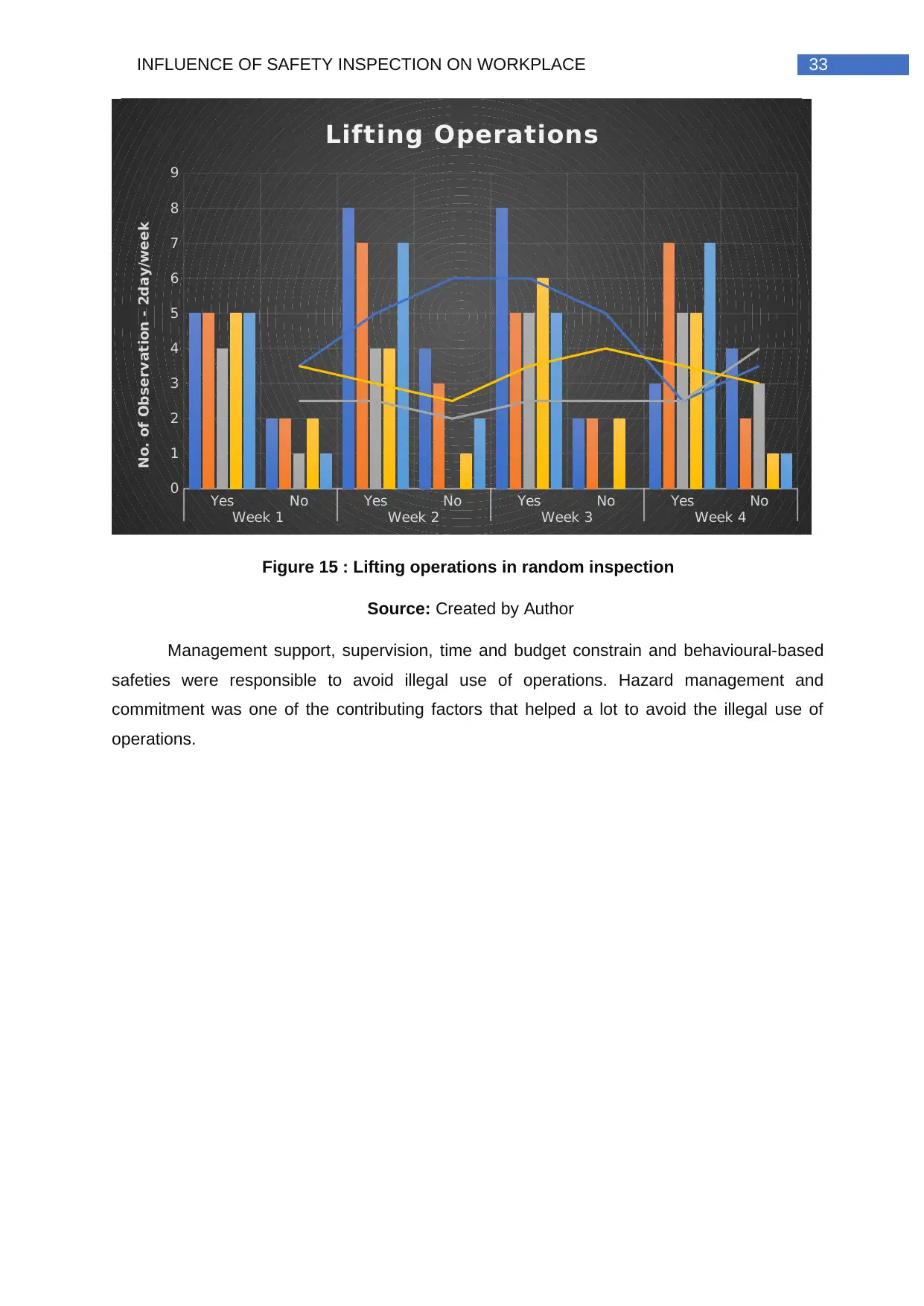
33INFLUENCE OF SAFETY INSPECTION ON WORKPLACE
Yes No Yes No Yes No Yes No
Week 1 Week 2 Week 3 Week 4
0
1
2
3
4
5
6
7
8
9
Lifting Operations
No. of Observation - 2day/week
Figure 15 : Lifting operations in random inspection
Source: Created by Author
Management support, supervision, time and budget constrain and behavioural-based
safeties were responsible to avoid illegal use of operations. Hazard management and
commitment was one of the contributing factors that helped a lot to avoid the illegal use of
operations.
Yes No Yes No Yes No Yes No
Week 1 Week 2 Week 3 Week 4
0
1
2
3
4
5
6
7
8
9
Lifting Operations
No. of Observation - 2day/week
Figure 15 : Lifting operations in random inspection
Source: Created by Author
Management support, supervision, time and budget constrain and behavioural-based
safeties were responsible to avoid illegal use of operations. Hazard management and
commitment was one of the contributing factors that helped a lot to avoid the illegal use of
operations.
Secure Best Marks with AI Grader
Need help grading? Try our AI Grader for instant feedback on your assignments.
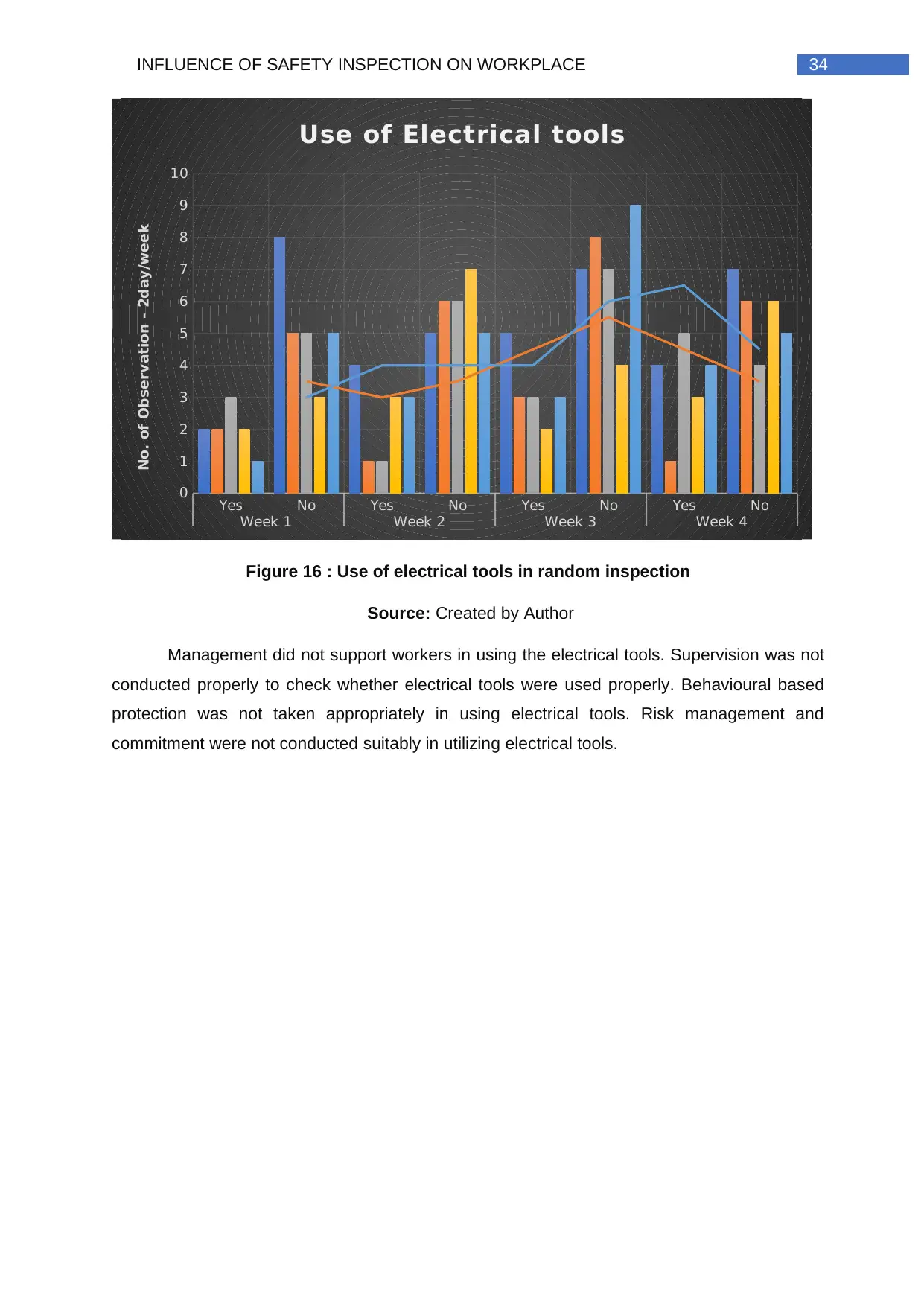
34INFLUENCE OF SAFETY INSPECTION ON WORKPLACE
Yes No Yes No Yes No Yes No
Week 1 Week 2 Week 3 Week 4
0
1
2
3
4
5
6
7
8
9
10
Use of Electrical tools
No. of Observation - 2day/week
Figure 16 : Use of electrical tools in random inspection
Source: Created by Author
Management did not support workers in using the electrical tools. Supervision was not
conducted properly to check whether electrical tools were used properly. Behavioural based
protection was not taken appropriately in using electrical tools. Risk management and
commitment were not conducted suitably in utilizing electrical tools.
Yes No Yes No Yes No Yes No
Week 1 Week 2 Week 3 Week 4
0
1
2
3
4
5
6
7
8
9
10
Use of Electrical tools
No. of Observation - 2day/week
Figure 16 : Use of electrical tools in random inspection
Source: Created by Author
Management did not support workers in using the electrical tools. Supervision was not
conducted properly to check whether electrical tools were used properly. Behavioural based
protection was not taken appropriately in using electrical tools. Risk management and
commitment were not conducted suitably in utilizing electrical tools.

35INFLUENCE OF SAFETY INSPECTION ON WORKPLACE
Yes No Yes No Yes No Yes No
Week 1 Week 2 Week 3 Week 4
0
2
4
6
8
10
12
14
16
Housekeeping
No. of Observation - 2day/week
Figure 17 : Housekeeping in random inspection
Source: Created by Author
Supervision was not conducted accurately in housekeeping. It was also seen in the
random inspection that management support was not provided properly in maintenance. Time
and budget were constrained in maintenance. Safety based on behaviour was not provided in
housekeeping.
4.3 Discussion
It was clear from the chart of survey that there were so many factors to reduce the
health related hazards and accidents in the place of work. The commitment of organization
and management was one of the contributing factors that were responsible in reducing risks at
workplace (Xiang et al. 2014). SWP and behavioural-based safety were also responsible in
plummeting accidents and hazards at workplace. Frequency of inspection helped in reducing
health hazards and accidents at workplace (Philips 2016). Accidents and risks could not be
reduced due to the limitation of time and budget. It was also seen that support of management
and supervision had been increased gradually. Hence, risks of the workplace had been
reduced. It helped to prevent the falling of materials. Awareness of using electrical tools had
been increased (Adamson et al. 2013). Hence, hazards from these electrical tools had been
removed. Supervision, support of management, risk management and commitment were
Yes No Yes No Yes No Yes No
Week 1 Week 2 Week 3 Week 4
0
2
4
6
8
10
12
14
16
Housekeeping
No. of Observation - 2day/week
Figure 17 : Housekeeping in random inspection
Source: Created by Author
Supervision was not conducted accurately in housekeeping. It was also seen in the
random inspection that management support was not provided properly in maintenance. Time
and budget were constrained in maintenance. Safety based on behaviour was not provided in
housekeeping.
4.3 Discussion
It was clear from the chart of survey that there were so many factors to reduce the
health related hazards and accidents in the place of work. The commitment of organization
and management was one of the contributing factors that were responsible in reducing risks at
workplace (Xiang et al. 2014). SWP and behavioural-based safety were also responsible in
plummeting accidents and hazards at workplace. Frequency of inspection helped in reducing
health hazards and accidents at workplace (Philips 2016). Accidents and risks could not be
reduced due to the limitation of time and budget. It was also seen that support of management
and supervision had been increased gradually. Hence, risks of the workplace had been
reduced. It helped to prevent the falling of materials. Awareness of using electrical tools had
been increased (Adamson et al. 2013). Hence, hazards from these electrical tools had been
removed. Supervision, support of management, risk management and commitment were

36INFLUENCE OF SAFETY INSPECTION ON WORKPLACE
responsible for reducing risks at workplace. Limitation of budget and time were removed as
much as possible to improve maintenance.
responsible for reducing risks at workplace. Limitation of budget and time were removed as
much as possible to improve maintenance.
Paraphrase This Document
Need a fresh take? Get an instant paraphrase of this document with our AI Paraphraser
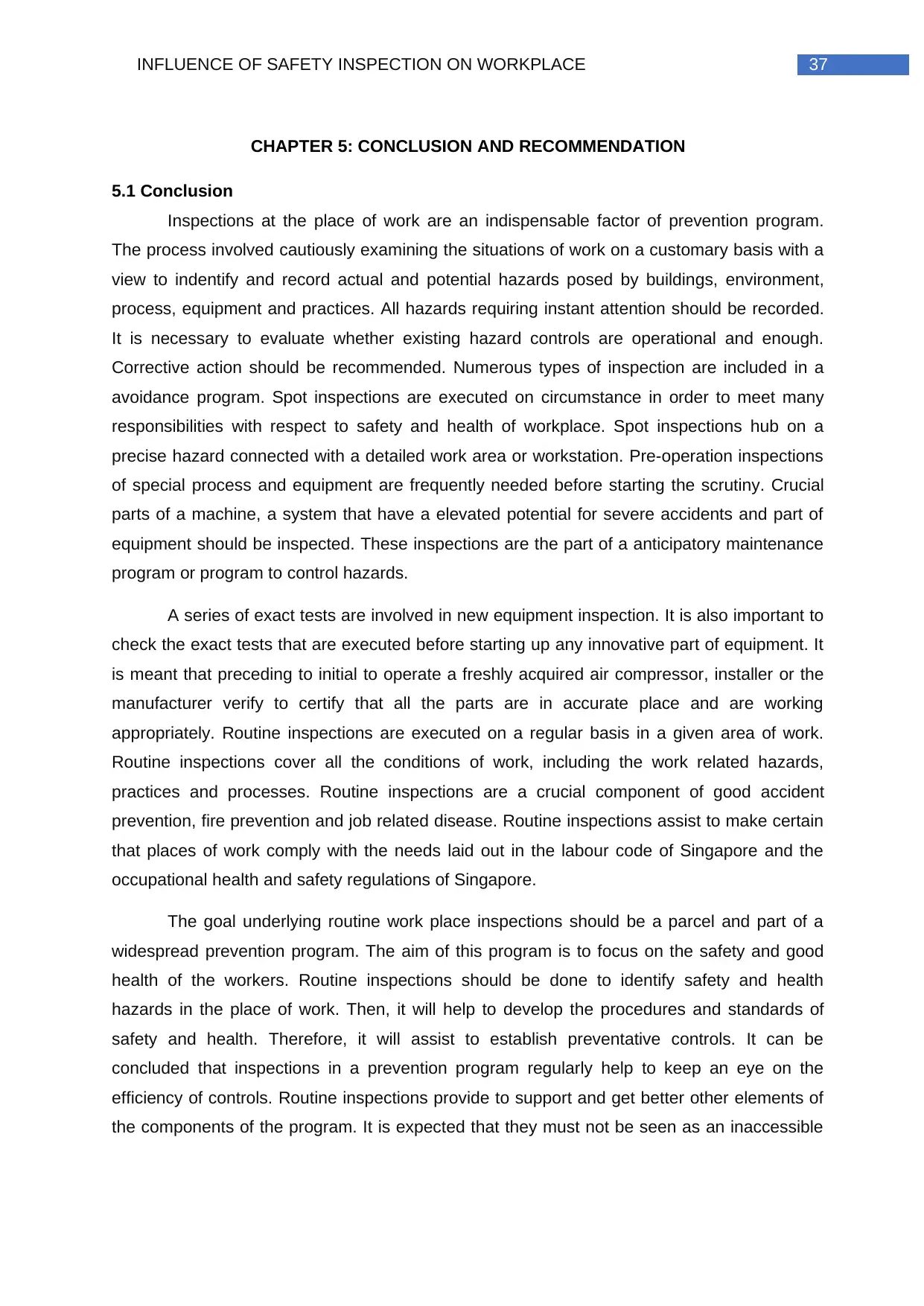
37INFLUENCE OF SAFETY INSPECTION ON WORKPLACE
CHAPTER 5: CONCLUSION AND RECOMMENDATION
5.1 Conclusion
Inspections at the place of work are an indispensable factor of prevention program.
The process involved cautiously examining the situations of work on a customary basis with a
view to indentify and record actual and potential hazards posed by buildings, environment,
process, equipment and practices. All hazards requiring instant attention should be recorded.
It is necessary to evaluate whether existing hazard controls are operational and enough.
Corrective action should be recommended. Numerous types of inspection are included in a
avoidance program. Spot inspections are executed on circumstance in order to meet many
responsibilities with respect to safety and health of workplace. Spot inspections hub on a
precise hazard connected with a detailed work area or workstation. Pre-operation inspections
of special process and equipment are frequently needed before starting the scrutiny. Crucial
parts of a machine, a system that have a elevated potential for severe accidents and part of
equipment should be inspected. These inspections are the part of a anticipatory maintenance
program or program to control hazards.
A series of exact tests are involved in new equipment inspection. It is also important to
check the exact tests that are executed before starting up any innovative part of equipment. It
is meant that preceding to initial to operate a freshly acquired air compressor, installer or the
manufacturer verify to certify that all the parts are in accurate place and are working
appropriately. Routine inspections are executed on a regular basis in a given area of work.
Routine inspections cover all the conditions of work, including the work related hazards,
practices and processes. Routine inspections are a crucial component of good accident
prevention, fire prevention and job related disease. Routine inspections assist to make certain
that places of work comply with the needs laid out in the labour code of Singapore and the
occupational health and safety regulations of Singapore.
The goal underlying routine work place inspections should be a parcel and part of a
widespread prevention program. The aim of this program is to focus on the safety and good
health of the workers. Routine inspections should be done to identify safety and health
hazards in the place of work. Then, it will help to develop the procedures and standards of
safety and health. Therefore, it will assist to establish preventative controls. It can be
concluded that inspections in a prevention program regularly help to keep an eye on the
efficiency of controls. Routine inspections provide to support and get better other elements of
the components of the program. It is expected that they must not be seen as an inaccessible
CHAPTER 5: CONCLUSION AND RECOMMENDATION
5.1 Conclusion
Inspections at the place of work are an indispensable factor of prevention program.
The process involved cautiously examining the situations of work on a customary basis with a
view to indentify and record actual and potential hazards posed by buildings, environment,
process, equipment and practices. All hazards requiring instant attention should be recorded.
It is necessary to evaluate whether existing hazard controls are operational and enough.
Corrective action should be recommended. Numerous types of inspection are included in a
avoidance program. Spot inspections are executed on circumstance in order to meet many
responsibilities with respect to safety and health of workplace. Spot inspections hub on a
precise hazard connected with a detailed work area or workstation. Pre-operation inspections
of special process and equipment are frequently needed before starting the scrutiny. Crucial
parts of a machine, a system that have a elevated potential for severe accidents and part of
equipment should be inspected. These inspections are the part of a anticipatory maintenance
program or program to control hazards.
A series of exact tests are involved in new equipment inspection. It is also important to
check the exact tests that are executed before starting up any innovative part of equipment. It
is meant that preceding to initial to operate a freshly acquired air compressor, installer or the
manufacturer verify to certify that all the parts are in accurate place and are working
appropriately. Routine inspections are executed on a regular basis in a given area of work.
Routine inspections cover all the conditions of work, including the work related hazards,
practices and processes. Routine inspections are a crucial component of good accident
prevention, fire prevention and job related disease. Routine inspections assist to make certain
that places of work comply with the needs laid out in the labour code of Singapore and the
occupational health and safety regulations of Singapore.
The goal underlying routine work place inspections should be a parcel and part of a
widespread prevention program. The aim of this program is to focus on the safety and good
health of the workers. Routine inspections should be done to identify safety and health
hazards in the place of work. Then, it will help to develop the procedures and standards of
safety and health. Therefore, it will assist to establish preventative controls. It can be
concluded that inspections in a prevention program regularly help to keep an eye on the
efficiency of controls. Routine inspections provide to support and get better other elements of
the components of the program. It is expected that they must not be seen as an inaccessible
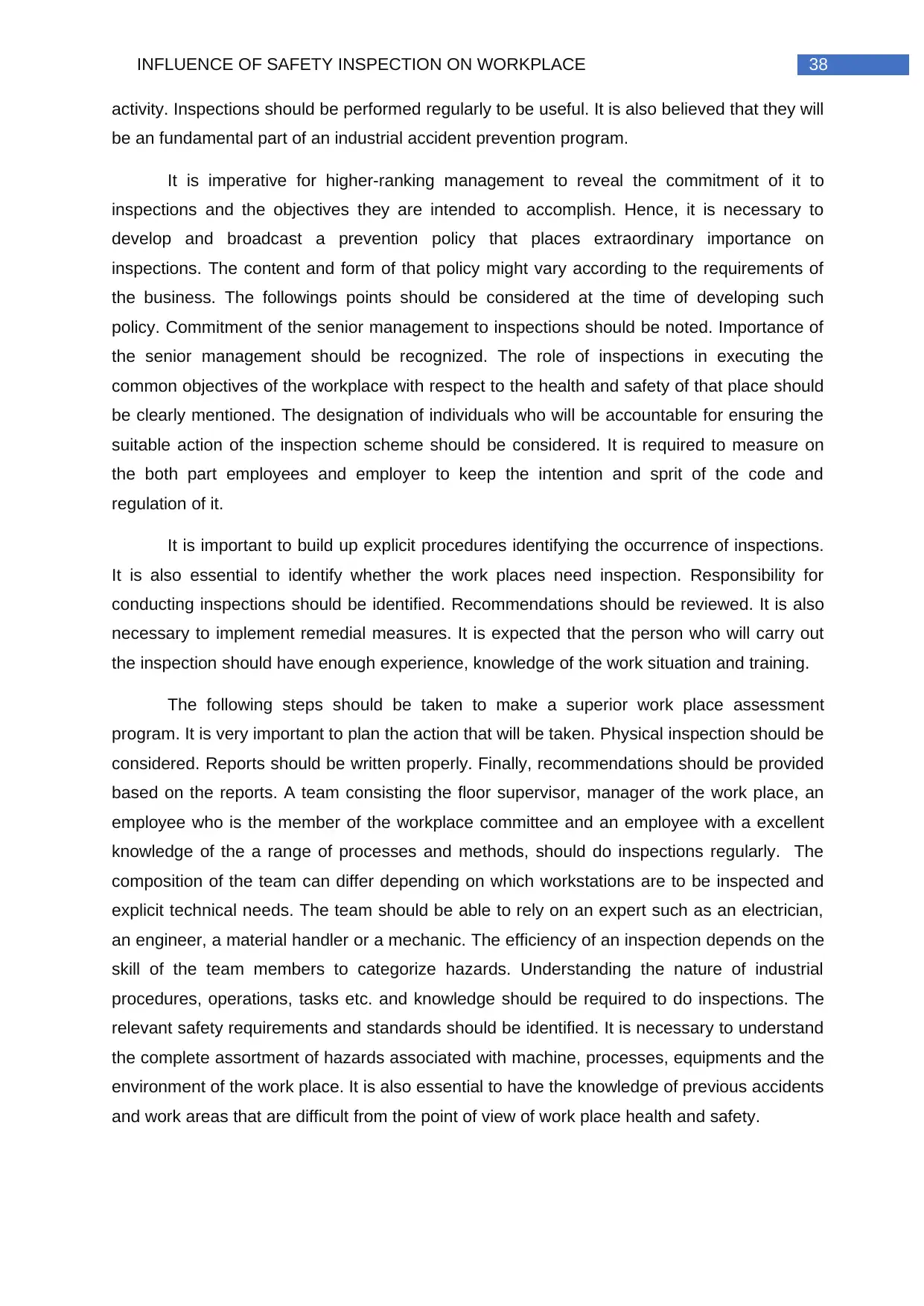
38INFLUENCE OF SAFETY INSPECTION ON WORKPLACE
activity. Inspections should be performed regularly to be useful. It is also believed that they will
be an fundamental part of an industrial accident prevention program.
It is imperative for higher-ranking management to reveal the commitment of it to
inspections and the objectives they are intended to accomplish. Hence, it is necessary to
develop and broadcast a prevention policy that places extraordinary importance on
inspections. The content and form of that policy might vary according to the requirements of
the business. The followings points should be considered at the time of developing such
policy. Commitment of the senior management to inspections should be noted. Importance of
the senior management should be recognized. The role of inspections in executing the
common objectives of the workplace with respect to the health and safety of that place should
be clearly mentioned. The designation of individuals who will be accountable for ensuring the
suitable action of the inspection scheme should be considered. It is required to measure on
the both part employees and employer to keep the intention and sprit of the code and
regulation of it.
It is important to build up explicit procedures identifying the occurrence of inspections.
It is also essential to identify whether the work places need inspection. Responsibility for
conducting inspections should be identified. Recommendations should be reviewed. It is also
necessary to implement remedial measures. It is expected that the person who will carry out
the inspection should have enough experience, knowledge of the work situation and training.
The following steps should be taken to make a superior work place assessment
program. It is very important to plan the action that will be taken. Physical inspection should be
considered. Reports should be written properly. Finally, recommendations should be provided
based on the reports. A team consisting the floor supervisor, manager of the work place, an
employee who is the member of the workplace committee and an employee with a excellent
knowledge of the a range of processes and methods, should do inspections regularly. The
composition of the team can differ depending on which workstations are to be inspected and
explicit technical needs. The team should be able to rely on an expert such as an electrician,
an engineer, a material handler or a mechanic. The efficiency of an inspection depends on the
skill of the team members to categorize hazards. Understanding the nature of industrial
procedures, operations, tasks etc. and knowledge should be required to do inspections. The
relevant safety requirements and standards should be identified. It is necessary to understand
the complete assortment of hazards associated with machine, processes, equipments and the
environment of the work place. It is also essential to have the knowledge of previous accidents
and work areas that are difficult from the point of view of work place health and safety.
activity. Inspections should be performed regularly to be useful. It is also believed that they will
be an fundamental part of an industrial accident prevention program.
It is imperative for higher-ranking management to reveal the commitment of it to
inspections and the objectives they are intended to accomplish. Hence, it is necessary to
develop and broadcast a prevention policy that places extraordinary importance on
inspections. The content and form of that policy might vary according to the requirements of
the business. The followings points should be considered at the time of developing such
policy. Commitment of the senior management to inspections should be noted. Importance of
the senior management should be recognized. The role of inspections in executing the
common objectives of the workplace with respect to the health and safety of that place should
be clearly mentioned. The designation of individuals who will be accountable for ensuring the
suitable action of the inspection scheme should be considered. It is required to measure on
the both part employees and employer to keep the intention and sprit of the code and
regulation of it.
It is important to build up explicit procedures identifying the occurrence of inspections.
It is also essential to identify whether the work places need inspection. Responsibility for
conducting inspections should be identified. Recommendations should be reviewed. It is also
necessary to implement remedial measures. It is expected that the person who will carry out
the inspection should have enough experience, knowledge of the work situation and training.
The following steps should be taken to make a superior work place assessment
program. It is very important to plan the action that will be taken. Physical inspection should be
considered. Reports should be written properly. Finally, recommendations should be provided
based on the reports. A team consisting the floor supervisor, manager of the work place, an
employee who is the member of the workplace committee and an employee with a excellent
knowledge of the a range of processes and methods, should do inspections regularly. The
composition of the team can differ depending on which workstations are to be inspected and
explicit technical needs. The team should be able to rely on an expert such as an electrician,
an engineer, a material handler or a mechanic. The efficiency of an inspection depends on the
skill of the team members to categorize hazards. Understanding the nature of industrial
procedures, operations, tasks etc. and knowledge should be required to do inspections. The
relevant safety requirements and standards should be identified. It is necessary to understand
the complete assortment of hazards associated with machine, processes, equipments and the
environment of the work place. It is also essential to have the knowledge of previous accidents
and work areas that are difficult from the point of view of work place health and safety.
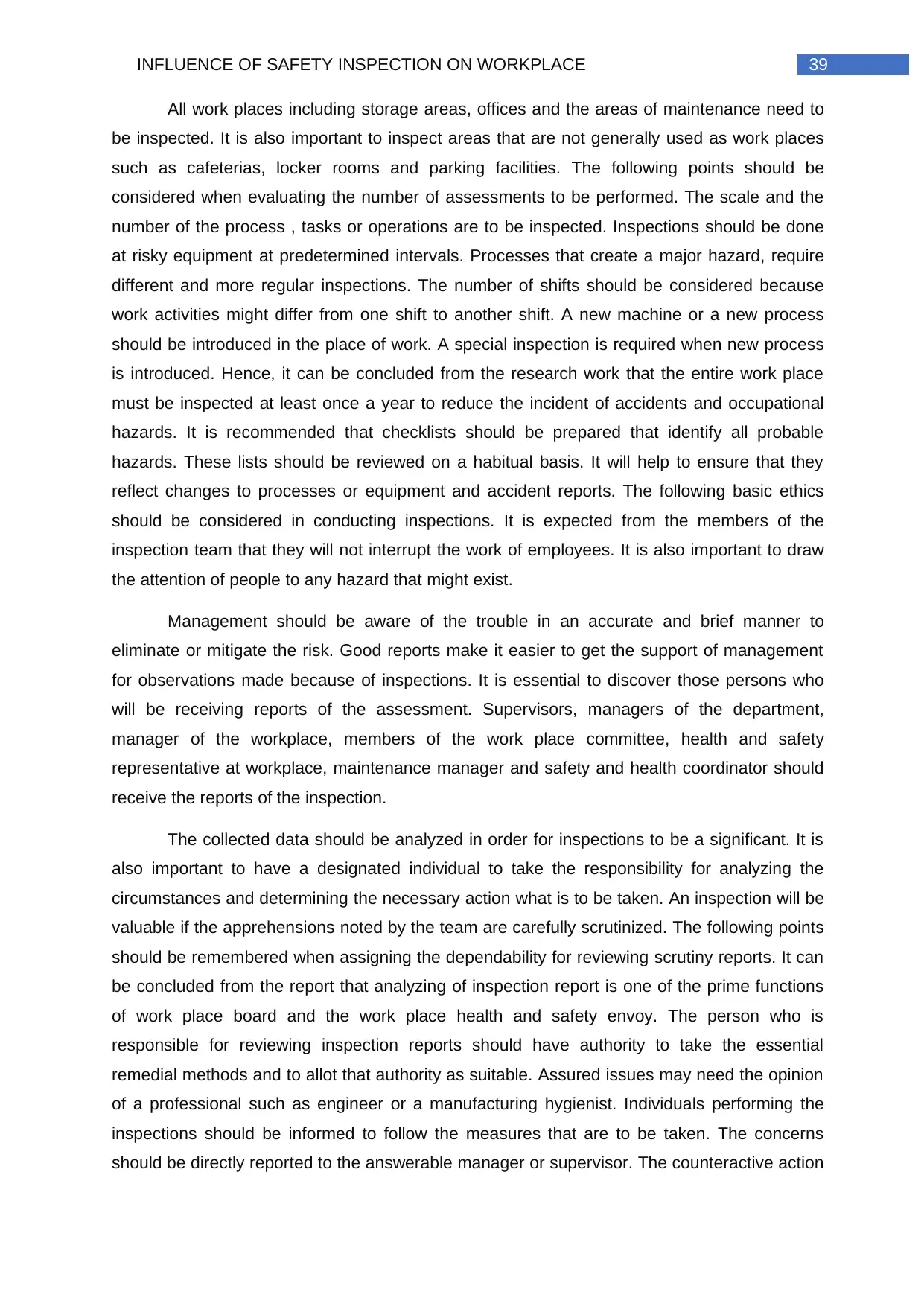
39INFLUENCE OF SAFETY INSPECTION ON WORKPLACE
All work places including storage areas, offices and the areas of maintenance need to
be inspected. It is also important to inspect areas that are not generally used as work places
such as cafeterias, locker rooms and parking facilities. The following points should be
considered when evaluating the number of assessments to be performed. The scale and the
number of the process , tasks or operations are to be inspected. Inspections should be done
at risky equipment at predetermined intervals. Processes that create a major hazard, require
different and more regular inspections. The number of shifts should be considered because
work activities might differ from one shift to another shift. A new machine or a new process
should be introduced in the place of work. A special inspection is required when new process
is introduced. Hence, it can be concluded from the research work that the entire work place
must be inspected at least once a year to reduce the incident of accidents and occupational
hazards. It is recommended that checklists should be prepared that identify all probable
hazards. These lists should be reviewed on a habitual basis. It will help to ensure that they
reflect changes to processes or equipment and accident reports. The following basic ethics
should be considered in conducting inspections. It is expected from the members of the
inspection team that they will not interrupt the work of employees. It is also important to draw
the attention of people to any hazard that might exist.
Management should be aware of the trouble in an accurate and brief manner to
eliminate or mitigate the risk. Good reports make it easier to get the support of management
for observations made because of inspections. It is essential to discover those persons who
will be receiving reports of the assessment. Supervisors, managers of the department,
manager of the workplace, members of the work place committee, health and safety
representative at workplace, maintenance manager and safety and health coordinator should
receive the reports of the inspection.
The collected data should be analyzed in order for inspections to be a significant. It is
also important to have a designated individual to take the responsibility for analyzing the
circumstances and determining the necessary action what is to be taken. An inspection will be
valuable if the apprehensions noted by the team are carefully scrutinized. The following points
should be remembered when assigning the dependability for reviewing scrutiny reports. It can
be concluded from the report that analyzing of inspection report is one of the prime functions
of work place board and the work place health and safety envoy. The person who is
responsible for reviewing inspection reports should have authority to take the essential
remedial methods and to allot that authority as suitable. Assured issues may need the opinion
of a professional such as engineer or a manufacturing hygienist. Individuals performing the
inspections should be informed to follow the measures that are to be taken. The concerns
should be directly reported to the answerable manager or supervisor. The counteractive action
All work places including storage areas, offices and the areas of maintenance need to
be inspected. It is also important to inspect areas that are not generally used as work places
such as cafeterias, locker rooms and parking facilities. The following points should be
considered when evaluating the number of assessments to be performed. The scale and the
number of the process , tasks or operations are to be inspected. Inspections should be done
at risky equipment at predetermined intervals. Processes that create a major hazard, require
different and more regular inspections. The number of shifts should be considered because
work activities might differ from one shift to another shift. A new machine or a new process
should be introduced in the place of work. A special inspection is required when new process
is introduced. Hence, it can be concluded from the research work that the entire work place
must be inspected at least once a year to reduce the incident of accidents and occupational
hazards. It is recommended that checklists should be prepared that identify all probable
hazards. These lists should be reviewed on a habitual basis. It will help to ensure that they
reflect changes to processes or equipment and accident reports. The following basic ethics
should be considered in conducting inspections. It is expected from the members of the
inspection team that they will not interrupt the work of employees. It is also important to draw
the attention of people to any hazard that might exist.
Management should be aware of the trouble in an accurate and brief manner to
eliminate or mitigate the risk. Good reports make it easier to get the support of management
for observations made because of inspections. It is essential to discover those persons who
will be receiving reports of the assessment. Supervisors, managers of the department,
manager of the workplace, members of the work place committee, health and safety
representative at workplace, maintenance manager and safety and health coordinator should
receive the reports of the inspection.
The collected data should be analyzed in order for inspections to be a significant. It is
also important to have a designated individual to take the responsibility for analyzing the
circumstances and determining the necessary action what is to be taken. An inspection will be
valuable if the apprehensions noted by the team are carefully scrutinized. The following points
should be remembered when assigning the dependability for reviewing scrutiny reports. It can
be concluded from the report that analyzing of inspection report is one of the prime functions
of work place board and the work place health and safety envoy. The person who is
responsible for reviewing inspection reports should have authority to take the essential
remedial methods and to allot that authority as suitable. Assured issues may need the opinion
of a professional such as engineer or a manufacturing hygienist. Individuals performing the
inspections should be informed to follow the measures that are to be taken. The concerns
should be directly reported to the answerable manager or supervisor. The counteractive action
Secure Best Marks with AI Grader
Need help grading? Try our AI Grader for instant feedback on your assignments.
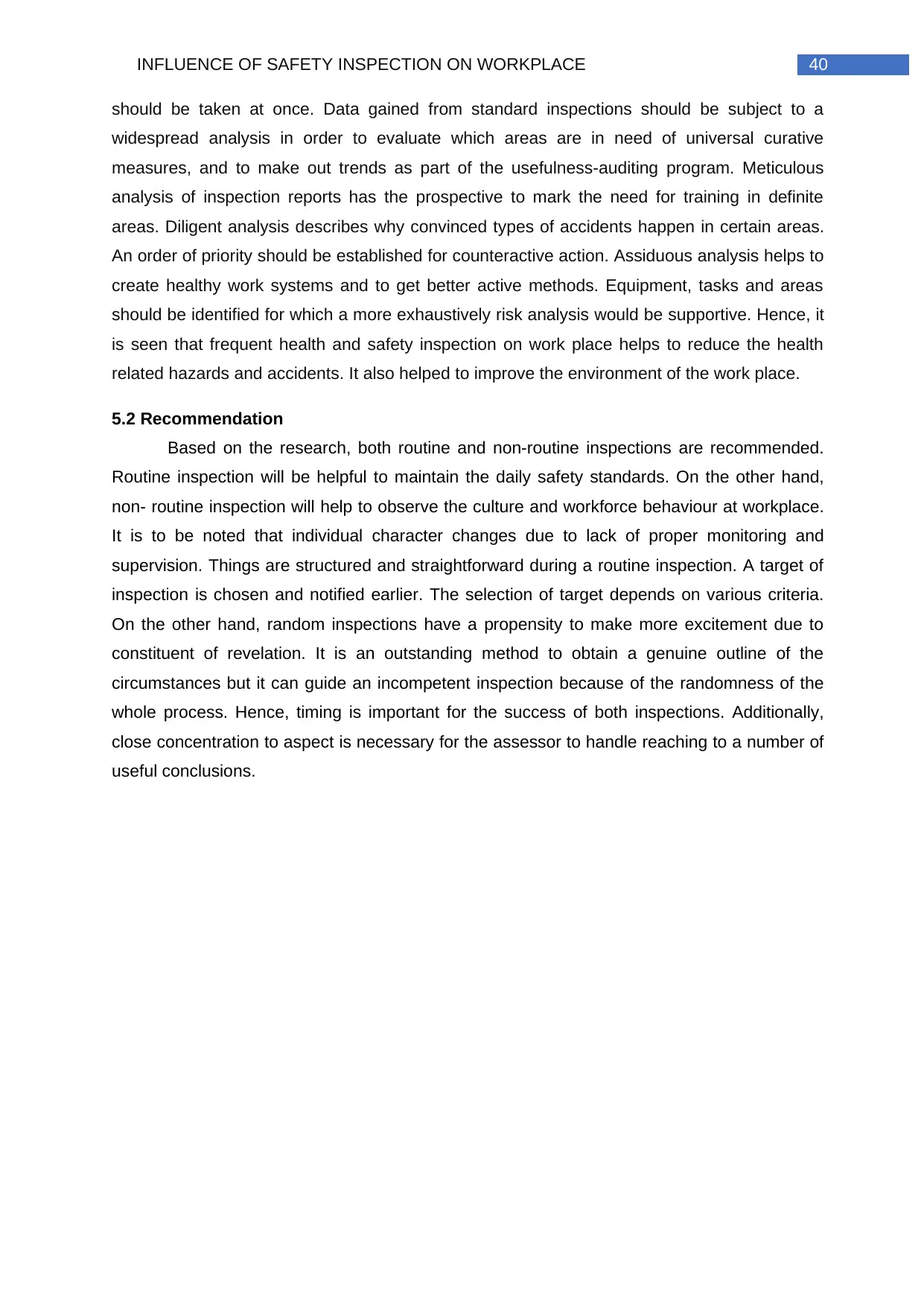
40INFLUENCE OF SAFETY INSPECTION ON WORKPLACE
should be taken at once. Data gained from standard inspections should be subject to a
widespread analysis in order to evaluate which areas are in need of universal curative
measures, and to make out trends as part of the usefulness-auditing program. Meticulous
analysis of inspection reports has the prospective to mark the need for training in definite
areas. Diligent analysis describes why convinced types of accidents happen in certain areas.
An order of priority should be established for counteractive action. Assiduous analysis helps to
create healthy work systems and to get better active methods. Equipment, tasks and areas
should be identified for which a more exhaustively risk analysis would be supportive. Hence, it
is seen that frequent health and safety inspection on work place helps to reduce the health
related hazards and accidents. It also helped to improve the environment of the work place.
5.2 Recommendation
Based on the research, both routine and non-routine inspections are recommended.
Routine inspection will be helpful to maintain the daily safety standards. On the other hand,
non- routine inspection will help to observe the culture and workforce behaviour at workplace.
It is to be noted that individual character changes due to lack of proper monitoring and
supervision. Things are structured and straightforward during a routine inspection. A target of
inspection is chosen and notified earlier. The selection of target depends on various criteria.
On the other hand, random inspections have a propensity to make more excitement due to
constituent of revelation. It is an outstanding method to obtain a genuine outline of the
circumstances but it can guide an incompetent inspection because of the randomness of the
whole process. Hence, timing is important for the success of both inspections. Additionally,
close concentration to aspect is necessary for the assessor to handle reaching to a number of
useful conclusions.
should be taken at once. Data gained from standard inspections should be subject to a
widespread analysis in order to evaluate which areas are in need of universal curative
measures, and to make out trends as part of the usefulness-auditing program. Meticulous
analysis of inspection reports has the prospective to mark the need for training in definite
areas. Diligent analysis describes why convinced types of accidents happen in certain areas.
An order of priority should be established for counteractive action. Assiduous analysis helps to
create healthy work systems and to get better active methods. Equipment, tasks and areas
should be identified for which a more exhaustively risk analysis would be supportive. Hence, it
is seen that frequent health and safety inspection on work place helps to reduce the health
related hazards and accidents. It also helped to improve the environment of the work place.
5.2 Recommendation
Based on the research, both routine and non-routine inspections are recommended.
Routine inspection will be helpful to maintain the daily safety standards. On the other hand,
non- routine inspection will help to observe the culture and workforce behaviour at workplace.
It is to be noted that individual character changes due to lack of proper monitoring and
supervision. Things are structured and straightforward during a routine inspection. A target of
inspection is chosen and notified earlier. The selection of target depends on various criteria.
On the other hand, random inspections have a propensity to make more excitement due to
constituent of revelation. It is an outstanding method to obtain a genuine outline of the
circumstances but it can guide an incompetent inspection because of the randomness of the
whole process. Hence, timing is important for the success of both inspections. Additionally,
close concentration to aspect is necessary for the assessor to handle reaching to a number of
useful conclusions.
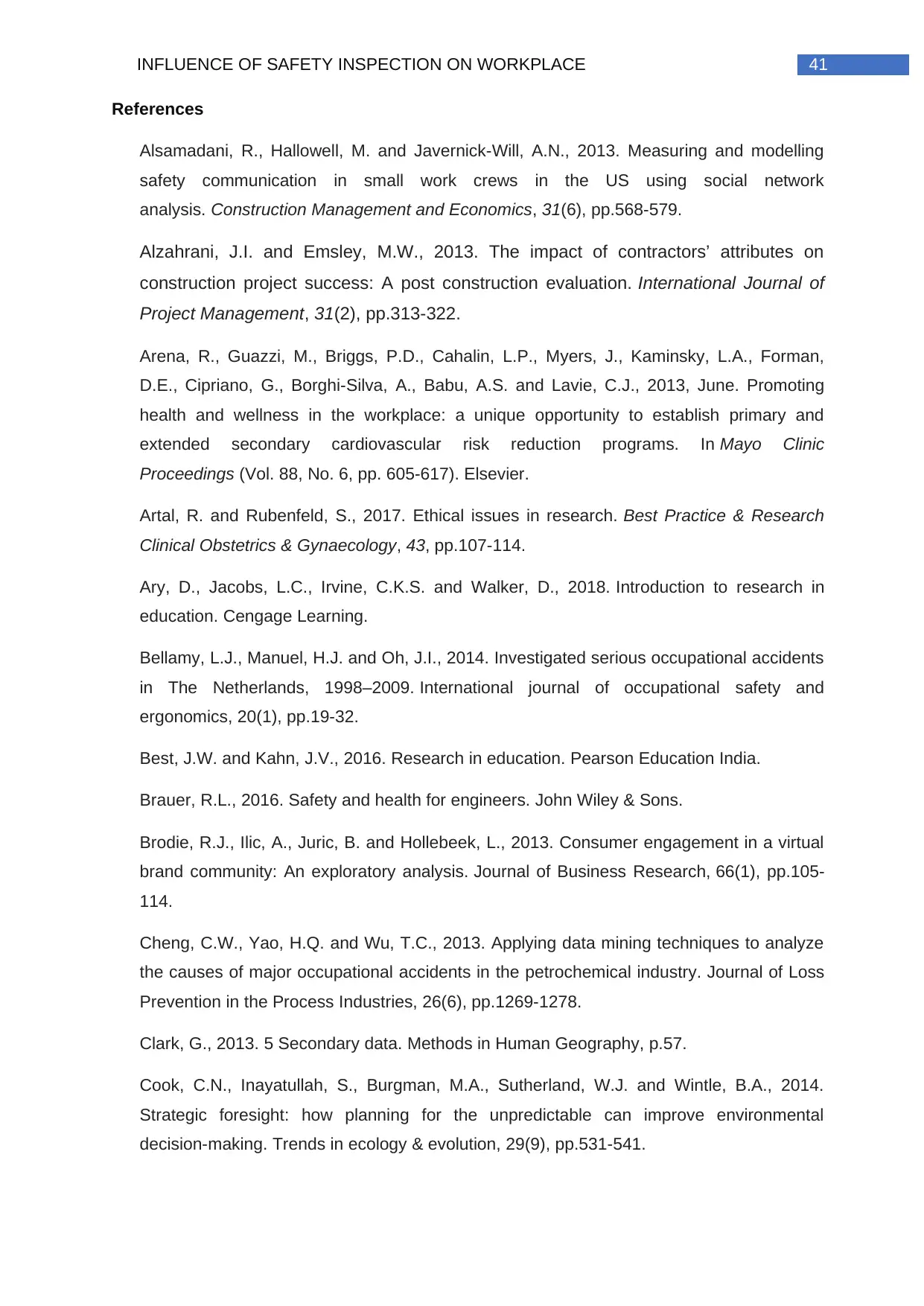
41INFLUENCE OF SAFETY INSPECTION ON WORKPLACE
References
Alsamadani, R., Hallowell, M. and Javernick-Will, A.N., 2013. Measuring and modelling
safety communication in small work crews in the US using social network
analysis. Construction Management and Economics, 31(6), pp.568-579.
Alzahrani, J.I. and Emsley, M.W., 2013. The impact of contractors’ attributes on
construction project success: A post construction evaluation. International Journal of
Project Management, 31(2), pp.313-322.
Arena, R., Guazzi, M., Briggs, P.D., Cahalin, L.P., Myers, J., Kaminsky, L.A., Forman,
D.E., Cipriano, G., Borghi-Silva, A., Babu, A.S. and Lavie, C.J., 2013, June. Promoting
health and wellness in the workplace: a unique opportunity to establish primary and
extended secondary cardiovascular risk reduction programs. In Mayo Clinic
Proceedings (Vol. 88, No. 6, pp. 605-617). Elsevier.
Artal, R. and Rubenfeld, S., 2017. Ethical issues in research. Best Practice & Research
Clinical Obstetrics & Gynaecology, 43, pp.107-114.
Ary, D., Jacobs, L.C., Irvine, C.K.S. and Walker, D., 2018. Introduction to research in
education. Cengage Learning.
Bellamy, L.J., Manuel, H.J. and Oh, J.I., 2014. Investigated serious occupational accidents
in The Netherlands, 1998–2009. International journal of occupational safety and
ergonomics, 20(1), pp.19-32.
Best, J.W. and Kahn, J.V., 2016. Research in education. Pearson Education India.
Brauer, R.L., 2016. Safety and health for engineers. John Wiley & Sons.
Brodie, R.J., Ilic, A., Juric, B. and Hollebeek, L., 2013. Consumer engagement in a virtual
brand community: An exploratory analysis. Journal of Business Research, 66(1), pp.105-
114.
Cheng, C.W., Yao, H.Q. and Wu, T.C., 2013. Applying data mining techniques to analyze
the causes of major occupational accidents in the petrochemical industry. Journal of Loss
Prevention in the Process Industries, 26(6), pp.1269-1278.
Clark, G., 2013. 5 Secondary data. Methods in Human Geography, p.57.
Cook, C.N., Inayatullah, S., Burgman, M.A., Sutherland, W.J. and Wintle, B.A., 2014.
Strategic foresight: how planning for the unpredictable can improve environmental
decision-making. Trends in ecology & evolution, 29(9), pp.531-541.
References
Alsamadani, R., Hallowell, M. and Javernick-Will, A.N., 2013. Measuring and modelling
safety communication in small work crews in the US using social network
analysis. Construction Management and Economics, 31(6), pp.568-579.
Alzahrani, J.I. and Emsley, M.W., 2013. The impact of contractors’ attributes on
construction project success: A post construction evaluation. International Journal of
Project Management, 31(2), pp.313-322.
Arena, R., Guazzi, M., Briggs, P.D., Cahalin, L.P., Myers, J., Kaminsky, L.A., Forman,
D.E., Cipriano, G., Borghi-Silva, A., Babu, A.S. and Lavie, C.J., 2013, June. Promoting
health and wellness in the workplace: a unique opportunity to establish primary and
extended secondary cardiovascular risk reduction programs. In Mayo Clinic
Proceedings (Vol. 88, No. 6, pp. 605-617). Elsevier.
Artal, R. and Rubenfeld, S., 2017. Ethical issues in research. Best Practice & Research
Clinical Obstetrics & Gynaecology, 43, pp.107-114.
Ary, D., Jacobs, L.C., Irvine, C.K.S. and Walker, D., 2018. Introduction to research in
education. Cengage Learning.
Bellamy, L.J., Manuel, H.J. and Oh, J.I., 2014. Investigated serious occupational accidents
in The Netherlands, 1998–2009. International journal of occupational safety and
ergonomics, 20(1), pp.19-32.
Best, J.W. and Kahn, J.V., 2016. Research in education. Pearson Education India.
Brauer, R.L., 2016. Safety and health for engineers. John Wiley & Sons.
Brodie, R.J., Ilic, A., Juric, B. and Hollebeek, L., 2013. Consumer engagement in a virtual
brand community: An exploratory analysis. Journal of Business Research, 66(1), pp.105-
114.
Cheng, C.W., Yao, H.Q. and Wu, T.C., 2013. Applying data mining techniques to analyze
the causes of major occupational accidents in the petrochemical industry. Journal of Loss
Prevention in the Process Industries, 26(6), pp.1269-1278.
Clark, G., 2013. 5 Secondary data. Methods in Human Geography, p.57.
Cook, C.N., Inayatullah, S., Burgman, M.A., Sutherland, W.J. and Wintle, B.A., 2014.
Strategic foresight: how planning for the unpredictable can improve environmental
decision-making. Trends in ecology & evolution, 29(9), pp.531-541.
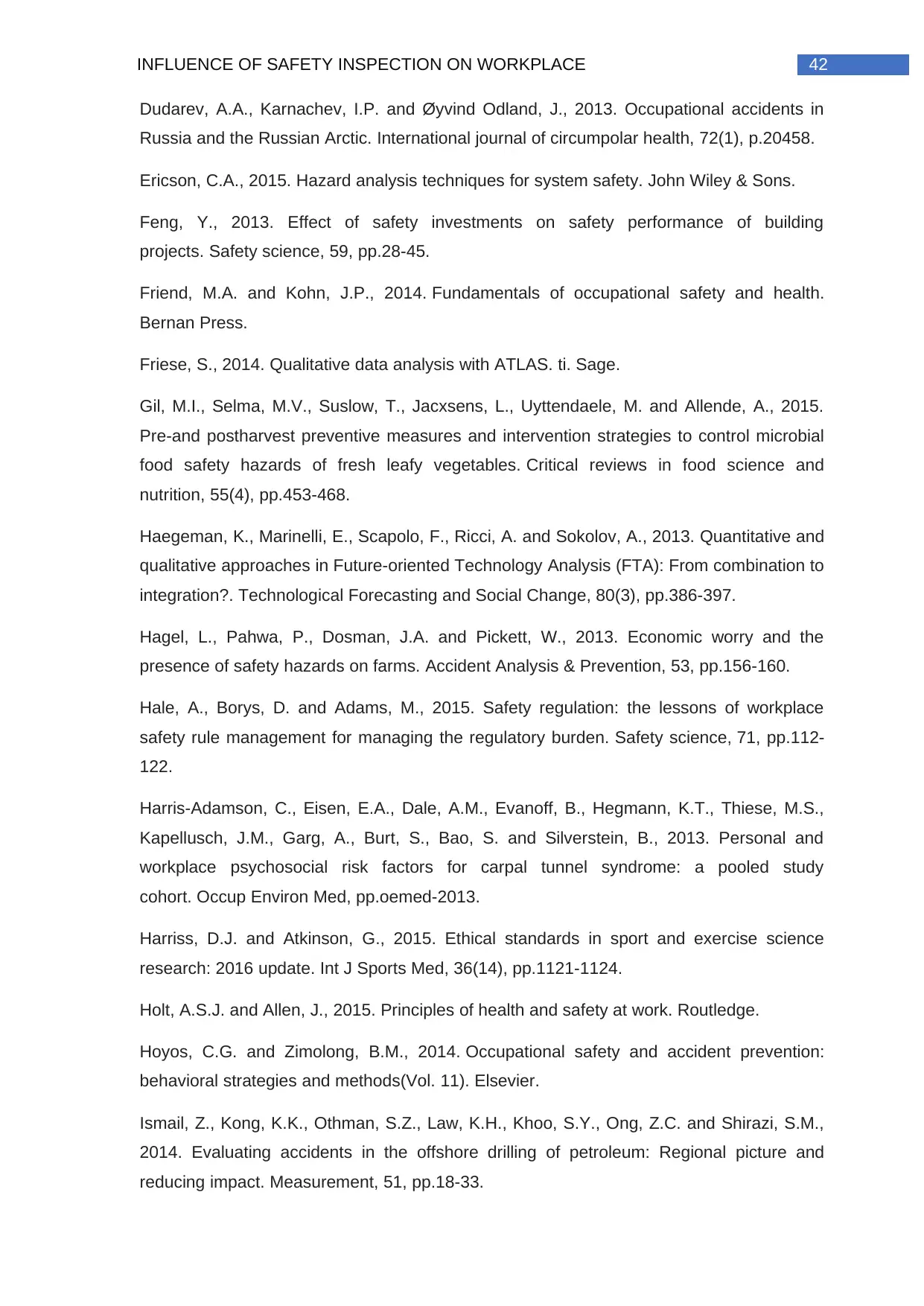
42INFLUENCE OF SAFETY INSPECTION ON WORKPLACE
Dudarev, A.A., Karnachev, I.P. and Øyvind Odland, J., 2013. Occupational accidents in
Russia and the Russian Arctic. International journal of circumpolar health, 72(1), p.20458.
Ericson, C.A., 2015. Hazard analysis techniques for system safety. John Wiley & Sons.
Feng, Y., 2013. Effect of safety investments on safety performance of building
projects. Safety science, 59, pp.28-45.
Friend, M.A. and Kohn, J.P., 2014. Fundamentals of occupational safety and health.
Bernan Press.
Friese, S., 2014. Qualitative data analysis with ATLAS. ti. Sage.
Gil, M.I., Selma, M.V., Suslow, T., Jacxsens, L., Uyttendaele, M. and Allende, A., 2015.
Pre-and postharvest preventive measures and intervention strategies to control microbial
food safety hazards of fresh leafy vegetables. Critical reviews in food science and
nutrition, 55(4), pp.453-468.
Haegeman, K., Marinelli, E., Scapolo, F., Ricci, A. and Sokolov, A., 2013. Quantitative and
qualitative approaches in Future-oriented Technology Analysis (FTA): From combination to
integration?. Technological Forecasting and Social Change, 80(3), pp.386-397.
Hagel, L., Pahwa, P., Dosman, J.A. and Pickett, W., 2013. Economic worry and the
presence of safety hazards on farms. Accident Analysis & Prevention, 53, pp.156-160.
Hale, A., Borys, D. and Adams, M., 2015. Safety regulation: the lessons of workplace
safety rule management for managing the regulatory burden. Safety science, 71, pp.112-
122.
Harris-Adamson, C., Eisen, E.A., Dale, A.M., Evanoff, B., Hegmann, K.T., Thiese, M.S.,
Kapellusch, J.M., Garg, A., Burt, S., Bao, S. and Silverstein, B., 2013. Personal and
workplace psychosocial risk factors for carpal tunnel syndrome: a pooled study
cohort. Occup Environ Med, pp.oemed-2013.
Harriss, D.J. and Atkinson, G., 2015. Ethical standards in sport and exercise science
research: 2016 update. Int J Sports Med, 36(14), pp.1121-1124.
Holt, A.S.J. and Allen, J., 2015. Principles of health and safety at work. Routledge.
Hoyos, C.G. and Zimolong, B.M., 2014. Occupational safety and accident prevention:
behavioral strategies and methods(Vol. 11). Elsevier.
Ismail, Z., Kong, K.K., Othman, S.Z., Law, K.H., Khoo, S.Y., Ong, Z.C. and Shirazi, S.M.,
2014. Evaluating accidents in the offshore drilling of petroleum: Regional picture and
reducing impact. Measurement, 51, pp.18-33.
Dudarev, A.A., Karnachev, I.P. and Øyvind Odland, J., 2013. Occupational accidents in
Russia and the Russian Arctic. International journal of circumpolar health, 72(1), p.20458.
Ericson, C.A., 2015. Hazard analysis techniques for system safety. John Wiley & Sons.
Feng, Y., 2013. Effect of safety investments on safety performance of building
projects. Safety science, 59, pp.28-45.
Friend, M.A. and Kohn, J.P., 2014. Fundamentals of occupational safety and health.
Bernan Press.
Friese, S., 2014. Qualitative data analysis with ATLAS. ti. Sage.
Gil, M.I., Selma, M.V., Suslow, T., Jacxsens, L., Uyttendaele, M. and Allende, A., 2015.
Pre-and postharvest preventive measures and intervention strategies to control microbial
food safety hazards of fresh leafy vegetables. Critical reviews in food science and
nutrition, 55(4), pp.453-468.
Haegeman, K., Marinelli, E., Scapolo, F., Ricci, A. and Sokolov, A., 2013. Quantitative and
qualitative approaches in Future-oriented Technology Analysis (FTA): From combination to
integration?. Technological Forecasting and Social Change, 80(3), pp.386-397.
Hagel, L., Pahwa, P., Dosman, J.A. and Pickett, W., 2013. Economic worry and the
presence of safety hazards on farms. Accident Analysis & Prevention, 53, pp.156-160.
Hale, A., Borys, D. and Adams, M., 2015. Safety regulation: the lessons of workplace
safety rule management for managing the regulatory burden. Safety science, 71, pp.112-
122.
Harris-Adamson, C., Eisen, E.A., Dale, A.M., Evanoff, B., Hegmann, K.T., Thiese, M.S.,
Kapellusch, J.M., Garg, A., Burt, S., Bao, S. and Silverstein, B., 2013. Personal and
workplace psychosocial risk factors for carpal tunnel syndrome: a pooled study
cohort. Occup Environ Med, pp.oemed-2013.
Harriss, D.J. and Atkinson, G., 2015. Ethical standards in sport and exercise science
research: 2016 update. Int J Sports Med, 36(14), pp.1121-1124.
Holt, A.S.J. and Allen, J., 2015. Principles of health and safety at work. Routledge.
Hoyos, C.G. and Zimolong, B.M., 2014. Occupational safety and accident prevention:
behavioral strategies and methods(Vol. 11). Elsevier.
Ismail, Z., Kong, K.K., Othman, S.Z., Law, K.H., Khoo, S.Y., Ong, Z.C. and Shirazi, S.M.,
2014. Evaluating accidents in the offshore drilling of petroleum: Regional picture and
reducing impact. Measurement, 51, pp.18-33.
Paraphrase This Document
Need a fresh take? Get an instant paraphrase of this document with our AI Paraphraser
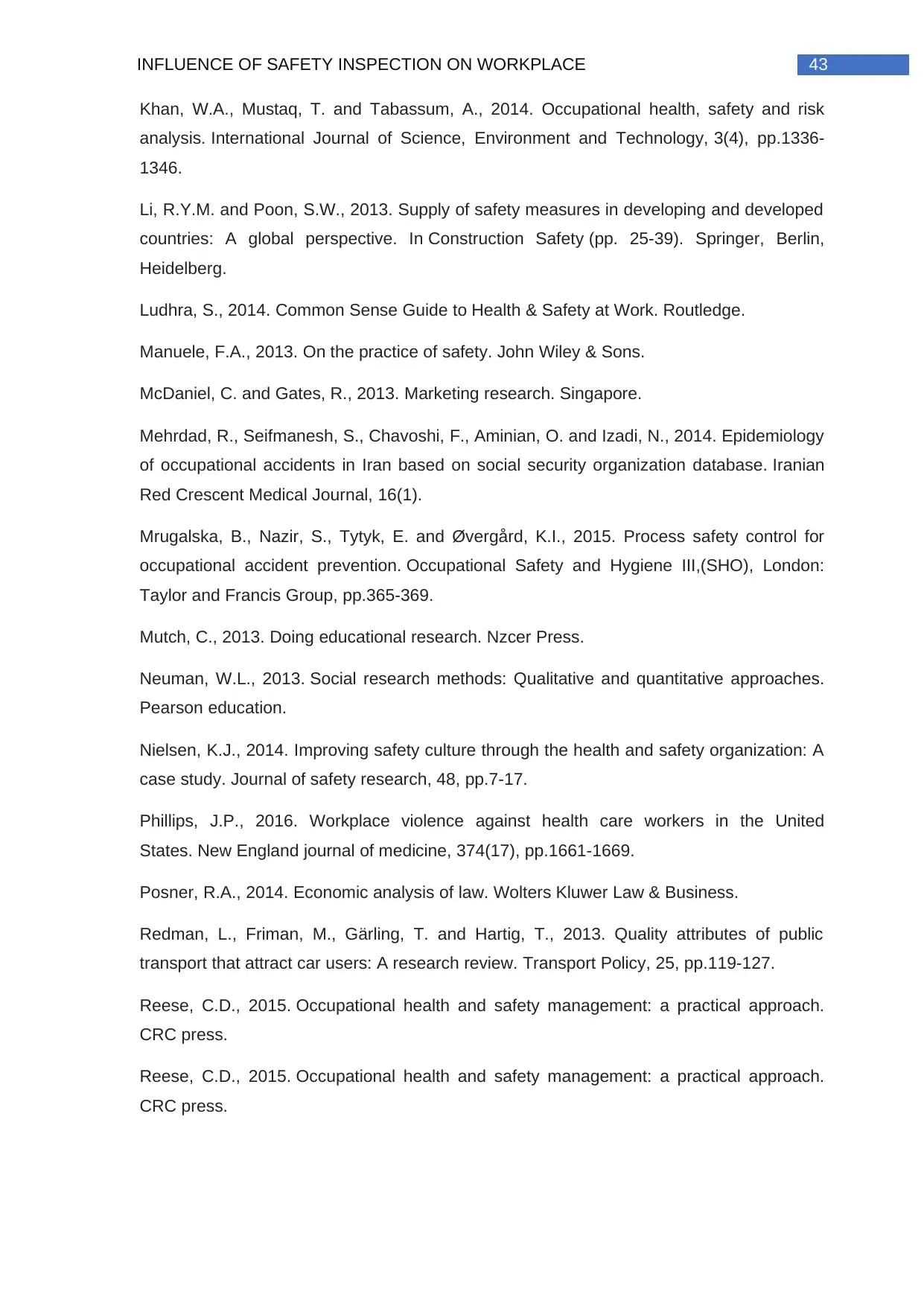
43INFLUENCE OF SAFETY INSPECTION ON WORKPLACE
Khan, W.A., Mustaq, T. and Tabassum, A., 2014. Occupational health, safety and risk
analysis. International Journal of Science, Environment and Technology, 3(4), pp.1336-
1346.
Li, R.Y.M. and Poon, S.W., 2013. Supply of safety measures in developing and developed
countries: A global perspective. In Construction Safety (pp. 25-39). Springer, Berlin,
Heidelberg.
Ludhra, S., 2014. Common Sense Guide to Health & Safety at Work. Routledge.
Manuele, F.A., 2013. On the practice of safety. John Wiley & Sons.
McDaniel, C. and Gates, R., 2013. Marketing research. Singapore.
Mehrdad, R., Seifmanesh, S., Chavoshi, F., Aminian, O. and Izadi, N., 2014. Epidemiology
of occupational accidents in Iran based on social security organization database. Iranian
Red Crescent Medical Journal, 16(1).
Mrugalska, B., Nazir, S., Tytyk, E. and Øvergård, K.I., 2015. Process safety control for
occupational accident prevention. Occupational Safety and Hygiene III,(SHO), London:
Taylor and Francis Group, pp.365-369.
Mutch, C., 2013. Doing educational research. Nzcer Press.
Neuman, W.L., 2013. Social research methods: Qualitative and quantitative approaches.
Pearson education.
Nielsen, K.J., 2014. Improving safety culture through the health and safety organization: A
case study. Journal of safety research, 48, pp.7-17.
Phillips, J.P., 2016. Workplace violence against health care workers in the United
States. New England journal of medicine, 374(17), pp.1661-1669.
Posner, R.A., 2014. Economic analysis of law. Wolters Kluwer Law & Business.
Redman, L., Friman, M., Gärling, T. and Hartig, T., 2013. Quality attributes of public
transport that attract car users: A research review. Transport Policy, 25, pp.119-127.
Reese, C.D., 2015. Occupational health and safety management: a practical approach.
CRC press.
Reese, C.D., 2015. Occupational health and safety management: a practical approach.
CRC press.
Khan, W.A., Mustaq, T. and Tabassum, A., 2014. Occupational health, safety and risk
analysis. International Journal of Science, Environment and Technology, 3(4), pp.1336-
1346.
Li, R.Y.M. and Poon, S.W., 2013. Supply of safety measures in developing and developed
countries: A global perspective. In Construction Safety (pp. 25-39). Springer, Berlin,
Heidelberg.
Ludhra, S., 2014. Common Sense Guide to Health & Safety at Work. Routledge.
Manuele, F.A., 2013. On the practice of safety. John Wiley & Sons.
McDaniel, C. and Gates, R., 2013. Marketing research. Singapore.
Mehrdad, R., Seifmanesh, S., Chavoshi, F., Aminian, O. and Izadi, N., 2014. Epidemiology
of occupational accidents in Iran based on social security organization database. Iranian
Red Crescent Medical Journal, 16(1).
Mrugalska, B., Nazir, S., Tytyk, E. and Øvergård, K.I., 2015. Process safety control for
occupational accident prevention. Occupational Safety and Hygiene III,(SHO), London:
Taylor and Francis Group, pp.365-369.
Mutch, C., 2013. Doing educational research. Nzcer Press.
Neuman, W.L., 2013. Social research methods: Qualitative and quantitative approaches.
Pearson education.
Nielsen, K.J., 2014. Improving safety culture through the health and safety organization: A
case study. Journal of safety research, 48, pp.7-17.
Phillips, J.P., 2016. Workplace violence against health care workers in the United
States. New England journal of medicine, 374(17), pp.1661-1669.
Posner, R.A., 2014. Economic analysis of law. Wolters Kluwer Law & Business.
Redman, L., Friman, M., Gärling, T. and Hartig, T., 2013. Quality attributes of public
transport that attract car users: A research review. Transport Policy, 25, pp.119-127.
Reese, C.D., 2015. Occupational health and safety management: a practical approach.
CRC press.
Reese, C.D., 2015. Occupational health and safety management: a practical approach.
CRC press.
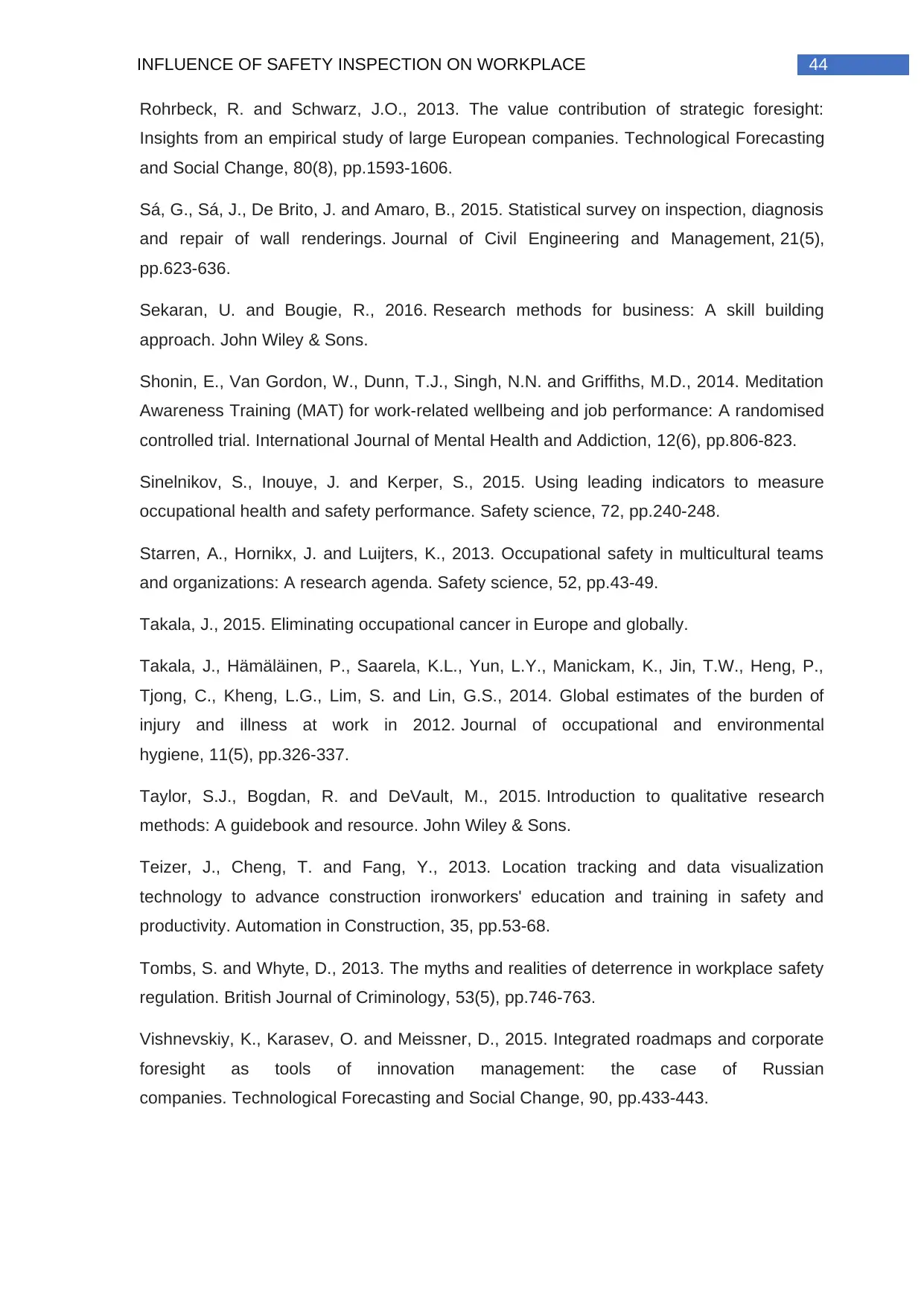
44INFLUENCE OF SAFETY INSPECTION ON WORKPLACE
Rohrbeck, R. and Schwarz, J.O., 2013. The value contribution of strategic foresight:
Insights from an empirical study of large European companies. Technological Forecasting
and Social Change, 80(8), pp.1593-1606.
Sá, G., Sá, J., De Brito, J. and Amaro, B., 2015. Statistical survey on inspection, diagnosis
and repair of wall renderings. Journal of Civil Engineering and Management, 21(5),
pp.623-636.
Sekaran, U. and Bougie, R., 2016. Research methods for business: A skill building
approach. John Wiley & Sons.
Shonin, E., Van Gordon, W., Dunn, T.J., Singh, N.N. and Griffiths, M.D., 2014. Meditation
Awareness Training (MAT) for work-related wellbeing and job performance: A randomised
controlled trial. International Journal of Mental Health and Addiction, 12(6), pp.806-823.
Sinelnikov, S., Inouye, J. and Kerper, S., 2015. Using leading indicators to measure
occupational health and safety performance. Safety science, 72, pp.240-248.
Starren, A., Hornikx, J. and Luijters, K., 2013. Occupational safety in multicultural teams
and organizations: A research agenda. Safety science, 52, pp.43-49.
Takala, J., 2015. Eliminating occupational cancer in Europe and globally.
Takala, J., Hämäläinen, P., Saarela, K.L., Yun, L.Y., Manickam, K., Jin, T.W., Heng, P.,
Tjong, C., Kheng, L.G., Lim, S. and Lin, G.S., 2014. Global estimates of the burden of
injury and illness at work in 2012. Journal of occupational and environmental
hygiene, 11(5), pp.326-337.
Taylor, S.J., Bogdan, R. and DeVault, M., 2015. Introduction to qualitative research
methods: A guidebook and resource. John Wiley & Sons.
Teizer, J., Cheng, T. and Fang, Y., 2013. Location tracking and data visualization
technology to advance construction ironworkers' education and training in safety and
productivity. Automation in Construction, 35, pp.53-68.
Tombs, S. and Whyte, D., 2013. The myths and realities of deterrence in workplace safety
regulation. British Journal of Criminology, 53(5), pp.746-763.
Vishnevskiy, K., Karasev, O. and Meissner, D., 2015. Integrated roadmaps and corporate
foresight as tools of innovation management: the case of Russian
companies. Technological Forecasting and Social Change, 90, pp.433-443.
Rohrbeck, R. and Schwarz, J.O., 2013. The value contribution of strategic foresight:
Insights from an empirical study of large European companies. Technological Forecasting
and Social Change, 80(8), pp.1593-1606.
Sá, G., Sá, J., De Brito, J. and Amaro, B., 2015. Statistical survey on inspection, diagnosis
and repair of wall renderings. Journal of Civil Engineering and Management, 21(5),
pp.623-636.
Sekaran, U. and Bougie, R., 2016. Research methods for business: A skill building
approach. John Wiley & Sons.
Shonin, E., Van Gordon, W., Dunn, T.J., Singh, N.N. and Griffiths, M.D., 2014. Meditation
Awareness Training (MAT) for work-related wellbeing and job performance: A randomised
controlled trial. International Journal of Mental Health and Addiction, 12(6), pp.806-823.
Sinelnikov, S., Inouye, J. and Kerper, S., 2015. Using leading indicators to measure
occupational health and safety performance. Safety science, 72, pp.240-248.
Starren, A., Hornikx, J. and Luijters, K., 2013. Occupational safety in multicultural teams
and organizations: A research agenda. Safety science, 52, pp.43-49.
Takala, J., 2015. Eliminating occupational cancer in Europe and globally.
Takala, J., Hämäläinen, P., Saarela, K.L., Yun, L.Y., Manickam, K., Jin, T.W., Heng, P.,
Tjong, C., Kheng, L.G., Lim, S. and Lin, G.S., 2014. Global estimates of the burden of
injury and illness at work in 2012. Journal of occupational and environmental
hygiene, 11(5), pp.326-337.
Taylor, S.J., Bogdan, R. and DeVault, M., 2015. Introduction to qualitative research
methods: A guidebook and resource. John Wiley & Sons.
Teizer, J., Cheng, T. and Fang, Y., 2013. Location tracking and data visualization
technology to advance construction ironworkers' education and training in safety and
productivity. Automation in Construction, 35, pp.53-68.
Tombs, S. and Whyte, D., 2013. The myths and realities of deterrence in workplace safety
regulation. British Journal of Criminology, 53(5), pp.746-763.
Vishnevskiy, K., Karasev, O. and Meissner, D., 2015. Integrated roadmaps and corporate
foresight as tools of innovation management: the case of Russian
companies. Technological Forecasting and Social Change, 90, pp.433-443.
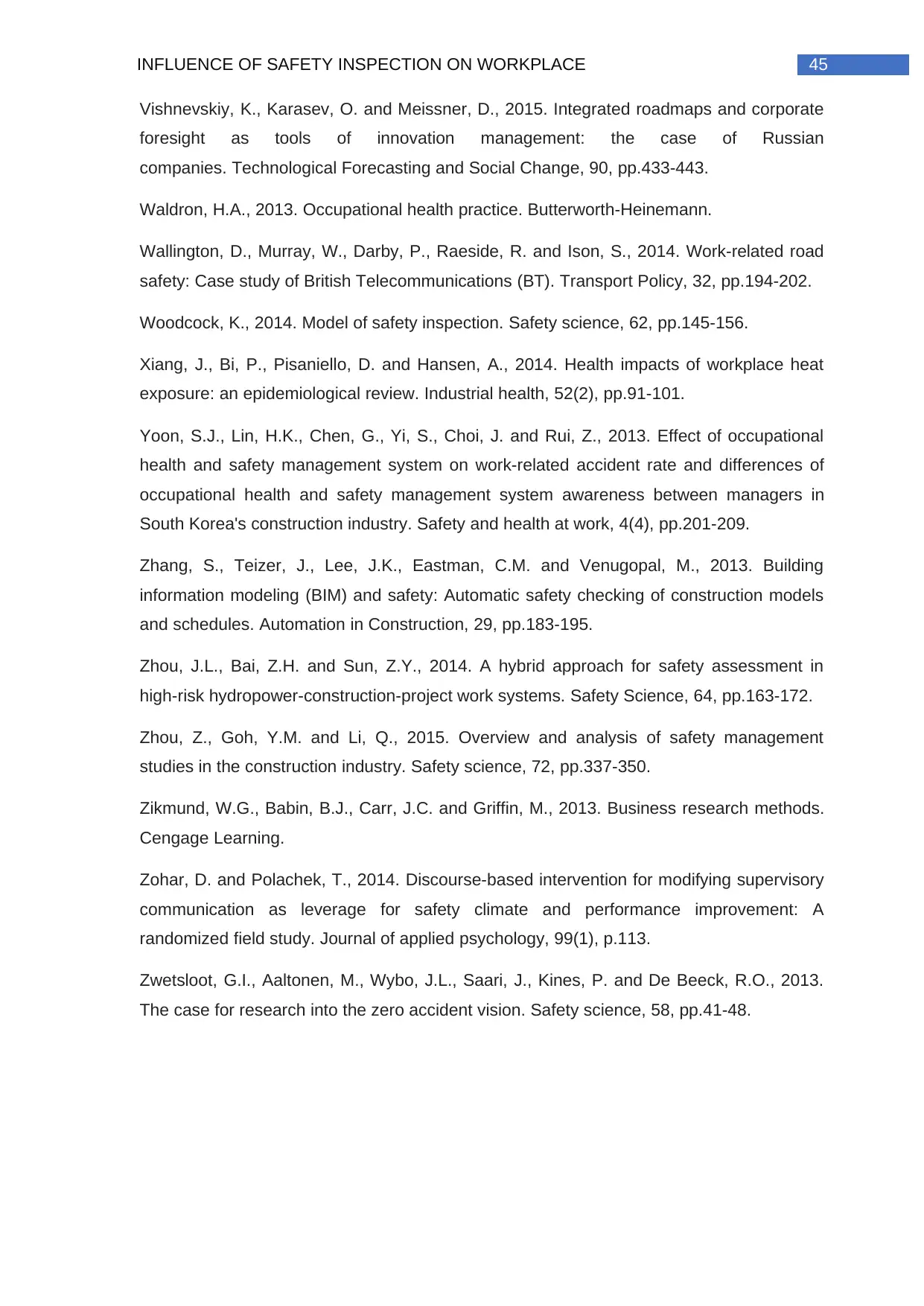
45INFLUENCE OF SAFETY INSPECTION ON WORKPLACE
Vishnevskiy, K., Karasev, O. and Meissner, D., 2015. Integrated roadmaps and corporate
foresight as tools of innovation management: the case of Russian
companies. Technological Forecasting and Social Change, 90, pp.433-443.
Waldron, H.A., 2013. Occupational health practice. Butterworth-Heinemann.
Wallington, D., Murray, W., Darby, P., Raeside, R. and Ison, S., 2014. Work-related road
safety: Case study of British Telecommunications (BT). Transport Policy, 32, pp.194-202.
Woodcock, K., 2014. Model of safety inspection. Safety science, 62, pp.145-156.
Xiang, J., Bi, P., Pisaniello, D. and Hansen, A., 2014. Health impacts of workplace heat
exposure: an epidemiological review. Industrial health, 52(2), pp.91-101.
Yoon, S.J., Lin, H.K., Chen, G., Yi, S., Choi, J. and Rui, Z., 2013. Effect of occupational
health and safety management system on work-related accident rate and differences of
occupational health and safety management system awareness between managers in
South Korea's construction industry. Safety and health at work, 4(4), pp.201-209.
Zhang, S., Teizer, J., Lee, J.K., Eastman, C.M. and Venugopal, M., 2013. Building
information modeling (BIM) and safety: Automatic safety checking of construction models
and schedules. Automation in Construction, 29, pp.183-195.
Zhou, J.L., Bai, Z.H. and Sun, Z.Y., 2014. A hybrid approach for safety assessment in
high-risk hydropower-construction-project work systems. Safety Science, 64, pp.163-172.
Zhou, Z., Goh, Y.M. and Li, Q., 2015. Overview and analysis of safety management
studies in the construction industry. Safety science, 72, pp.337-350.
Zikmund, W.G., Babin, B.J., Carr, J.C. and Griffin, M., 2013. Business research methods.
Cengage Learning.
Zohar, D. and Polachek, T., 2014. Discourse-based intervention for modifying supervisory
communication as leverage for safety climate and performance improvement: A
randomized field study. Journal of applied psychology, 99(1), p.113.
Zwetsloot, G.I., Aaltonen, M., Wybo, J.L., Saari, J., Kines, P. and De Beeck, R.O., 2013.
The case for research into the zero accident vision. Safety science, 58, pp.41-48.
Vishnevskiy, K., Karasev, O. and Meissner, D., 2015. Integrated roadmaps and corporate
foresight as tools of innovation management: the case of Russian
companies. Technological Forecasting and Social Change, 90, pp.433-443.
Waldron, H.A., 2013. Occupational health practice. Butterworth-Heinemann.
Wallington, D., Murray, W., Darby, P., Raeside, R. and Ison, S., 2014. Work-related road
safety: Case study of British Telecommunications (BT). Transport Policy, 32, pp.194-202.
Woodcock, K., 2014. Model of safety inspection. Safety science, 62, pp.145-156.
Xiang, J., Bi, P., Pisaniello, D. and Hansen, A., 2014. Health impacts of workplace heat
exposure: an epidemiological review. Industrial health, 52(2), pp.91-101.
Yoon, S.J., Lin, H.K., Chen, G., Yi, S., Choi, J. and Rui, Z., 2013. Effect of occupational
health and safety management system on work-related accident rate and differences of
occupational health and safety management system awareness between managers in
South Korea's construction industry. Safety and health at work, 4(4), pp.201-209.
Zhang, S., Teizer, J., Lee, J.K., Eastman, C.M. and Venugopal, M., 2013. Building
information modeling (BIM) and safety: Automatic safety checking of construction models
and schedules. Automation in Construction, 29, pp.183-195.
Zhou, J.L., Bai, Z.H. and Sun, Z.Y., 2014. A hybrid approach for safety assessment in
high-risk hydropower-construction-project work systems. Safety Science, 64, pp.163-172.
Zhou, Z., Goh, Y.M. and Li, Q., 2015. Overview and analysis of safety management
studies in the construction industry. Safety science, 72, pp.337-350.
Zikmund, W.G., Babin, B.J., Carr, J.C. and Griffin, M., 2013. Business research methods.
Cengage Learning.
Zohar, D. and Polachek, T., 2014. Discourse-based intervention for modifying supervisory
communication as leverage for safety climate and performance improvement: A
randomized field study. Journal of applied psychology, 99(1), p.113.
Zwetsloot, G.I., Aaltonen, M., Wybo, J.L., Saari, J., Kines, P. and De Beeck, R.O., 2013.
The case for research into the zero accident vision. Safety science, 58, pp.41-48.
Secure Best Marks with AI Grader
Need help grading? Try our AI Grader for instant feedback on your assignments.
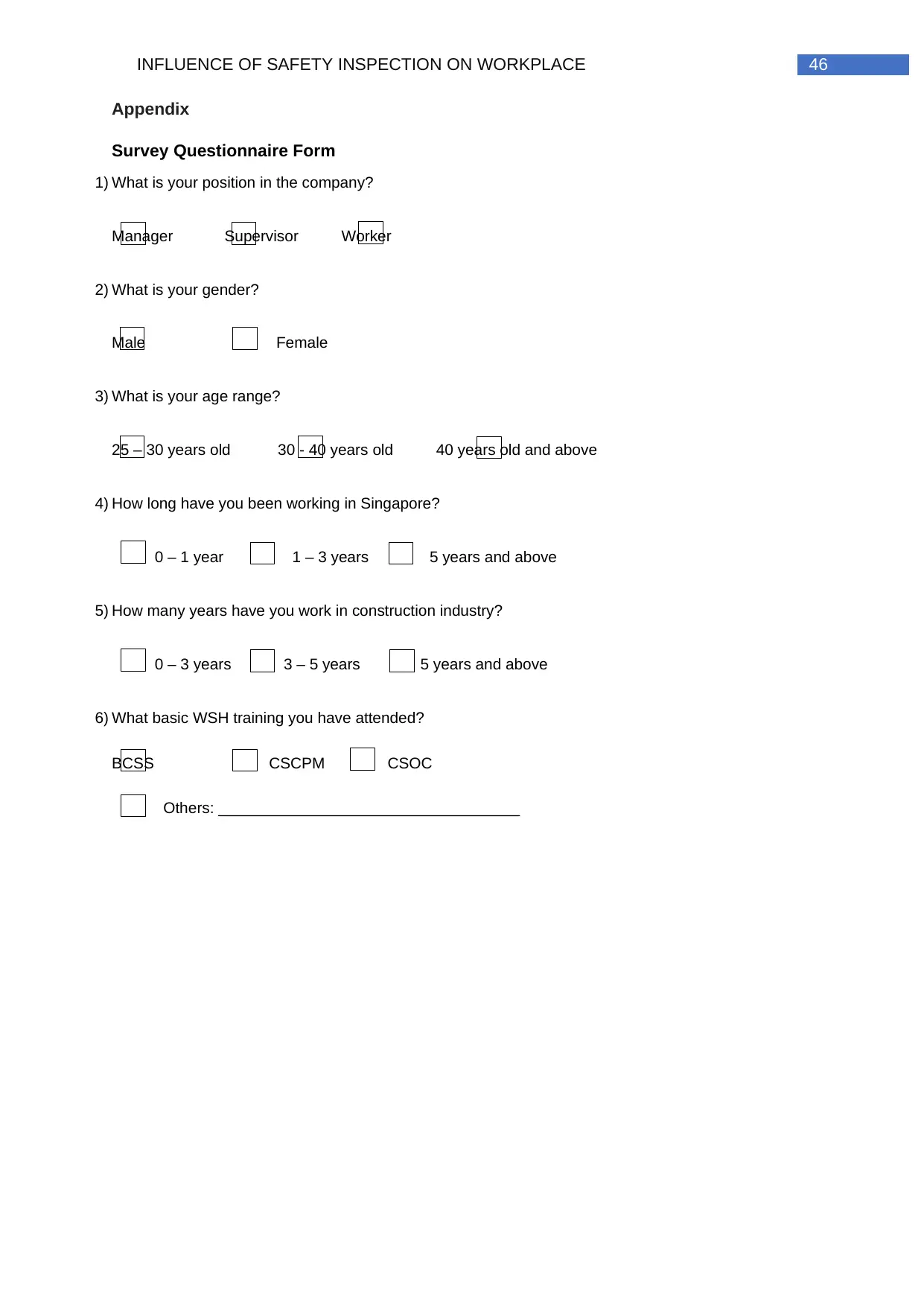
46INFLUENCE OF SAFETY INSPECTION ON WORKPLACE
Appendix
Survey Questionnaire Form
1) What is your position in the company?
Manager Supervisor Worker
2) What is your gender?
Male Female
3) What is your age range?
25 – 30 years old 30 - 40 years old 40 years old and above
4) How long have you been working in Singapore?
0 – 1 year 1 – 3 years 5 years and above
5) How many years have you work in construction industry?
0 – 3 years 3 – 5 years 5 years and above
6) What basic WSH training you have attended?
BCSS CSCPM CSOC
Others: ___________________________________
Appendix
Survey Questionnaire Form
1) What is your position in the company?
Manager Supervisor Worker
2) What is your gender?
Male Female
3) What is your age range?
25 – 30 years old 30 - 40 years old 40 years old and above
4) How long have you been working in Singapore?
0 – 1 year 1 – 3 years 5 years and above
5) How many years have you work in construction industry?
0 – 3 years 3 – 5 years 5 years and above
6) What basic WSH training you have attended?
BCSS CSCPM CSOC
Others: ___________________________________
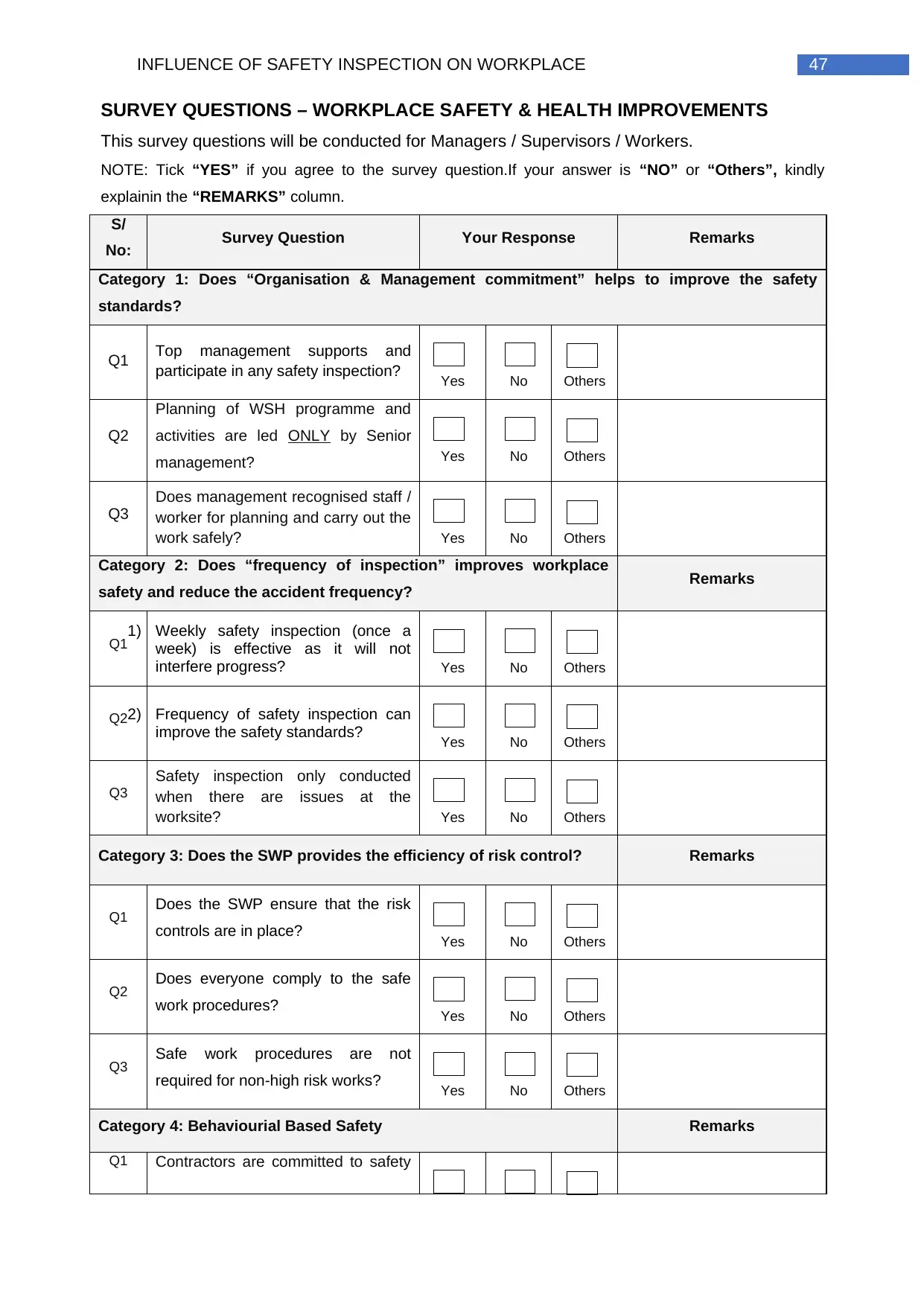
47INFLUENCE OF SAFETY INSPECTION ON WORKPLACE
SURVEY QUESTIONS – WORKPLACE SAFETY & HEALTH IMPROVEMENTS
This survey questions will be conducted for Managers / Supervisors / Workers.
NOTE: Tick “YES” if you agree to the survey question.If your answer is “NO” or “Others”, kindly
explainin the “REMARKS” column.
S/
No: Survey Question Your Response Remarks
Category 1: Does “Organisation & Management commitment” helps to improve the safety
standards?
Q1 Top management supports and
participate in any safety inspection? Yes No Others
Q2
Planning of WSH programme and
activities are led ONLY by Senior
management? Yes No Others
Q3
Does management recognised staff /
worker for planning and carry out the
work safely? Yes No Others
Category 2: Does “frequency of inspection” improves workplace
safety and reduce the accident frequency? Remarks
Q11) Weekly safety inspection (once a
week) is effective as it will not
interfere progress? Yes No Others
Q22) Frequency of safety inspection can
improve the safety standards? Yes No Others
Q3
Safety inspection only conducted
when there are issues at the
worksite? Yes No Others
Category 3: Does the SWP provides the efficiency of risk control? Remarks
Q1 Does the SWP ensure that the risk
controls are in place? Yes No Others
Q2 Does everyone comply to the safe
work procedures? Yes No Others
Q3 Safe work procedures are not
required for non-high risk works? Yes No Others
Category 4: Behaviourial Based Safety Remarks
Q1 Contractors are committed to safety
SURVEY QUESTIONS – WORKPLACE SAFETY & HEALTH IMPROVEMENTS
This survey questions will be conducted for Managers / Supervisors / Workers.
NOTE: Tick “YES” if you agree to the survey question.If your answer is “NO” or “Others”, kindly
explainin the “REMARKS” column.
S/
No: Survey Question Your Response Remarks
Category 1: Does “Organisation & Management commitment” helps to improve the safety
standards?
Q1 Top management supports and
participate in any safety inspection? Yes No Others
Q2
Planning of WSH programme and
activities are led ONLY by Senior
management? Yes No Others
Q3
Does management recognised staff /
worker for planning and carry out the
work safely? Yes No Others
Category 2: Does “frequency of inspection” improves workplace
safety and reduce the accident frequency? Remarks
Q11) Weekly safety inspection (once a
week) is effective as it will not
interfere progress? Yes No Others
Q22) Frequency of safety inspection can
improve the safety standards? Yes No Others
Q3
Safety inspection only conducted
when there are issues at the
worksite? Yes No Others
Category 3: Does the SWP provides the efficiency of risk control? Remarks
Q1 Does the SWP ensure that the risk
controls are in place? Yes No Others
Q2 Does everyone comply to the safe
work procedures? Yes No Others
Q3 Safe work procedures are not
required for non-high risk works? Yes No Others
Category 4: Behaviourial Based Safety Remarks
Q1 Contractors are committed to safety
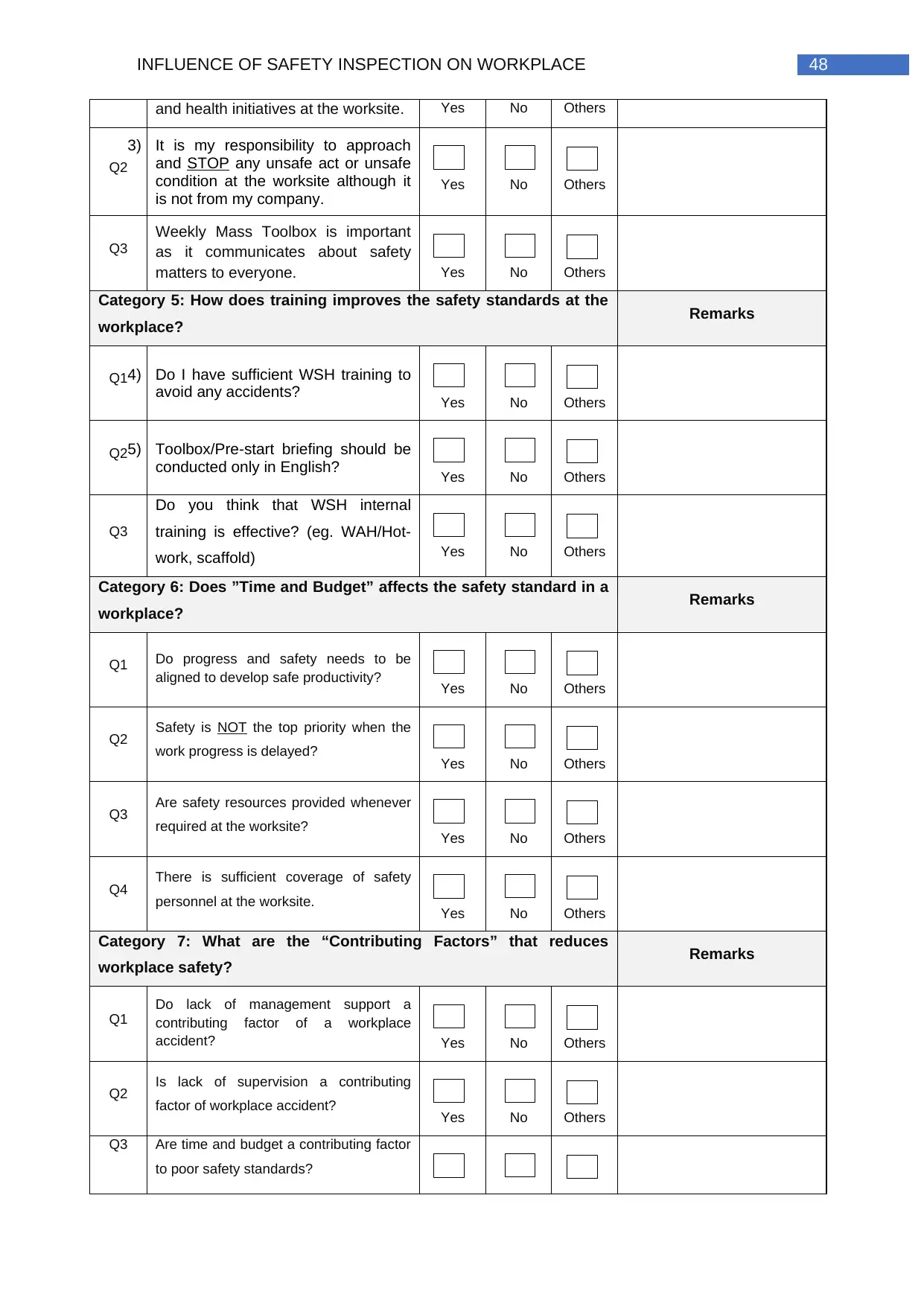
48INFLUENCE OF SAFETY INSPECTION ON WORKPLACE
and health initiatives at the worksite. Yes No Others
Q2
3) It is my responsibility to approach
and STOP any unsafe act or unsafe
condition at the worksite although it
is not from my company. Yes No Others
Q3
Weekly Mass Toolbox is important
as it communicates about safety
matters to everyone. Yes No Others
Category 5: How does training improves the safety standards at the
workplace? Remarks
Q14) Do I have sufficient WSH training to
avoid any accidents? Yes No Others
Q25) Toolbox/Pre-start briefing should be
conducted only in English? Yes No Others
Q3
Do you think that WSH internal
training is effective? (eg. WAH/Hot-
work, scaffold) Yes No Others
Category 6: Does ”Time and Budget” affects the safety standard in a
workplace? Remarks
Q1 Do progress and safety needs to be
aligned to develop safe productivity? Yes No Others
Q2 Safety is NOT the top priority when the
work progress is delayed? Yes No Others
Q3 Are safety resources provided whenever
required at the worksite? Yes No Others
Q4 There is sufficient coverage of safety
personnel at the worksite. Yes No Others
Category 7: What are the “Contributing Factors” that reduces
workplace safety? Remarks
Q1
Do lack of management support a
contributing factor of a workplace
accident? Yes No Others
Q2 Is lack of supervision a contributing
factor of workplace accident? Yes No Others
Q3 Are time and budget a contributing factor
to poor safety standards?
and health initiatives at the worksite. Yes No Others
Q2
3) It is my responsibility to approach
and STOP any unsafe act or unsafe
condition at the worksite although it
is not from my company. Yes No Others
Q3
Weekly Mass Toolbox is important
as it communicates about safety
matters to everyone. Yes No Others
Category 5: How does training improves the safety standards at the
workplace? Remarks
Q14) Do I have sufficient WSH training to
avoid any accidents? Yes No Others
Q25) Toolbox/Pre-start briefing should be
conducted only in English? Yes No Others
Q3
Do you think that WSH internal
training is effective? (eg. WAH/Hot-
work, scaffold) Yes No Others
Category 6: Does ”Time and Budget” affects the safety standard in a
workplace? Remarks
Q1 Do progress and safety needs to be
aligned to develop safe productivity? Yes No Others
Q2 Safety is NOT the top priority when the
work progress is delayed? Yes No Others
Q3 Are safety resources provided whenever
required at the worksite? Yes No Others
Q4 There is sufficient coverage of safety
personnel at the worksite. Yes No Others
Category 7: What are the “Contributing Factors” that reduces
workplace safety? Remarks
Q1
Do lack of management support a
contributing factor of a workplace
accident? Yes No Others
Q2 Is lack of supervision a contributing
factor of workplace accident? Yes No Others
Q3 Are time and budget a contributing factor
to poor safety standards?
Paraphrase This Document
Need a fresh take? Get an instant paraphrase of this document with our AI Paraphraser
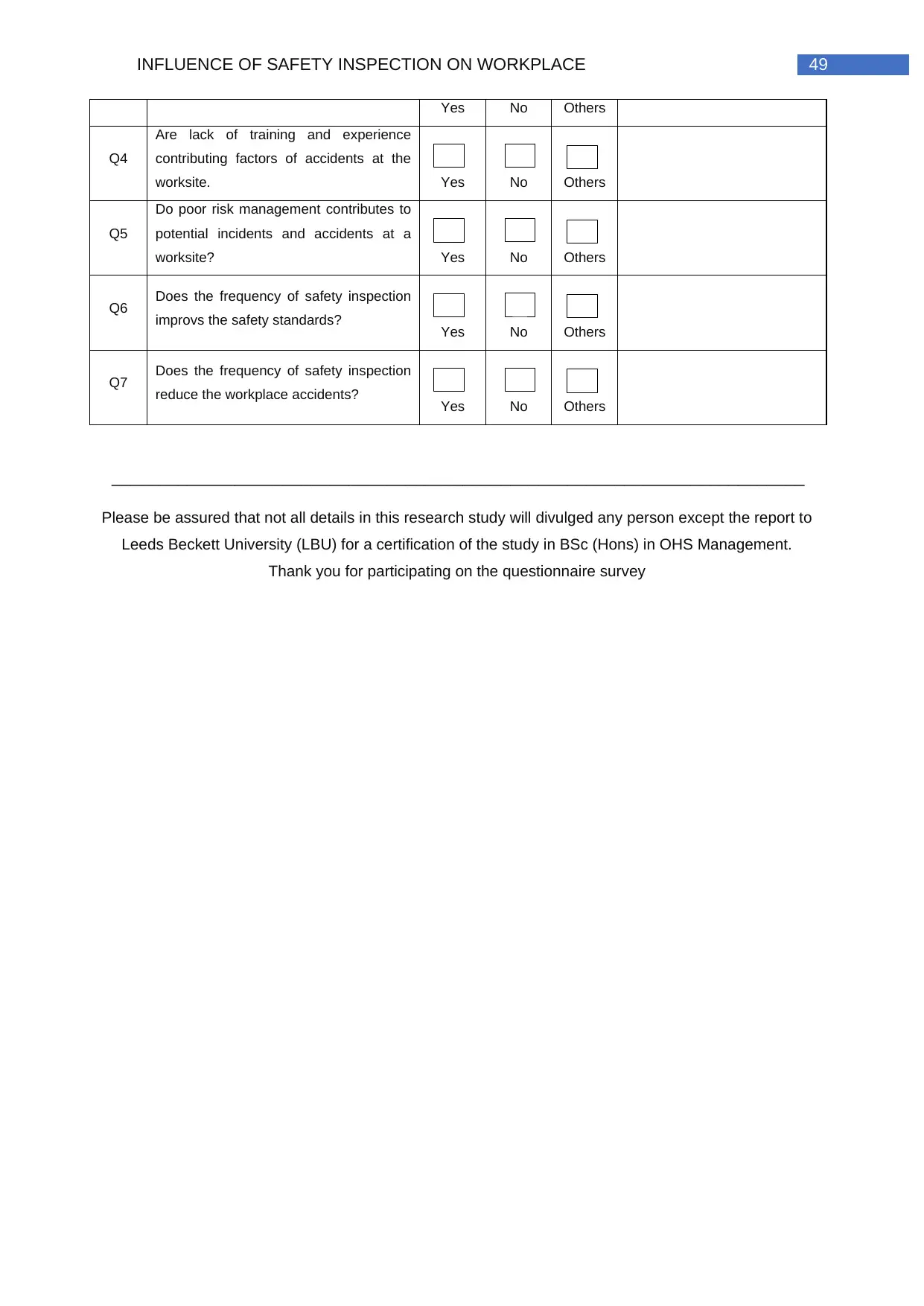
49INFLUENCE OF SAFETY INSPECTION ON WORKPLACE
Yes No Others
Q4
Are lack of training and experience
contributing factors of accidents at the
worksite. Yes No Others
Q5
Do poor risk management contributes to
potential incidents and accidents at a
worksite? Yes No Others
Q6 Does the frequency of safety inspection
improvs the safety standards? Yes No Others
Q7 Does the frequency of safety inspection
reduce the workplace accidents? Yes No Others
_________________________________________________________________________
Please be assured that not all details in this research study will divulged any person except the report to
Leeds Beckett University (LBU) for a certification of the study in BSc (Hons) in OHS Management.
Thank you for participating on the questionnaire survey
Yes No Others
Q4
Are lack of training and experience
contributing factors of accidents at the
worksite. Yes No Others
Q5
Do poor risk management contributes to
potential incidents and accidents at a
worksite? Yes No Others
Q6 Does the frequency of safety inspection
improvs the safety standards? Yes No Others
Q7 Does the frequency of safety inspection
reduce the workplace accidents? Yes No Others
_________________________________________________________________________
Please be assured that not all details in this research study will divulged any person except the report to
Leeds Beckett University (LBU) for a certification of the study in BSc (Hons) in OHS Management.
Thank you for participating on the questionnaire survey
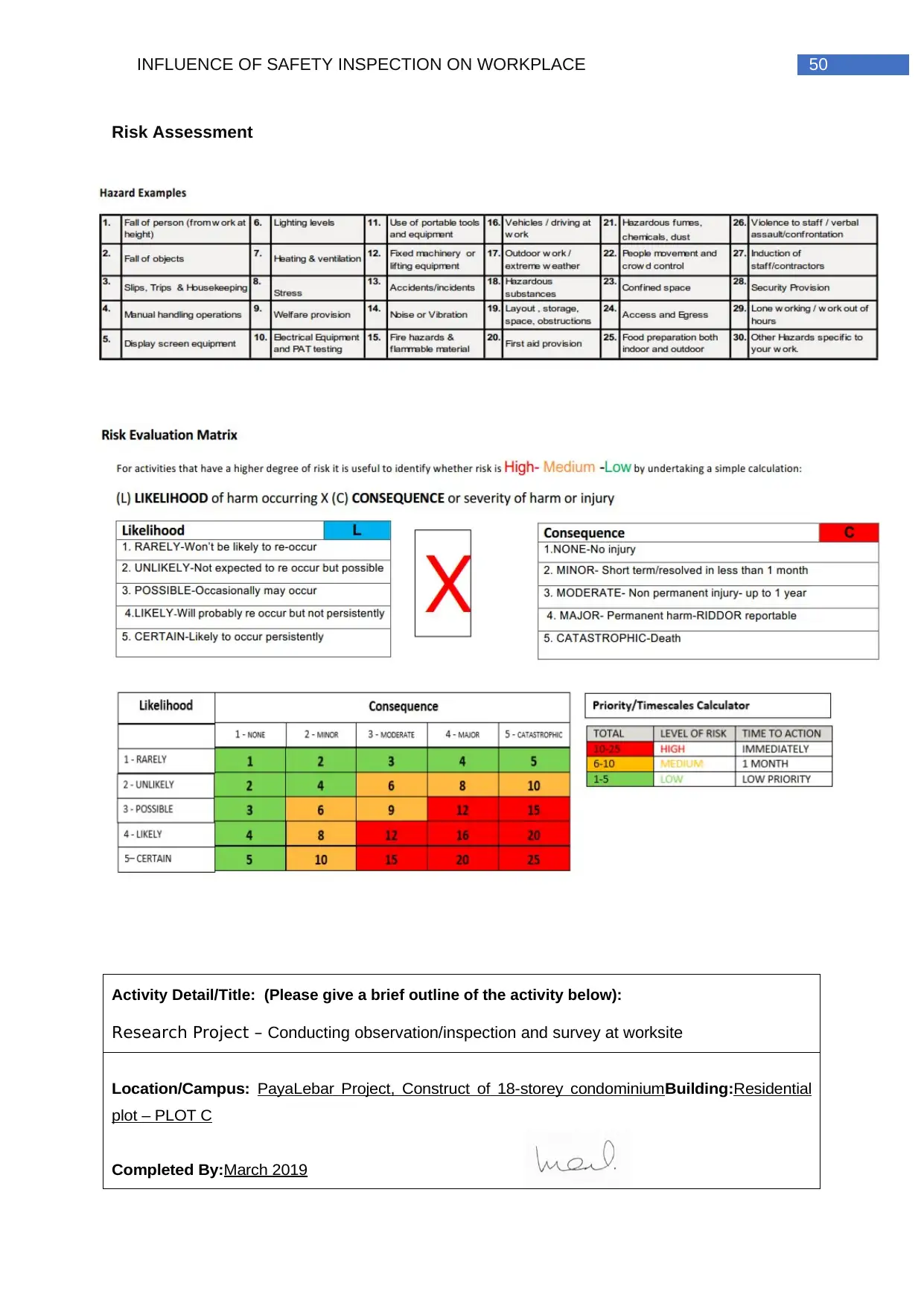
50INFLUENCE OF SAFETY INSPECTION ON WORKPLACE
Risk Assessment
Activity Detail/Title: (Please give a brief outline of the activity below):
Research Project – Conducting observation/inspection and survey at worksite
Location/Campus: PayaLebar Project, Construct of 18-storey condominiumBuilding:Residential
plot – PLOT C
Completed By:March 2019
Risk Assessment
Activity Detail/Title: (Please give a brief outline of the activity below):
Research Project – Conducting observation/inspection and survey at worksite
Location/Campus: PayaLebar Project, Construct of 18-storey condominiumBuilding:Residential
plot – PLOT C
Completed By:March 2019
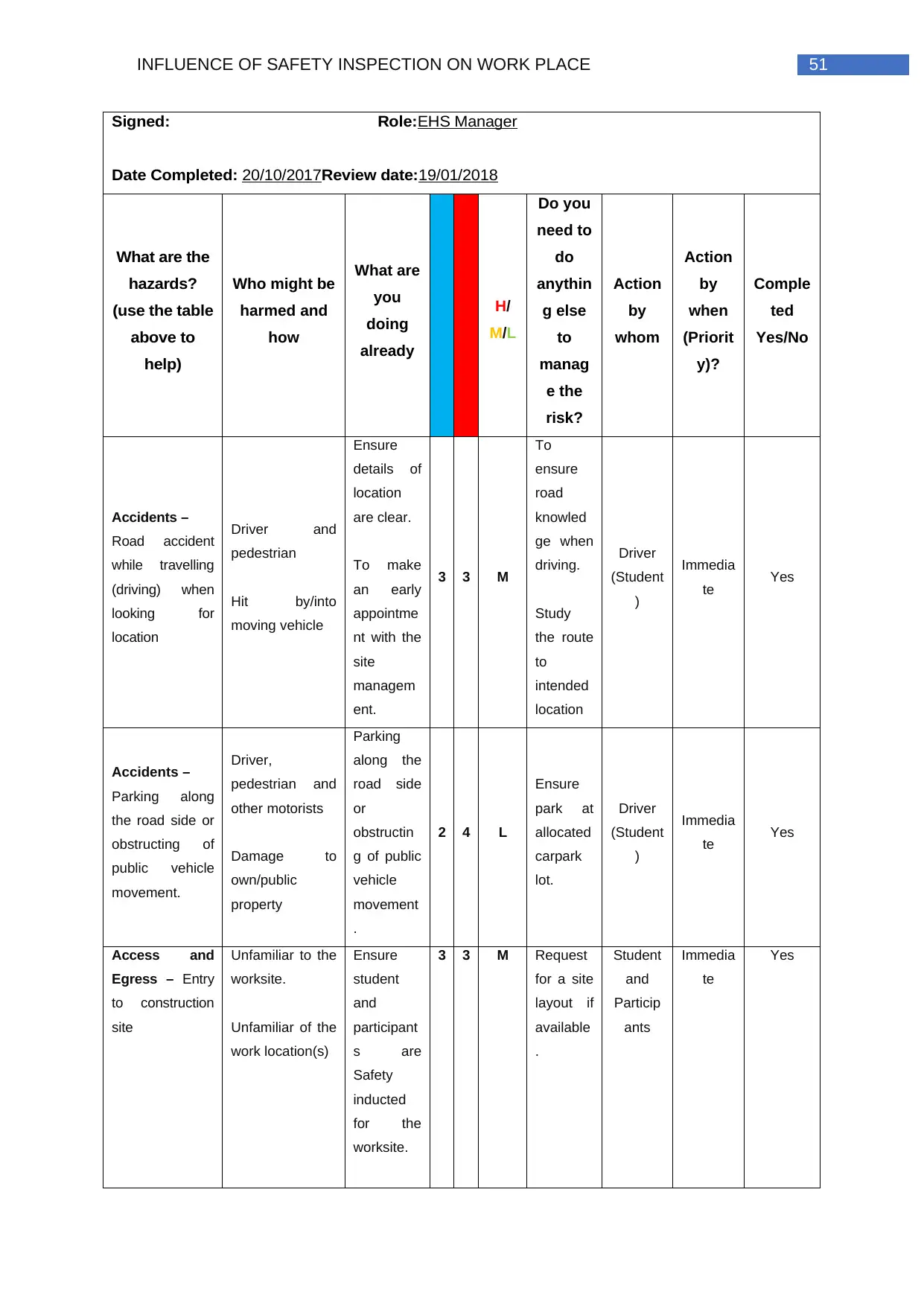
51INFLUENCE OF SAFETY INSPECTION ON WORK PLACE
Signed: Role:EHS Manager
Date Completed: 20/10/2017Review date:19/01/2018
What are the
hazards?
(use the table
above to
help)
Who might be
harmed and
how
What are
you
doing
already
H/
M/L
Do you
need to
do
anythin
g else
to
manag
e the
risk?
Action
by
whom
Action
by
when
(Priorit
y)?
Comple
ted
Yes/No
Accidents –
Road accident
while travelling
(driving) when
looking for
location
Driver and
pedestrian
Hit by/into
moving vehicle
Ensure
details of
location
are clear.
To make
an early
appointme
nt with the
site
managem
ent.
3 3 M
To
ensure
road
knowled
ge when
driving.
Study
the route
to
intended
location
Driver
(Student
)
Immedia
te Yes
Accidents –
Parking along
the road side or
obstructing of
public vehicle
movement.
Driver,
pedestrian and
other motorists
Damage to
own/public
property
Parking
along the
road side
or
obstructin
g of public
vehicle
movement
.
2 4 L
Ensure
park at
allocated
carpark
lot.
Driver
(Student
)
Immedia
te Yes
Access and
Egress – Entry
to construction
site
Unfamiliar to the
worksite.
Unfamiliar of the
work location(s)
Ensure
student
and
participant
s are
Safety
inducted
for the
worksite.
3 3 M Request
for a site
layout if
available
.
Student
and
Particip
ants
Immedia
te
Yes
Signed: Role:EHS Manager
Date Completed: 20/10/2017Review date:19/01/2018
What are the
hazards?
(use the table
above to
help)
Who might be
harmed and
how
What are
you
doing
already
H/
M/L
Do you
need to
do
anythin
g else
to
manag
e the
risk?
Action
by
whom
Action
by
when
(Priorit
y)?
Comple
ted
Yes/No
Accidents –
Road accident
while travelling
(driving) when
looking for
location
Driver and
pedestrian
Hit by/into
moving vehicle
Ensure
details of
location
are clear.
To make
an early
appointme
nt with the
site
managem
ent.
3 3 M
To
ensure
road
knowled
ge when
driving.
Study
the route
to
intended
location
Driver
(Student
)
Immedia
te Yes
Accidents –
Parking along
the road side or
obstructing of
public vehicle
movement.
Driver,
pedestrian and
other motorists
Damage to
own/public
property
Parking
along the
road side
or
obstructin
g of public
vehicle
movement
.
2 4 L
Ensure
park at
allocated
carpark
lot.
Driver
(Student
)
Immedia
te Yes
Access and
Egress – Entry
to construction
site
Unfamiliar to the
worksite.
Unfamiliar of the
work location(s)
Ensure
student
and
participant
s are
Safety
inducted
for the
worksite.
3 3 M Request
for a site
layout if
available
.
Student
and
Particip
ants
Immedia
te
Yes
Secure Best Marks with AI Grader
Need help grading? Try our AI Grader for instant feedback on your assignments.
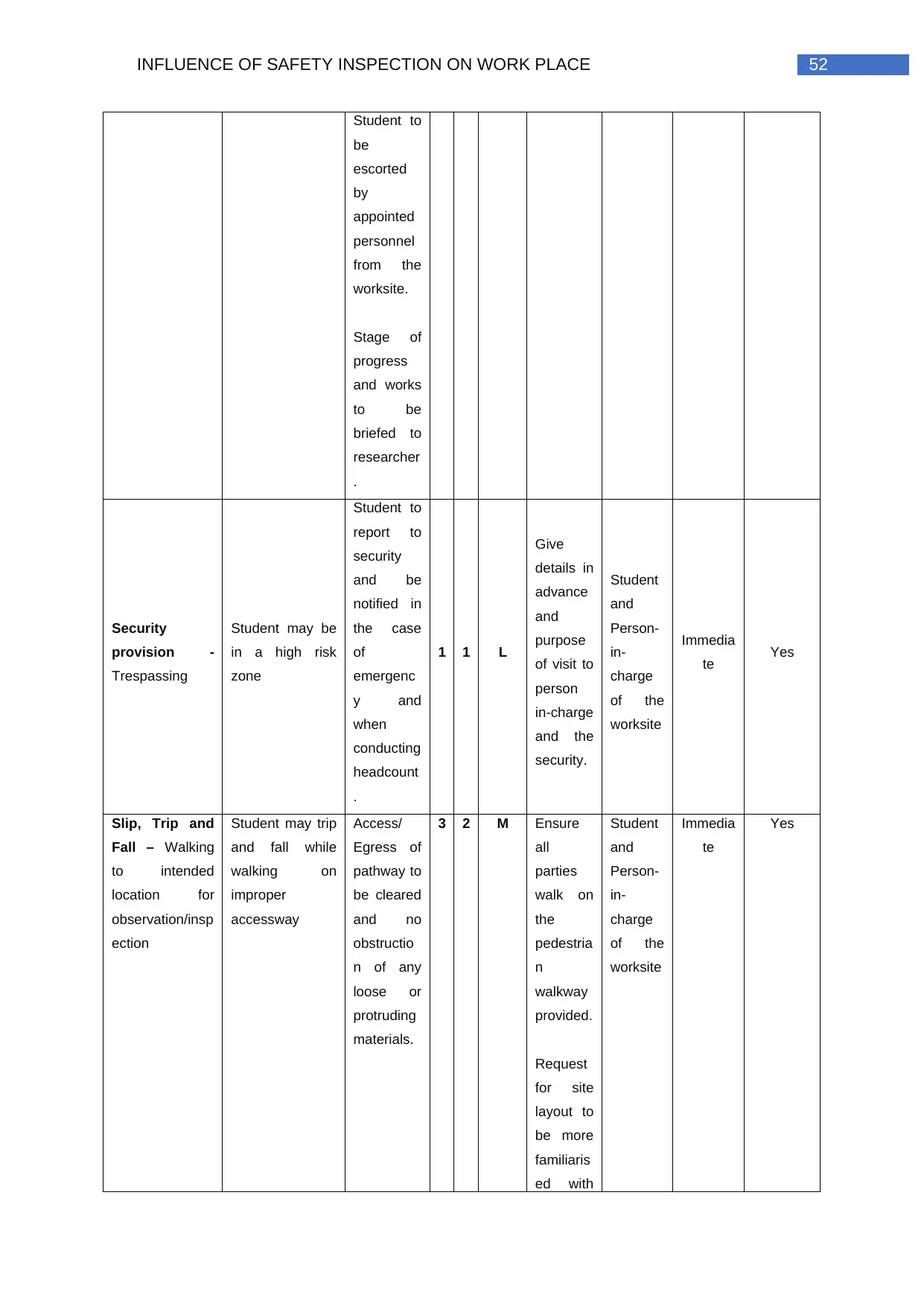
52INFLUENCE OF SAFETY INSPECTION ON WORK PLACE
Student to
be
escorted
by
appointed
personnel
from the
worksite.
Stage of
progress
and works
to be
briefed to
researcher
.
Security
provision -
Trespassing
Student may be
in a high risk
zone
Student to
report to
security
and be
notified in
the case
of
emergenc
y and
when
conducting
headcount
.
1 1 L
Give
details in
advance
and
purpose
of visit to
person
in-charge
and the
security.
Student
and
Person-
in-
charge
of the
worksite
Immedia
te Yes
Slip, Trip and
Fall – Walking
to intended
location for
observation/insp
ection
Student may trip
and fall while
walking on
improper
accessway
Access/
Egress of
pathway to
be cleared
and no
obstructio
n of any
loose or
protruding
materials.
3 2 M Ensure
all
parties
walk on
the
pedestria
n
walkway
provided.
Request
for site
layout to
be more
familiaris
ed with
Student
and
Person-
in-
charge
of the
worksite
Immedia
te
Yes
Student to
be
escorted
by
appointed
personnel
from the
worksite.
Stage of
progress
and works
to be
briefed to
researcher
.
Security
provision -
Trespassing
Student may be
in a high risk
zone
Student to
report to
security
and be
notified in
the case
of
emergenc
y and
when
conducting
headcount
.
1 1 L
Give
details in
advance
and
purpose
of visit to
person
in-charge
and the
security.
Student
and
Person-
in-
charge
of the
worksite
Immedia
te Yes
Slip, Trip and
Fall – Walking
to intended
location for
observation/insp
ection
Student may trip
and fall while
walking on
improper
accessway
Access/
Egress of
pathway to
be cleared
and no
obstructio
n of any
loose or
protruding
materials.
3 2 M Ensure
all
parties
walk on
the
pedestria
n
walkway
provided.
Request
for site
layout to
be more
familiaris
ed with
Student
and
Person-
in-
charge
of the
worksite
Immedia
te
Yes
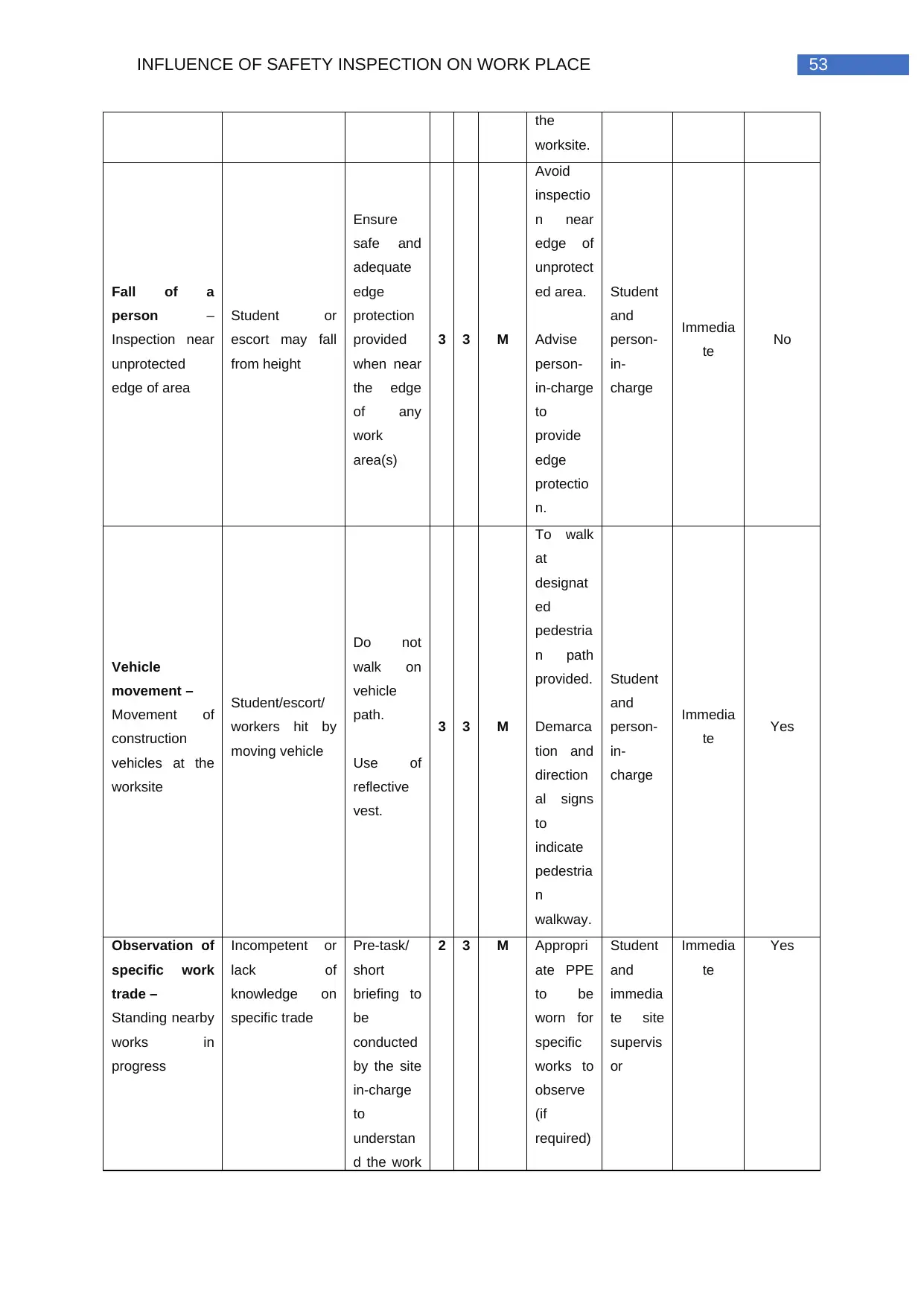
53INFLUENCE OF SAFETY INSPECTION ON WORK PLACE
the
worksite.
Fall of a
person –
Inspection near
unprotected
edge of area
Student or
escort may fall
from height
Ensure
safe and
adequate
edge
protection
provided
when near
the edge
of any
work
area(s)
3 3 M
Avoid
inspectio
n near
edge of
unprotect
ed area.
Advise
person-
in-charge
to
provide
edge
protectio
n.
Student
and
person-
in-
charge
Immedia
te No
Vehicle
movement –
Movement of
construction
vehicles at the
worksite
Student/escort/
workers hit by
moving vehicle
Do not
walk on
vehicle
path.
Use of
reflective
vest.
3 3 M
To walk
at
designat
ed
pedestria
n path
provided.
Demarca
tion and
direction
al signs
to
indicate
pedestria
n
walkway.
Student
and
person-
in-
charge
Immedia
te Yes
Observation of
specific work
trade –
Standing nearby
works in
progress
Incompetent or
lack of
knowledge on
specific trade
Pre-task/
short
briefing to
be
conducted
by the site
in-charge
to
understan
d the work
2 3 M Appropri
ate PPE
to be
worn for
specific
works to
observe
(if
required)
Student
and
immedia
te site
supervis
or
Immedia
te
Yes
the
worksite.
Fall of a
person –
Inspection near
unprotected
edge of area
Student or
escort may fall
from height
Ensure
safe and
adequate
edge
protection
provided
when near
the edge
of any
work
area(s)
3 3 M
Avoid
inspectio
n near
edge of
unprotect
ed area.
Advise
person-
in-charge
to
provide
edge
protectio
n.
Student
and
person-
in-
charge
Immedia
te No
Vehicle
movement –
Movement of
construction
vehicles at the
worksite
Student/escort/
workers hit by
moving vehicle
Do not
walk on
vehicle
path.
Use of
reflective
vest.
3 3 M
To walk
at
designat
ed
pedestria
n path
provided.
Demarca
tion and
direction
al signs
to
indicate
pedestria
n
walkway.
Student
and
person-
in-
charge
Immedia
te Yes
Observation of
specific work
trade –
Standing nearby
works in
progress
Incompetent or
lack of
knowledge on
specific trade
Pre-task/
short
briefing to
be
conducted
by the site
in-charge
to
understan
d the work
2 3 M Appropri
ate PPE
to be
worn for
specific
works to
observe
(if
required)
Student
and
immedia
te site
supervis
or
Immedia
te
Yes
1 out of 54
Related Documents
Your All-in-One AI-Powered Toolkit for Academic Success.
+13062052269
info@desklib.com
Available 24*7 on WhatsApp / Email
![[object Object]](/_next/static/media/star-bottom.7253800d.svg)
Unlock your academic potential
© 2024 | Zucol Services PVT LTD | All rights reserved.




